Nothing seems to change paradigms about wild food faster than seeing a dish garnished with edible wildflowers. The sheer variety of shapes, textures, colors, flavors and uses are incredible. Without further ado, here's a list of over 40 edible, truly wild flowers, with a brief background on each. If you think of any I've missed, please leave a comment.
Milkweed
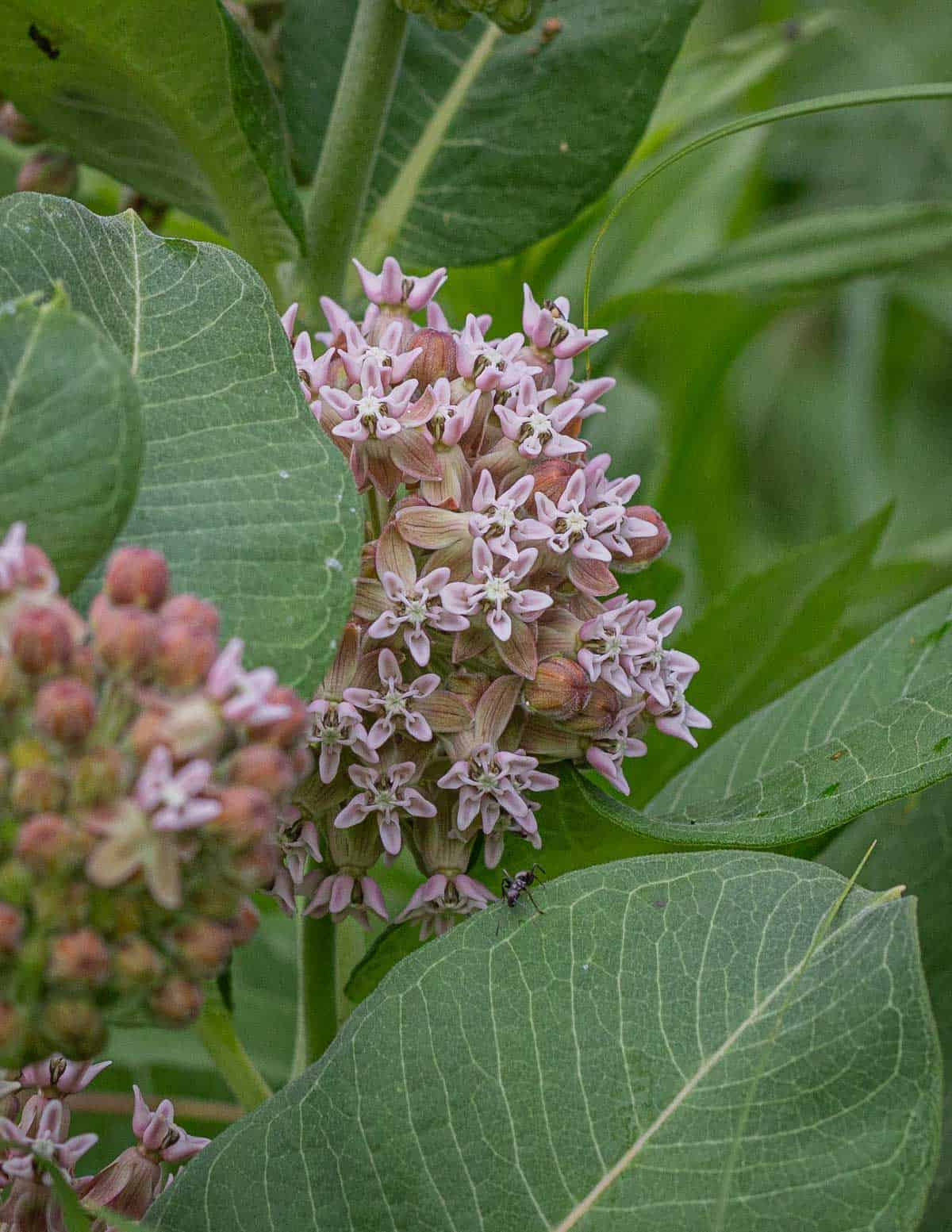
Common milkweed (Asclepias syriaca) and showy milkweed (Asclepias speciosa) are two of the best edible flowers I know. The smell is fruity and intense, and the color adds am attractive touch of purple to sweet or savory dishes.
The aroma can be used to infuse drinks like milkweed shrub or syrup that makes summer punch taste like watermelon jolly ranchers. They make a brilliant red vinegar (pictured below) and an interesting soup vegetable.
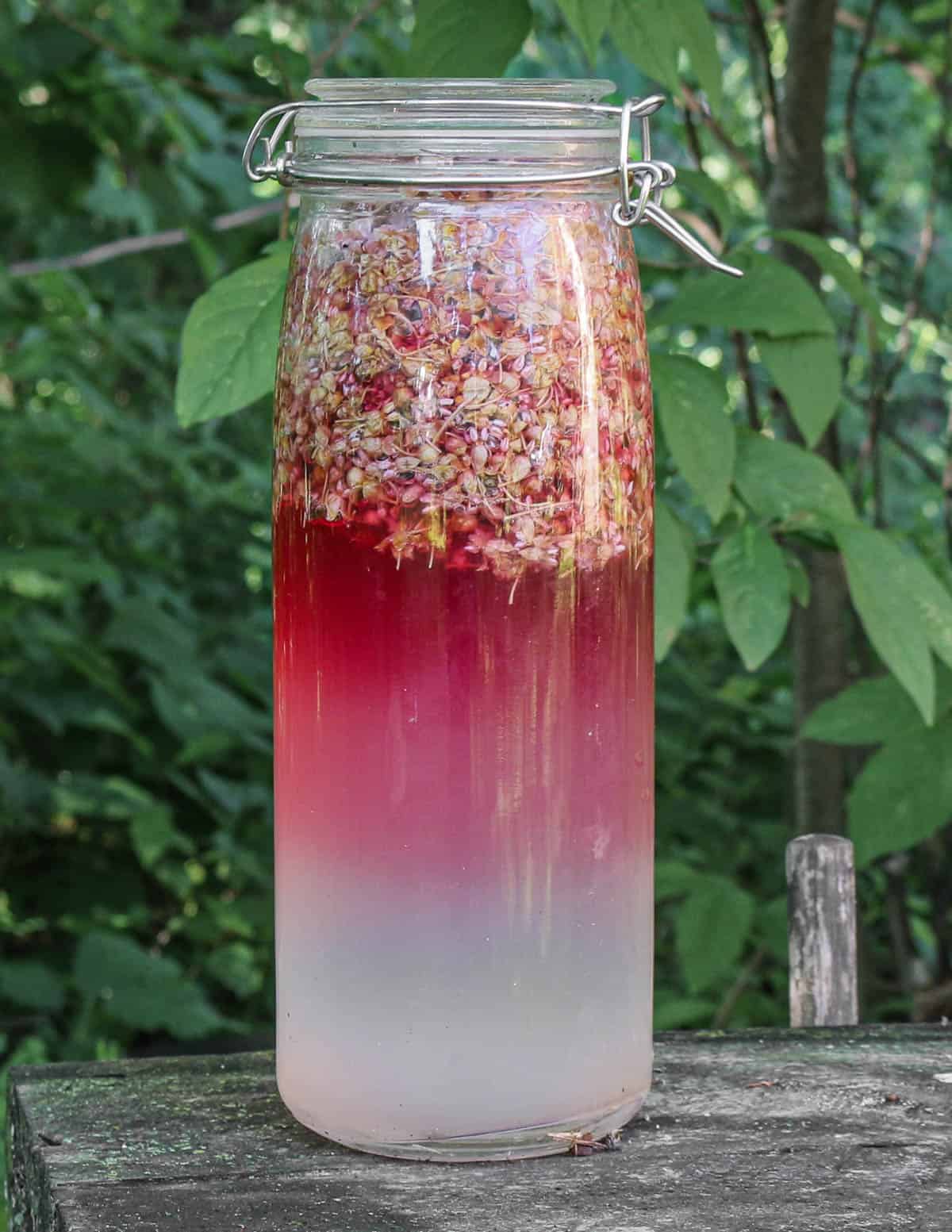
Below: white poke milkweed flowers (Asclepias exaltata) are edible too, but lack the intense fruitiness of their cousins and I harvest them sparingly.
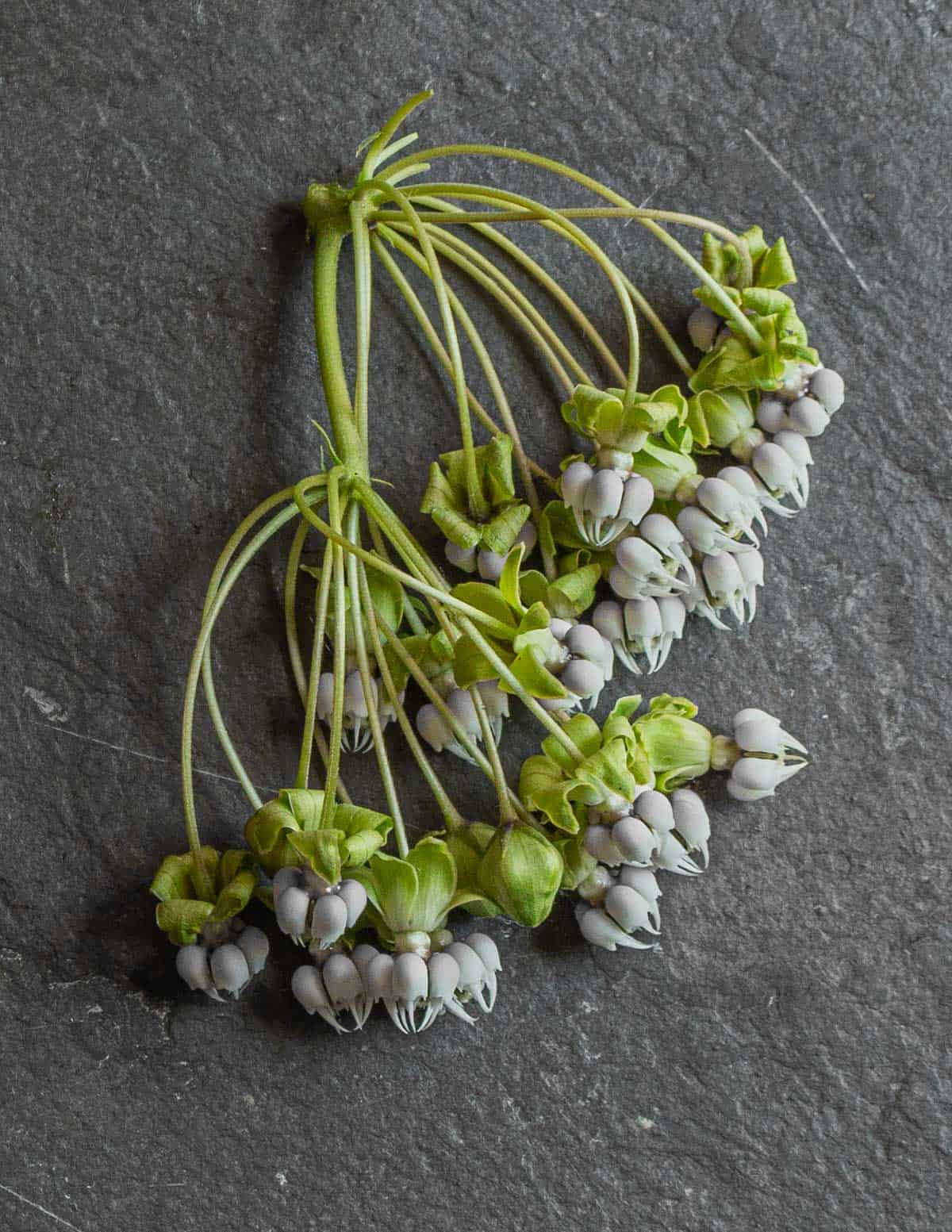
While both common milkweed, showy milkweed, and poke milkweed flowers are edible, they must be used in small amounts when consumed raw-a sprinkle is all you need. No other milkweed flowers should be used raw or cooked and can make you sick.
Creeping Bellflower

Creeping bellflower, also known by the delicious name hairbell and Campanula rapunculoides are a common garden weed. The pretty purple flowers always get compliments when I serve them to people and they have a neutral taste that makes them good for both savory and sweet dishes. Mine are usually ready in July.
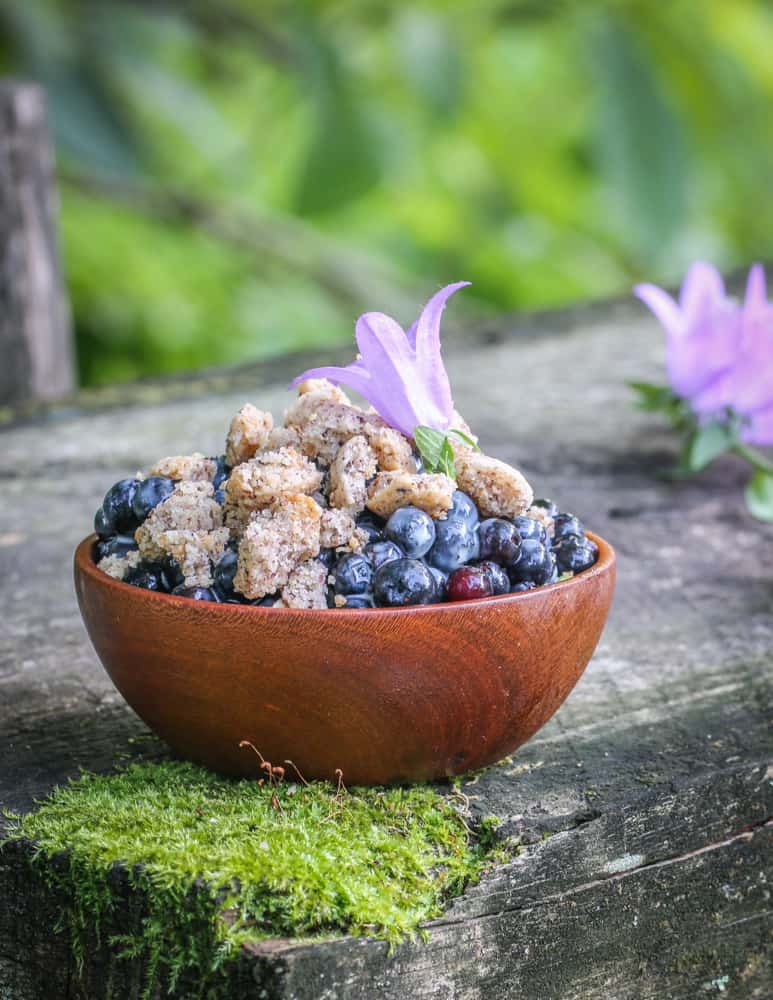
C. rapunculoides is only one of a number of related plants that will make similar edible flowers. The French harvest campanula roots and cook them like carrots.
Spring Beauty
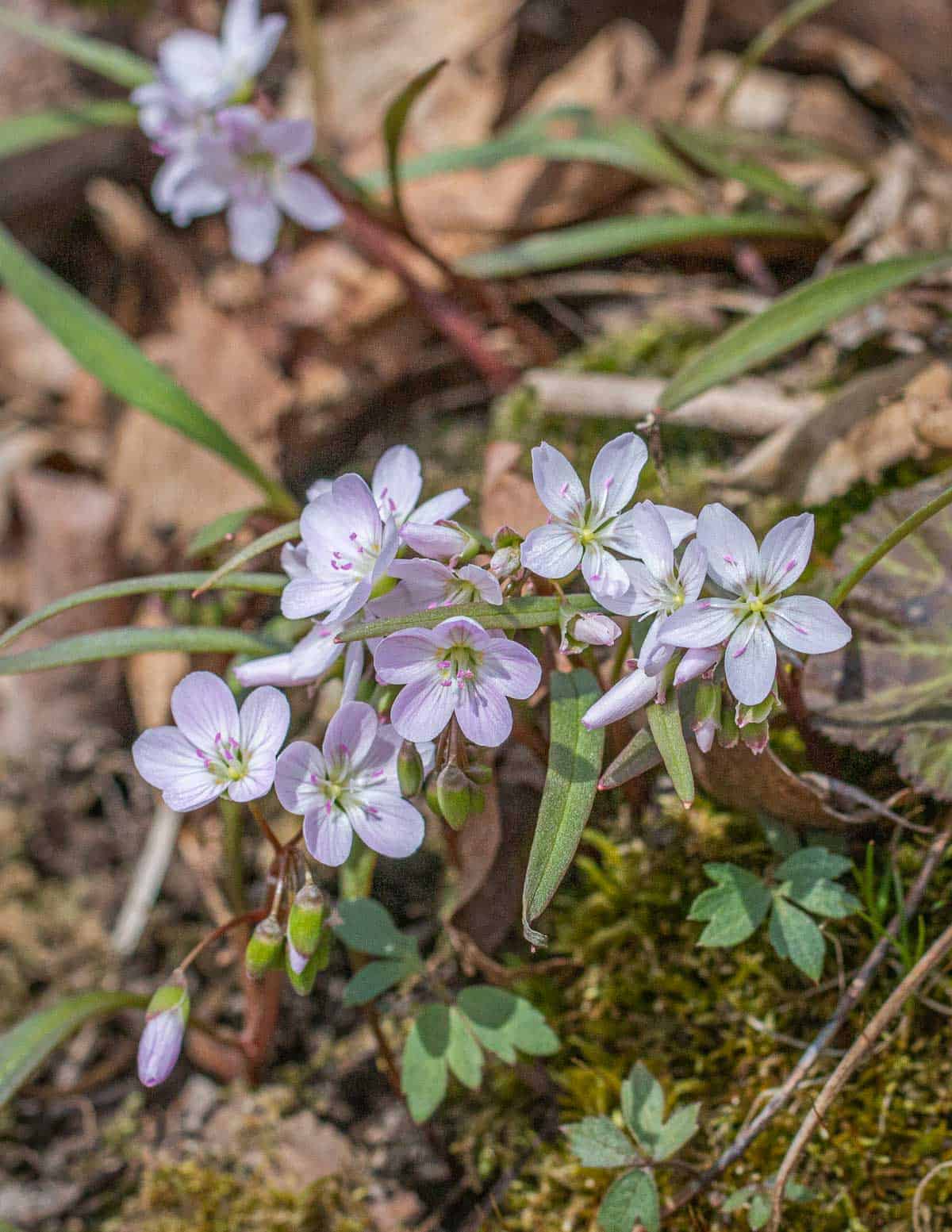
Spring beauty (Claytonia virginica) is a spring ephemeral that loves to grow in maple sugar bush forest with ramps, toothwort and others. It's related to miners lettuce and has a similar mild, grassy flavor.
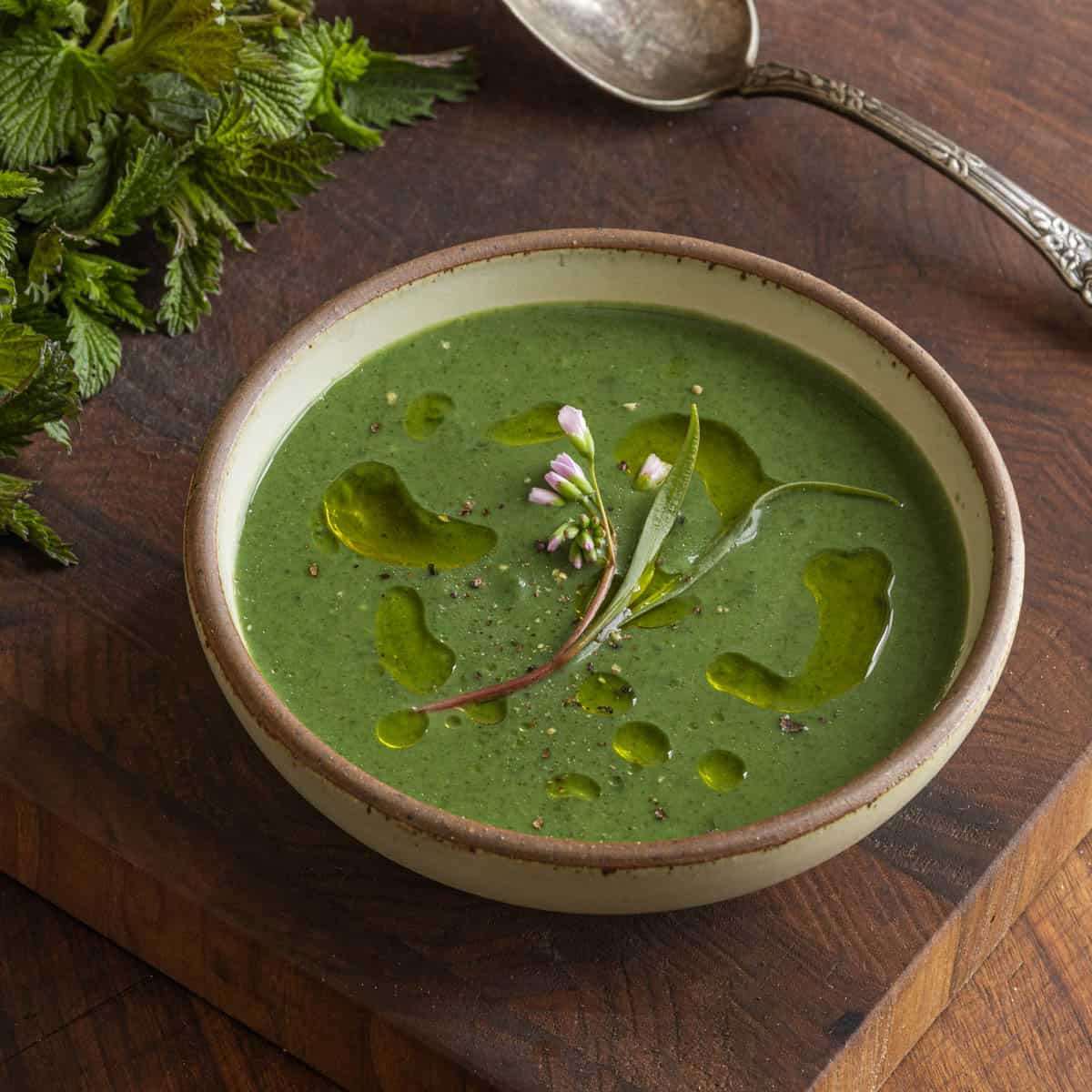
Unlike most of the other flowers in this post, the entire stem and leaves should be eaten as a small raw vegetable as it would be impractical to remove the flowers. It's succulent texture is excellent in salads or lightly dressed as a garnish. They're available in May.
Toothwort
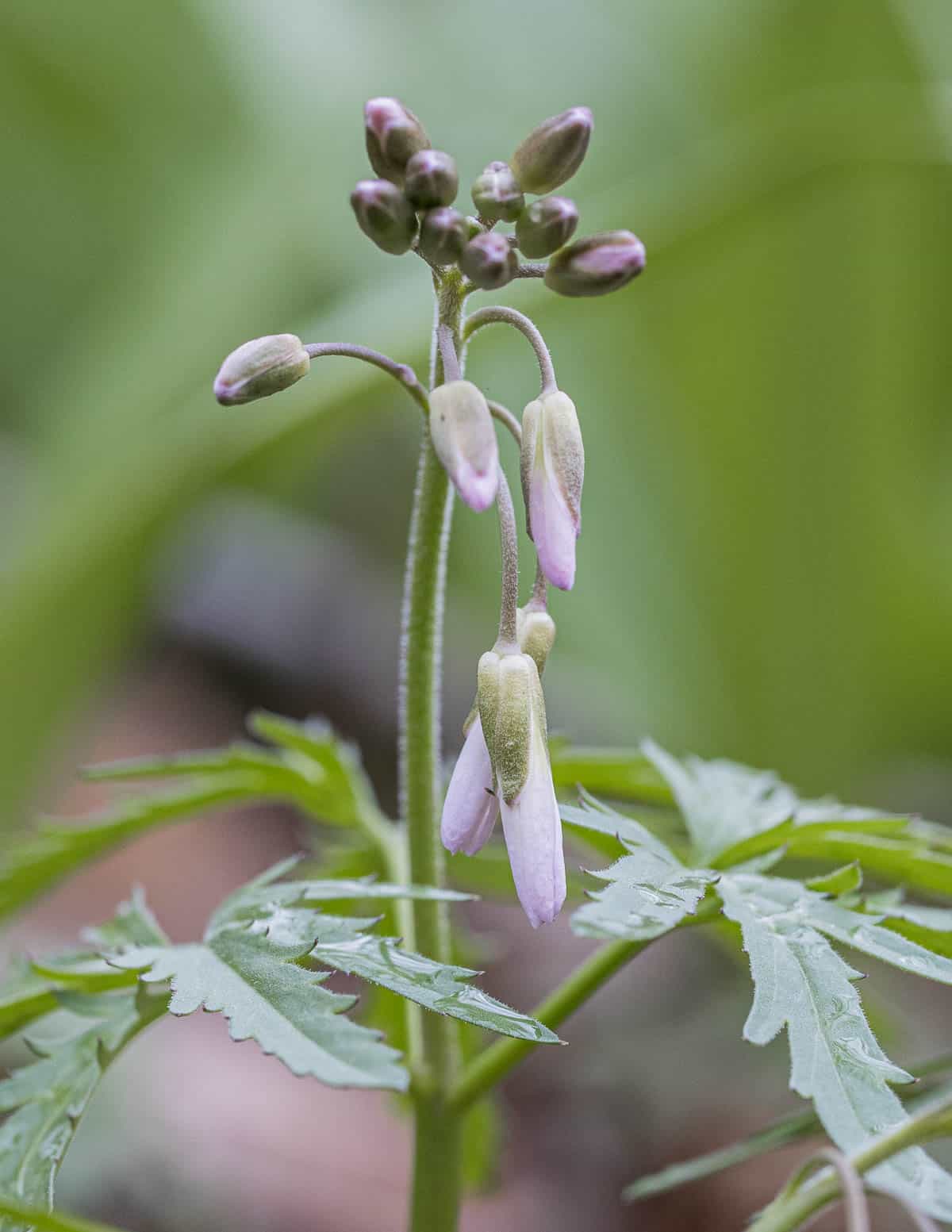
Cut leaf toothwort (Cardamine concontenata) is another spring ephemeral, and a common sight in maple sugar bush forest alongside ramps, trout lily and spring beauty.
There's a few other varieties besides C. concontenata, like C. diphylla, which has large rhizomes that can be made into a horseradish substitute.
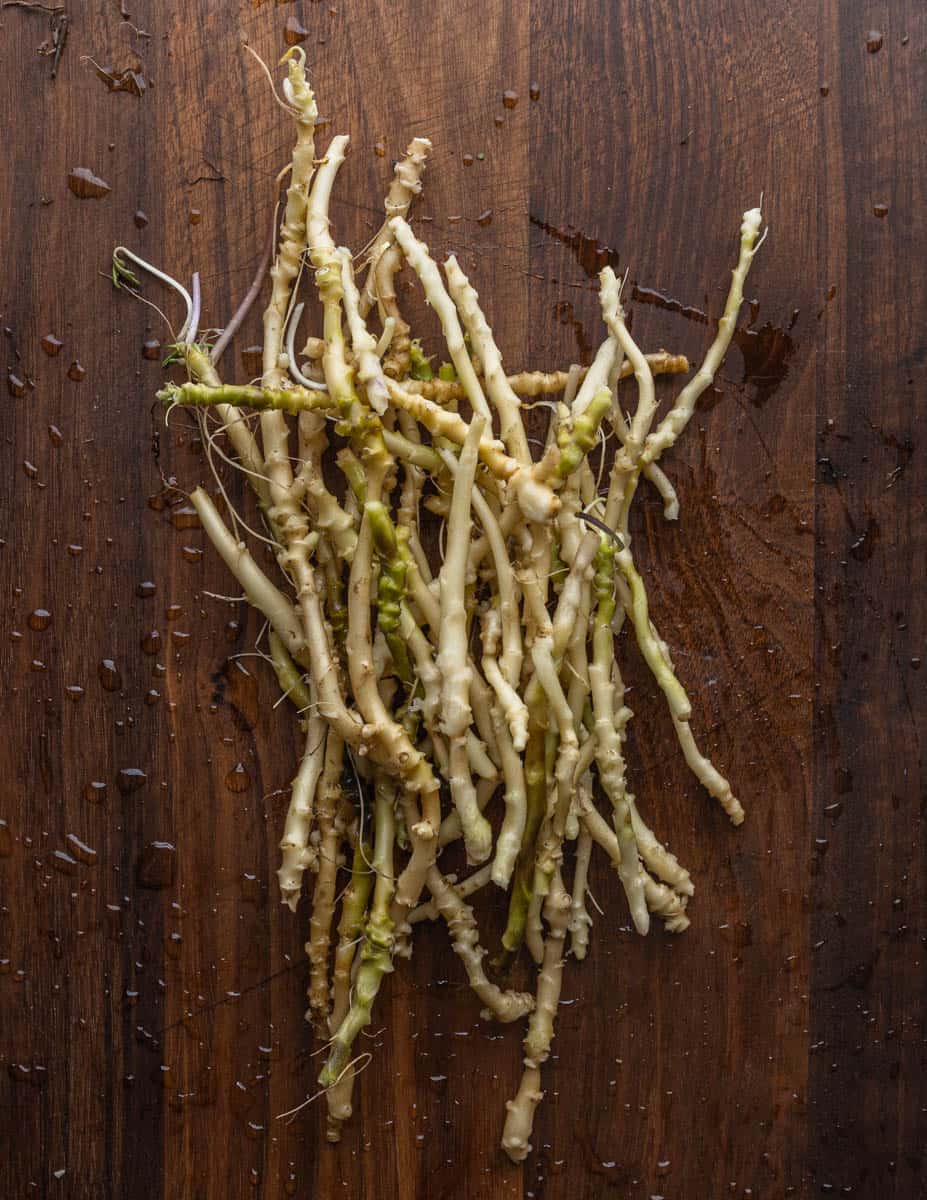
The flowers are small and delicate, and I usually leave them attached to the plant if I add them to a dish. Like the green leafy parts, they have a spicy, bitter flavor reminiscent of horseradish. Pictured below on goat tartare.
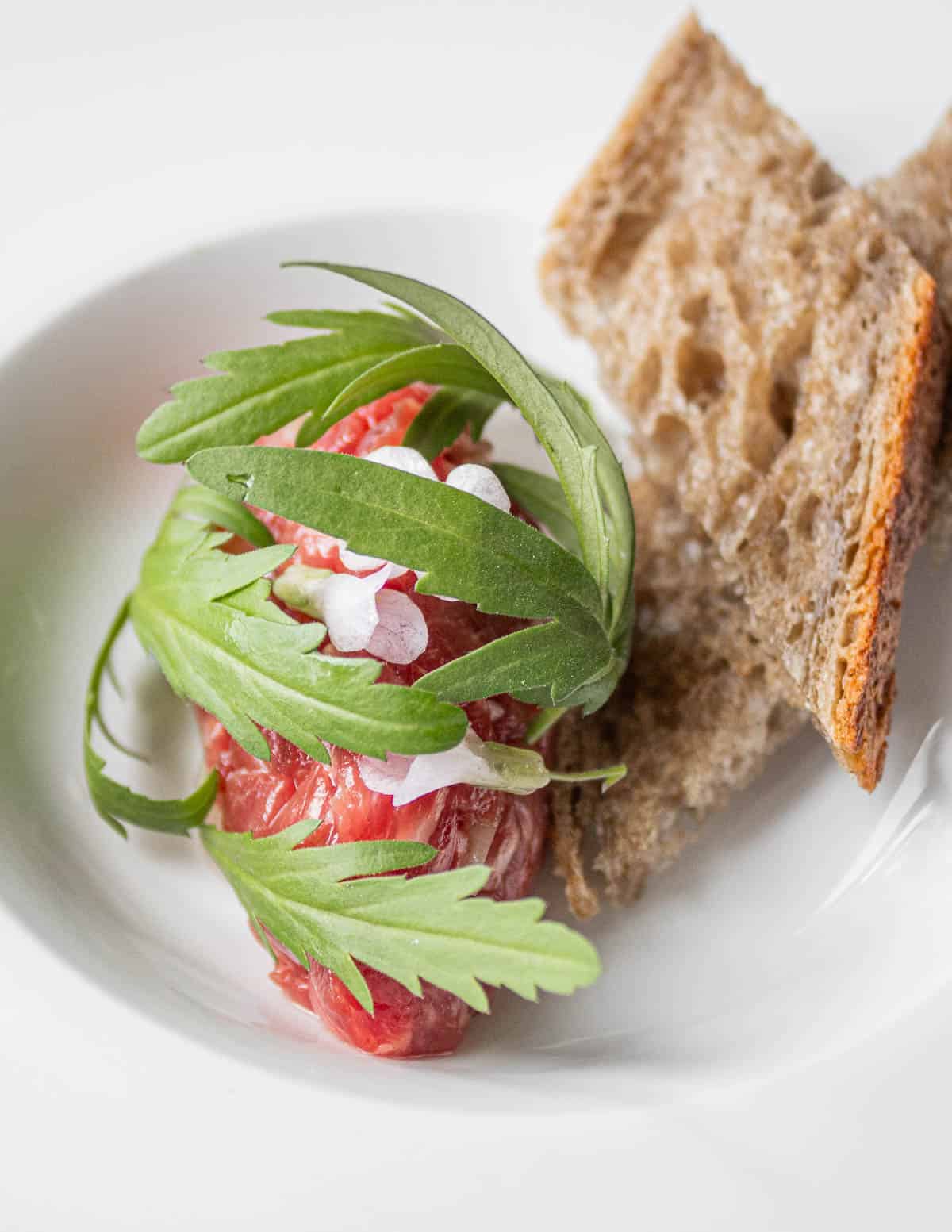
Trout Lilies
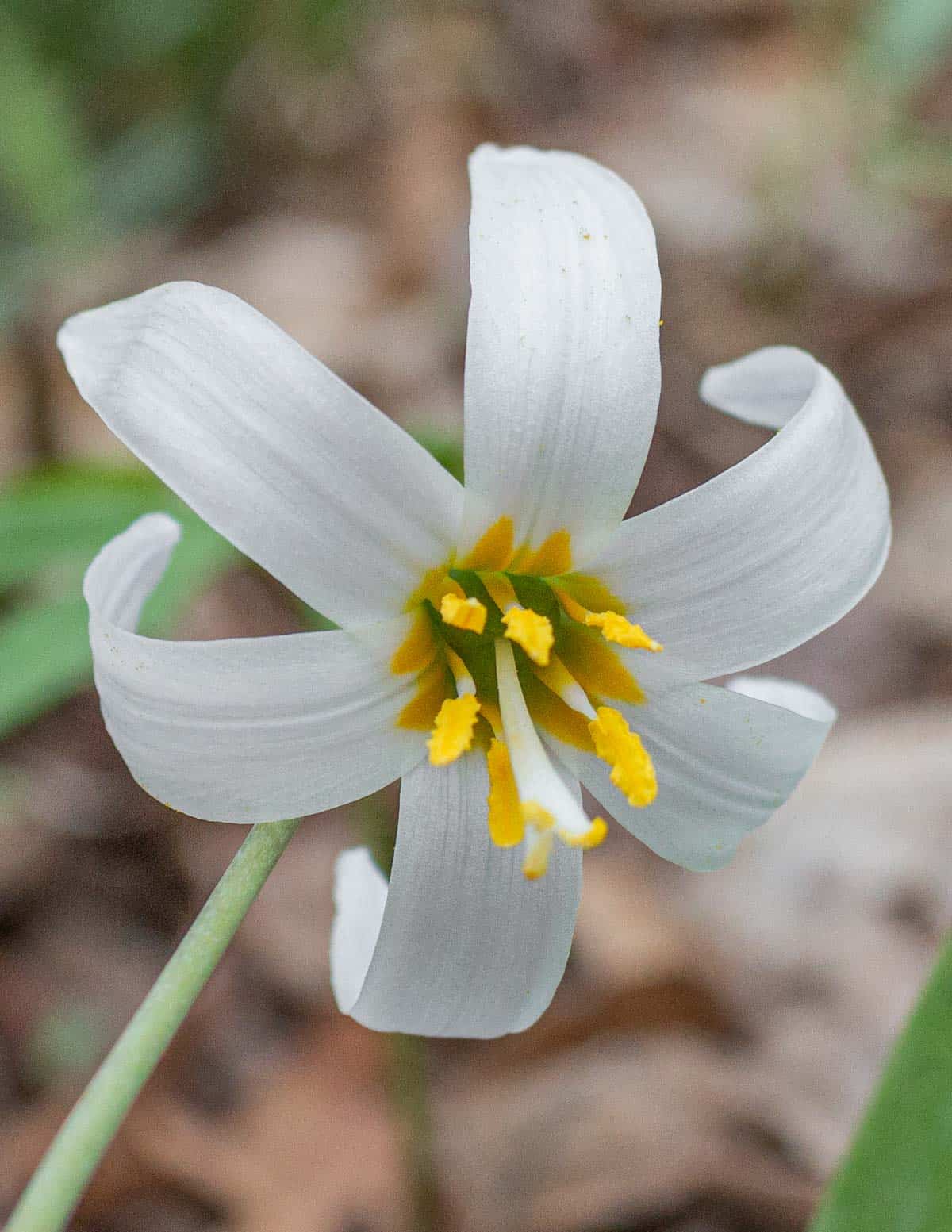
A spring ephemeral common in areas with ramps like maple sugar bush forest, trout lily flowers (Erythronium) can come in a few different colors.
They have a mild flavor and can be used to garnish sweet or savory dishes like the wild garlic soup, pictured below. Look for them in Late April through May.
I typically see Erythronium americanum. It's important to know that Erythronium propullans is endangered in Minnesota and Federally protected. I have never seen it, personally.
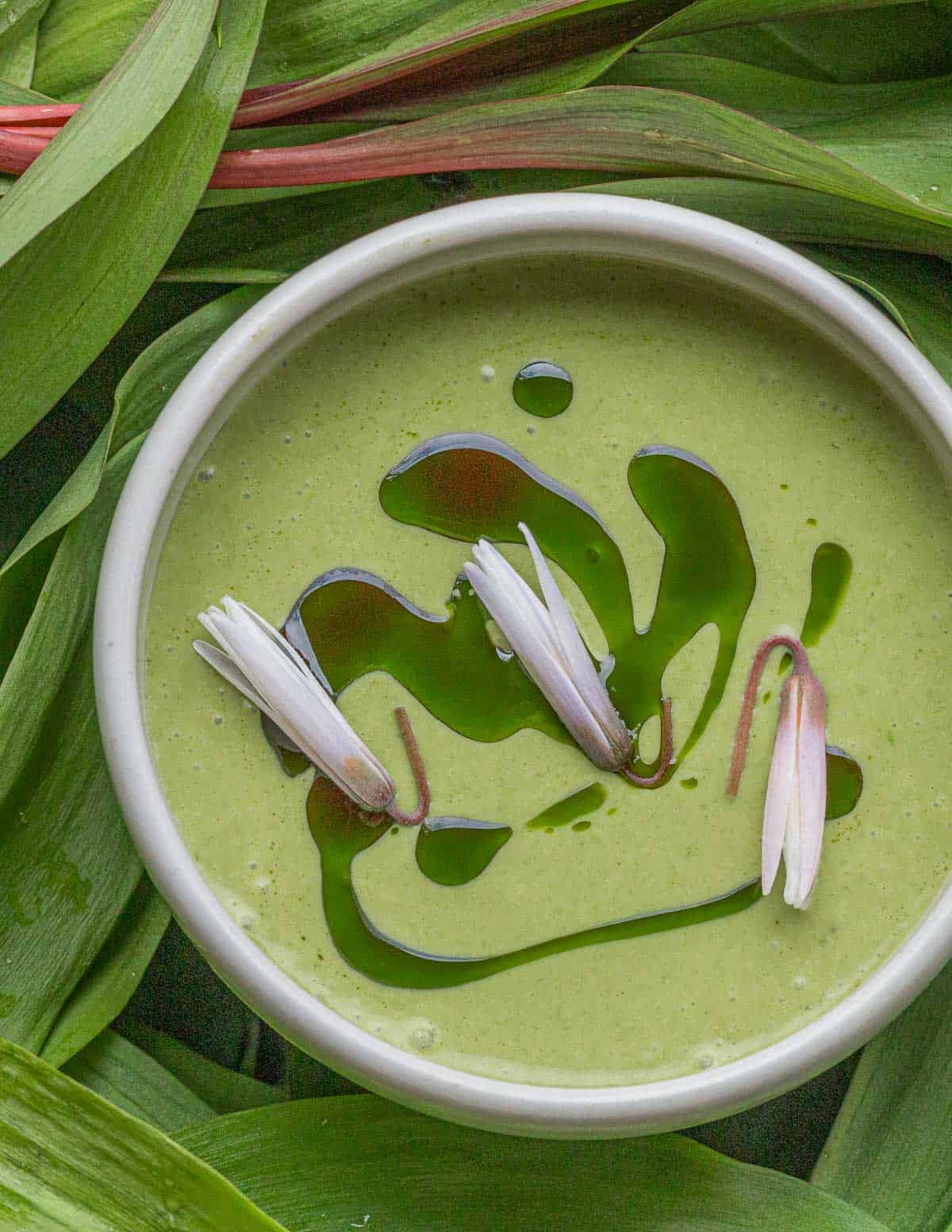
Just like the leaves of the plant, trout lily flowers should be used in moderation. Only put on or two on a dish as large amounts can cause digestive upset in some people.
Virginia Waterleaf
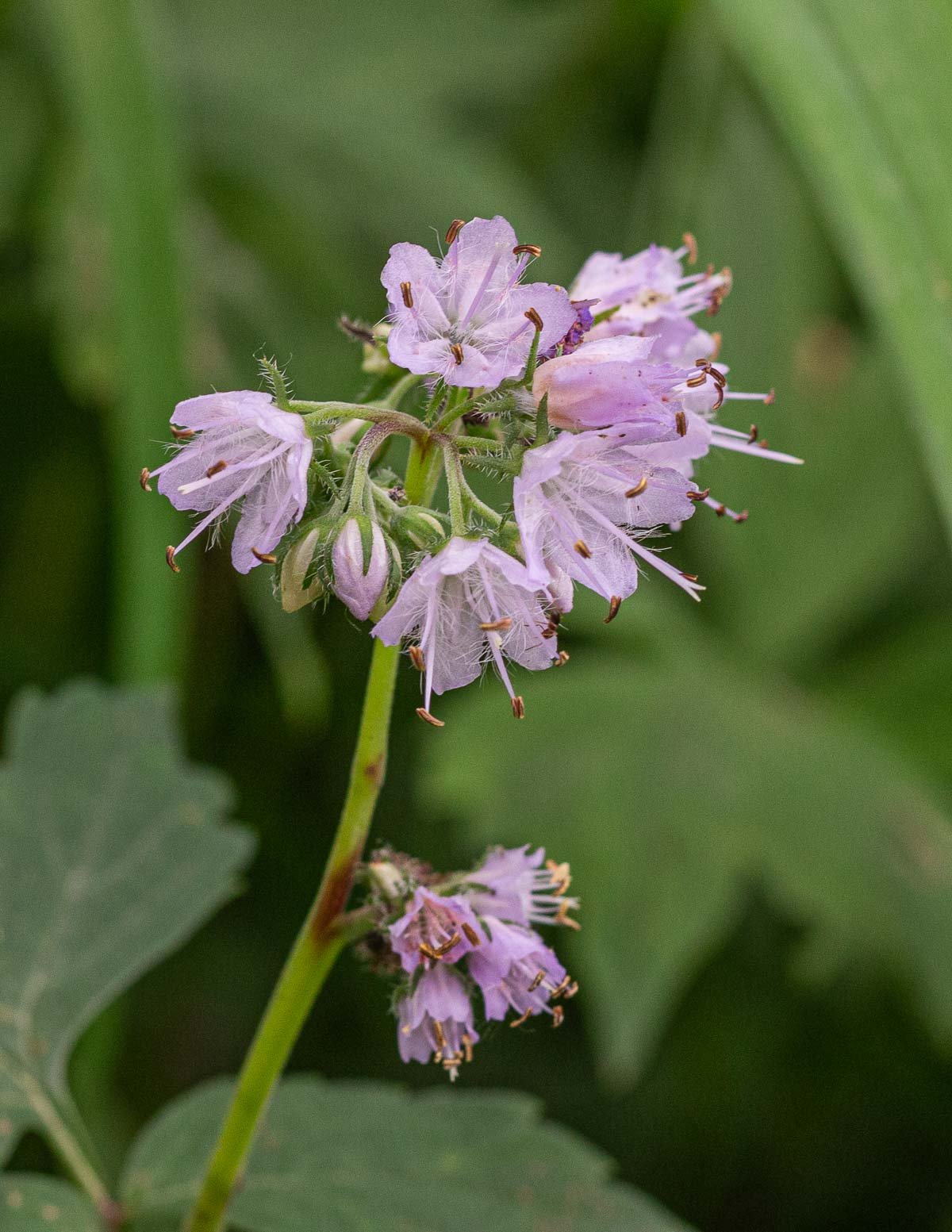
Virginia waterleaf is kind of a spring ephemeral. While it appears in the early spring, it stays around longer than the others, persisting throughout the year, especially if it gets mowed.
The flowers are delicate, but can make a nice addition to salads and sprinkled on dishes when they're available in May. The whole plant is edible and the greens can be decent cooked in a blend of plants.
Virginia Bluebells
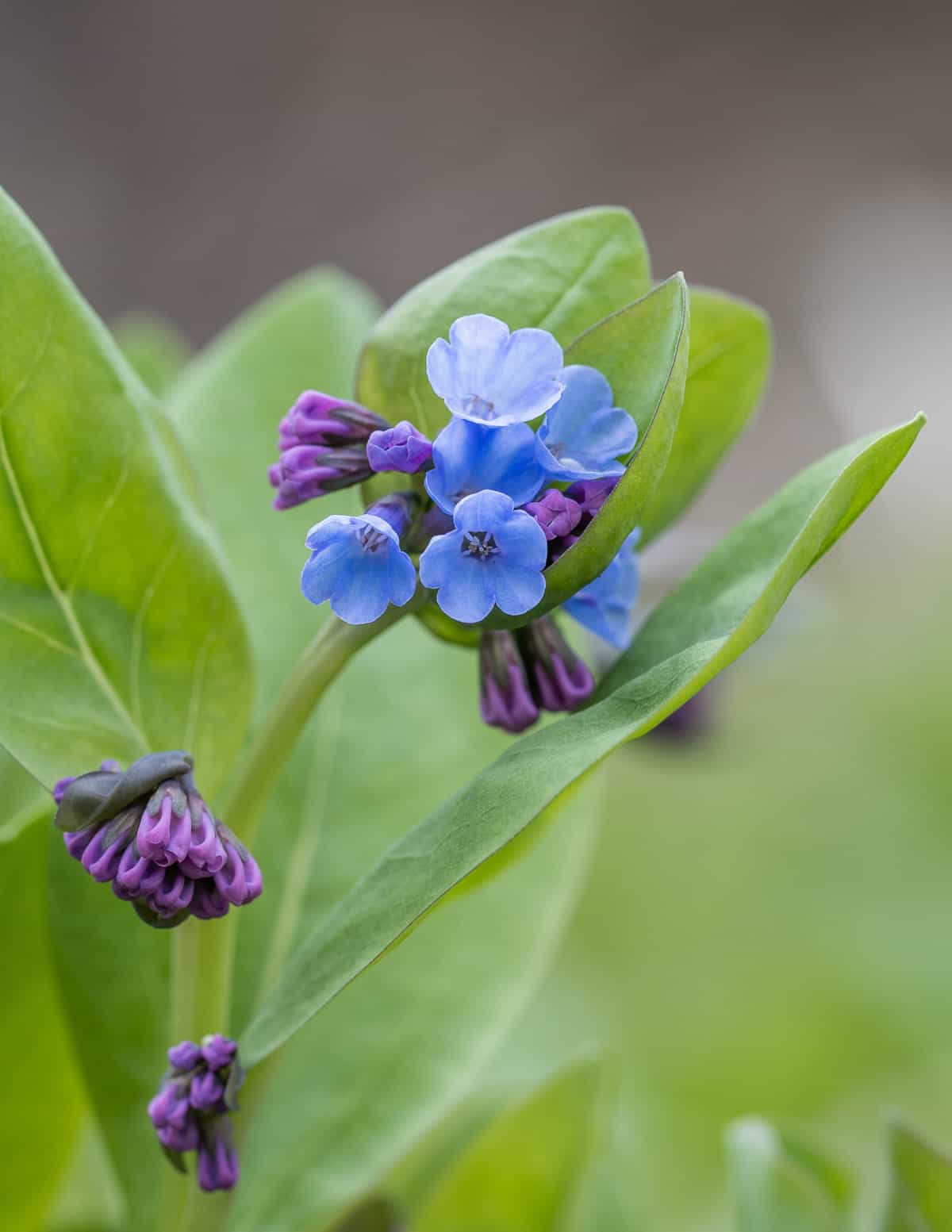
A cousin of borage, and in the same family (Boraginaceae), Virginia bluebells (Mertensia virginica) as well as their cousin Mertensia maritima are edible and delicious. M. maritima is a traditional food in Alaska.
The whole plants can be eaten. The young leaves and tender stems can be cooked like spinach or eaten raw in salads. Below they're served in a rich mushroom broth. Look for them in early to Mid April.
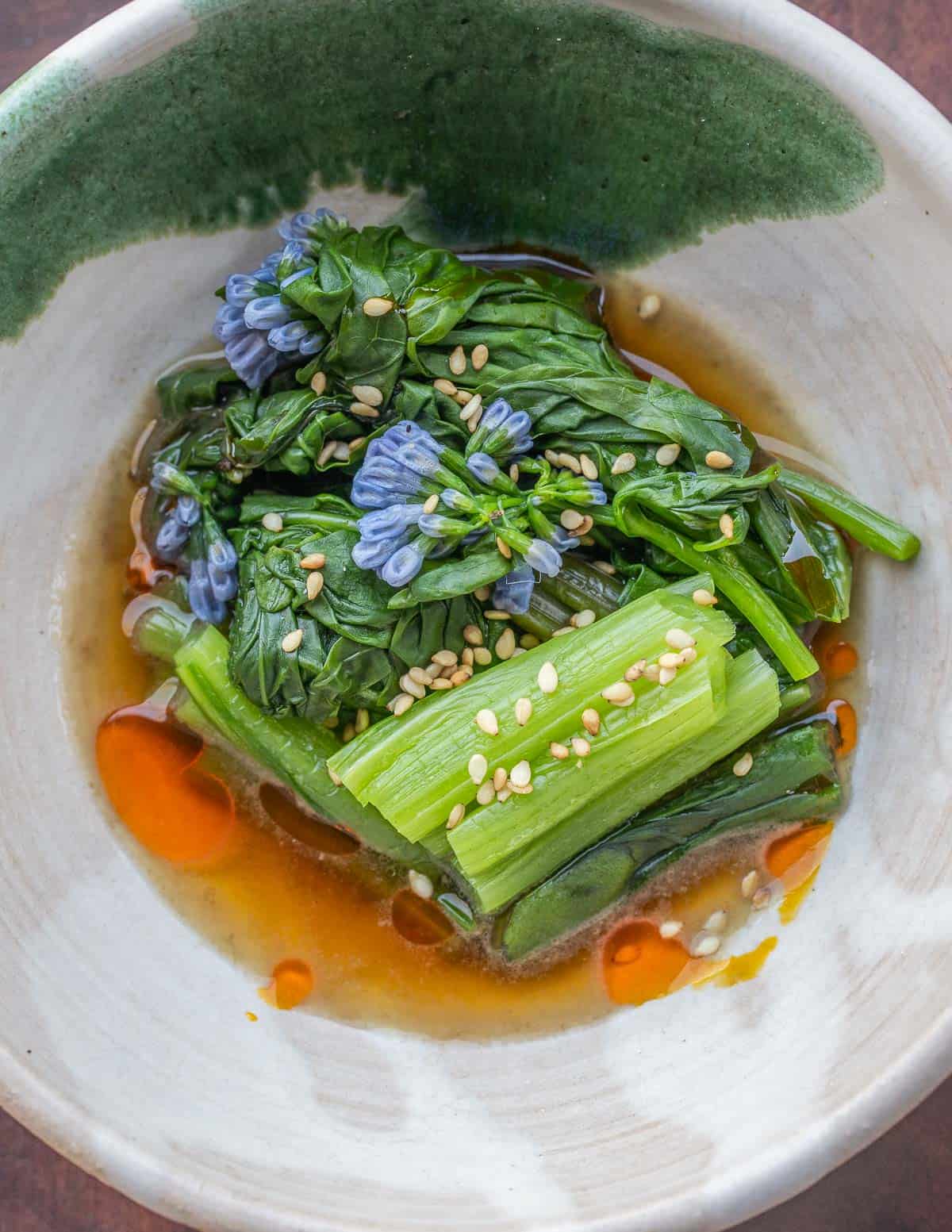
A great example of the importance of Latin names, it's important to know that if you're in Britain, Hyacinthoides non-scripta is also called the common bluebell, and is poisonous.
Wild Roses
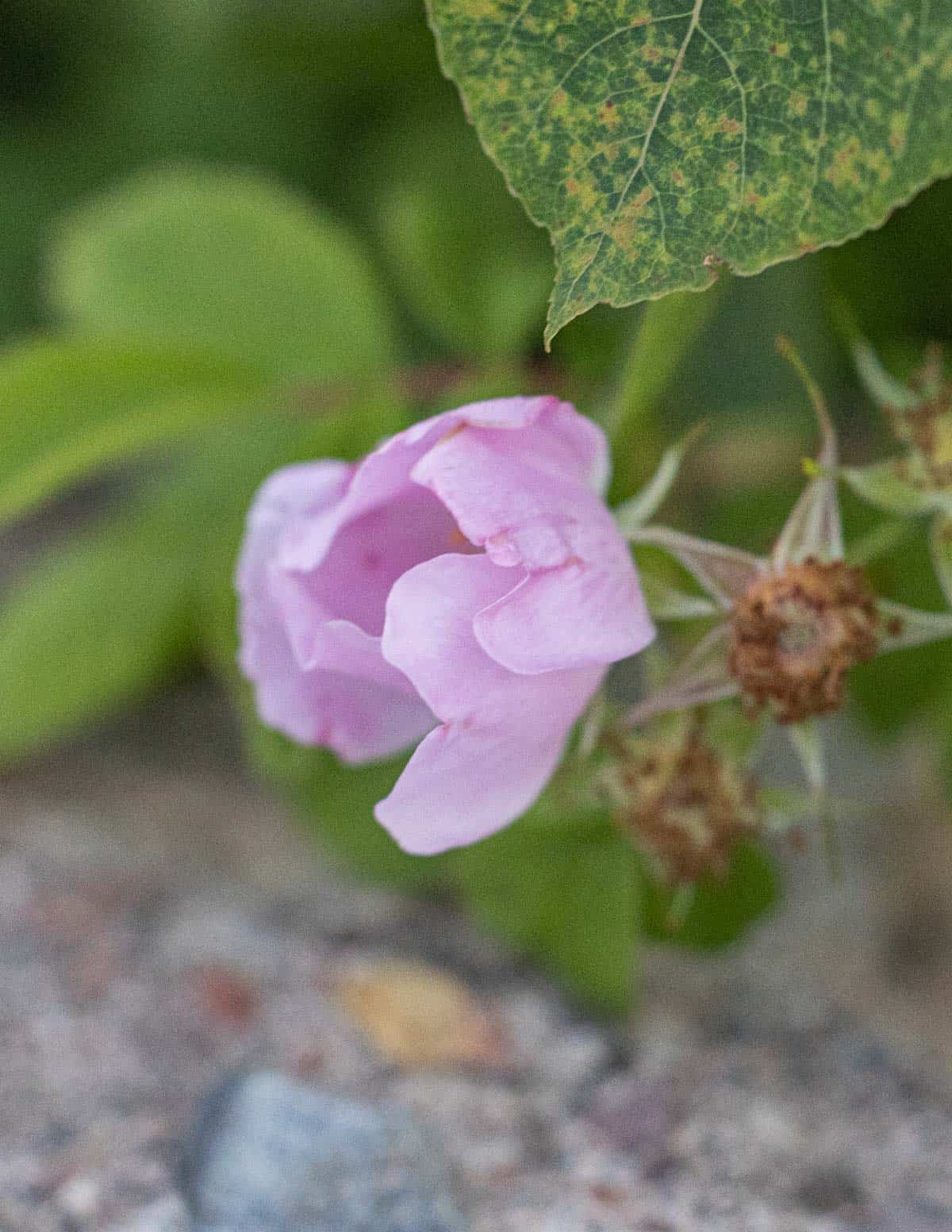
Smaller and more fragile than they're famous cultivated cousins, wild roses (Rosa spp) also don't come in a kaleidoscope of colors. The flowers are pink, have a strong aroma of rose, and can be used in salads, candied, or harvested en-masse to make things like rosewater. They can also be dried for teas and infusions.
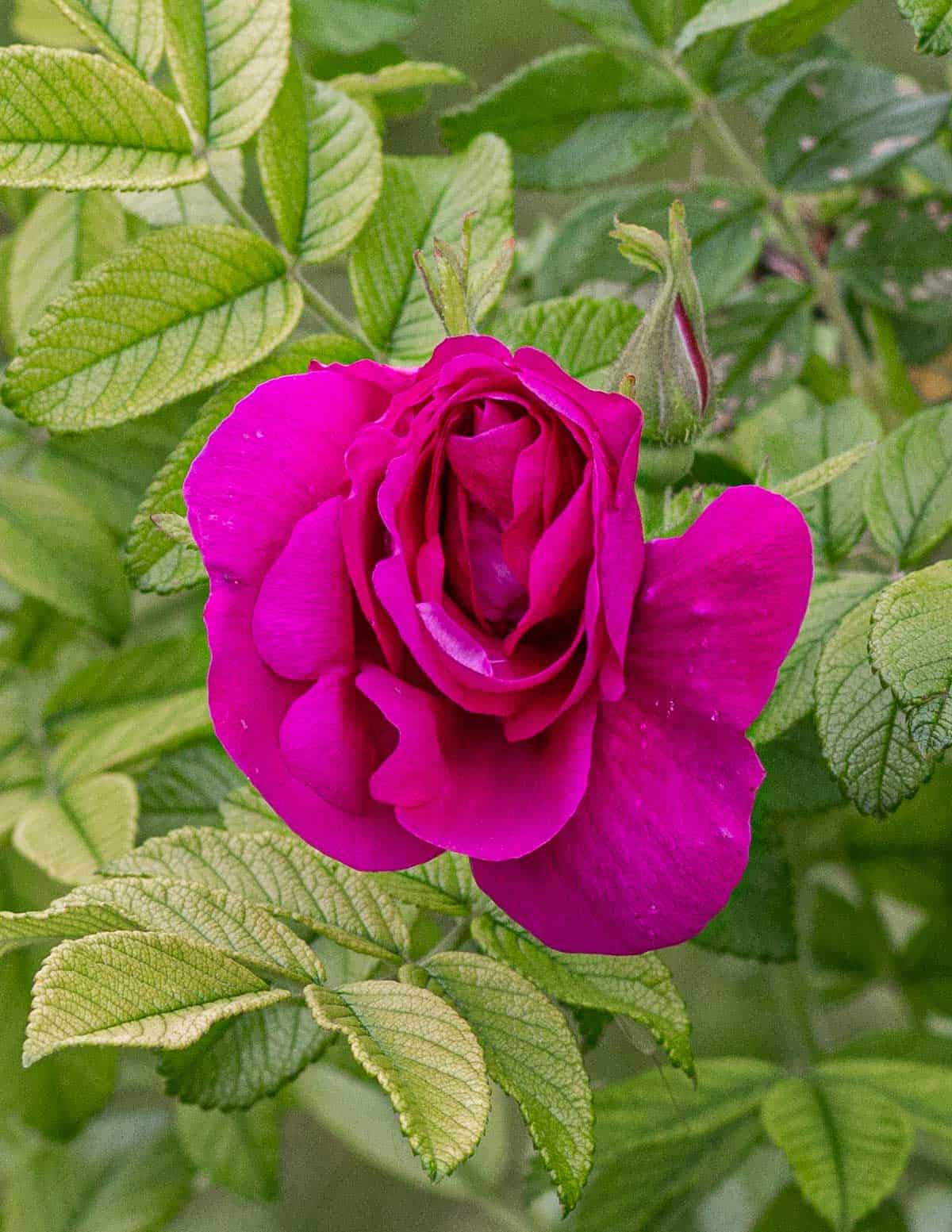
Don't forget that rosehips come after the flowers have been pollinated, and are also fantastic dried for tea. Larger varieties like Rosa rugosa make hips that can be trimmed and cooked into jams and preserves. Look for them in July.
Jewelweed
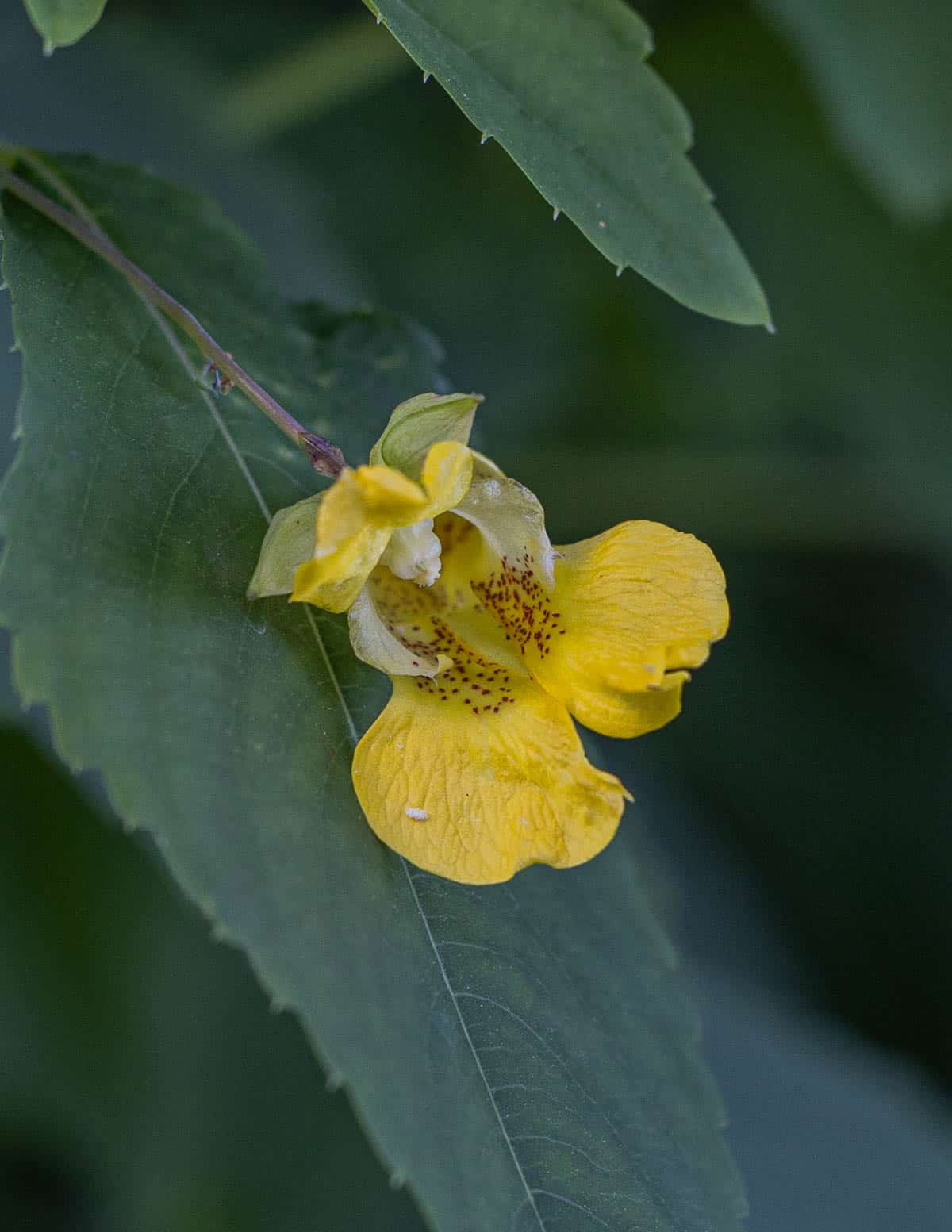
Jewelweed (Impatiens capensis) is a tall leafy plant with succulent, thin-walled stems. Most people know it for its use as a treatment for nettle stings, poison ivy and other skin irritations. Another fun part of the plant many will know is the "exploding" seed pods.
The flowers are edible with a mild, pleasant flavor. They're delicate, so they should be used soon after harvesting.
Lilacs
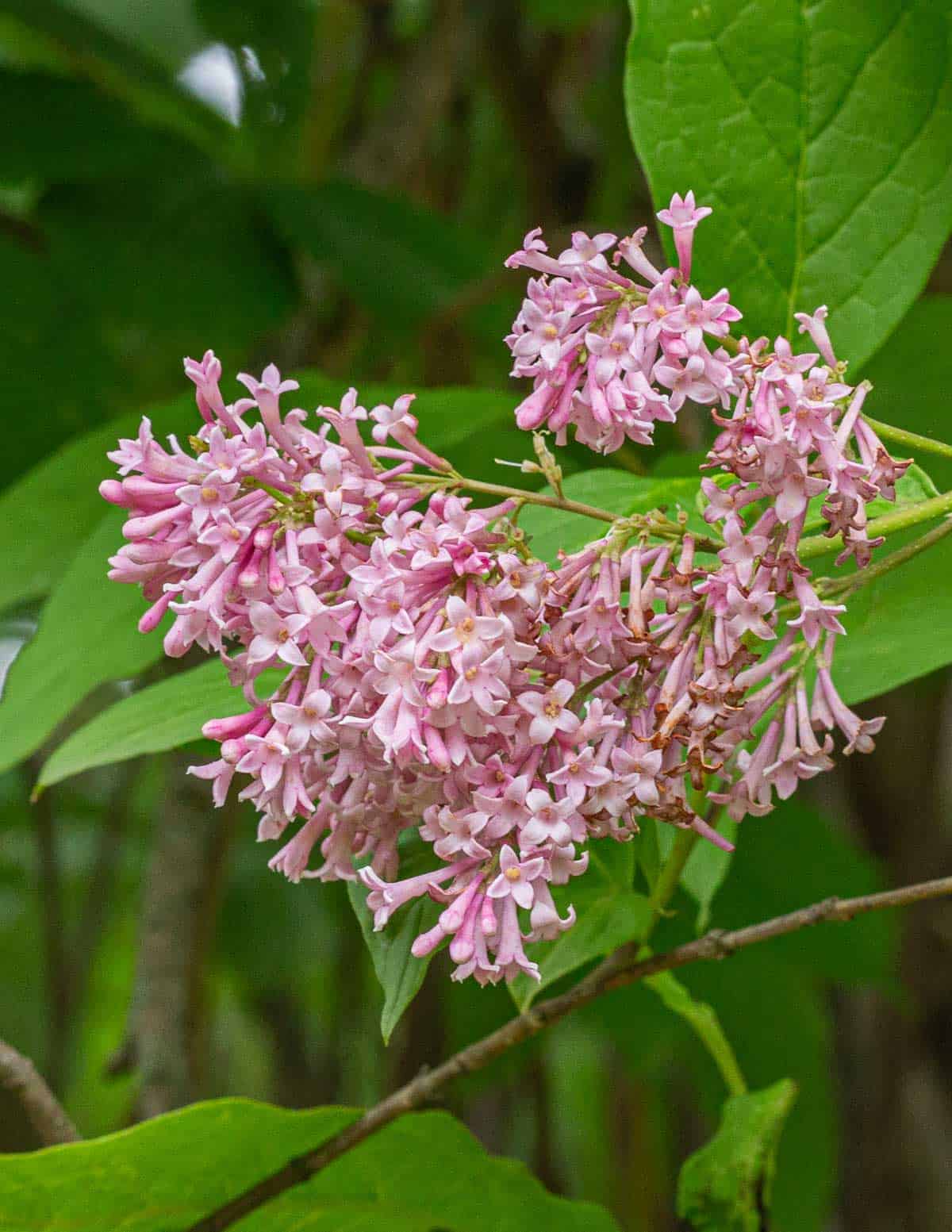
Arguably the most famous spring flower, lilacs are mostly seen in landscaping and in yards, but can escape and spread.
The flavor is slightly bitter and the texture a bit chewy, but their intense floral aroma can be infused into dairy, dried for tea, or mixed with sugar to make lilac sugar. Sometimes I use them to garnish dishes made with morels in May to celebrate the season.
Dead Nettle

Also known as mushroom mint, dead nettles (Lamium spp) are edible, just don't expect to use it to make mint ice cream. The flavor is deep and earthy and will be unpalatable for some.
The pretty purple flowers make a good garnish for salads and savory dishes. Some varieties can be aggressive, and I used to harvest them by the grocery bag for serving in restaurants when I ran into large colonies.
Nasturtiums
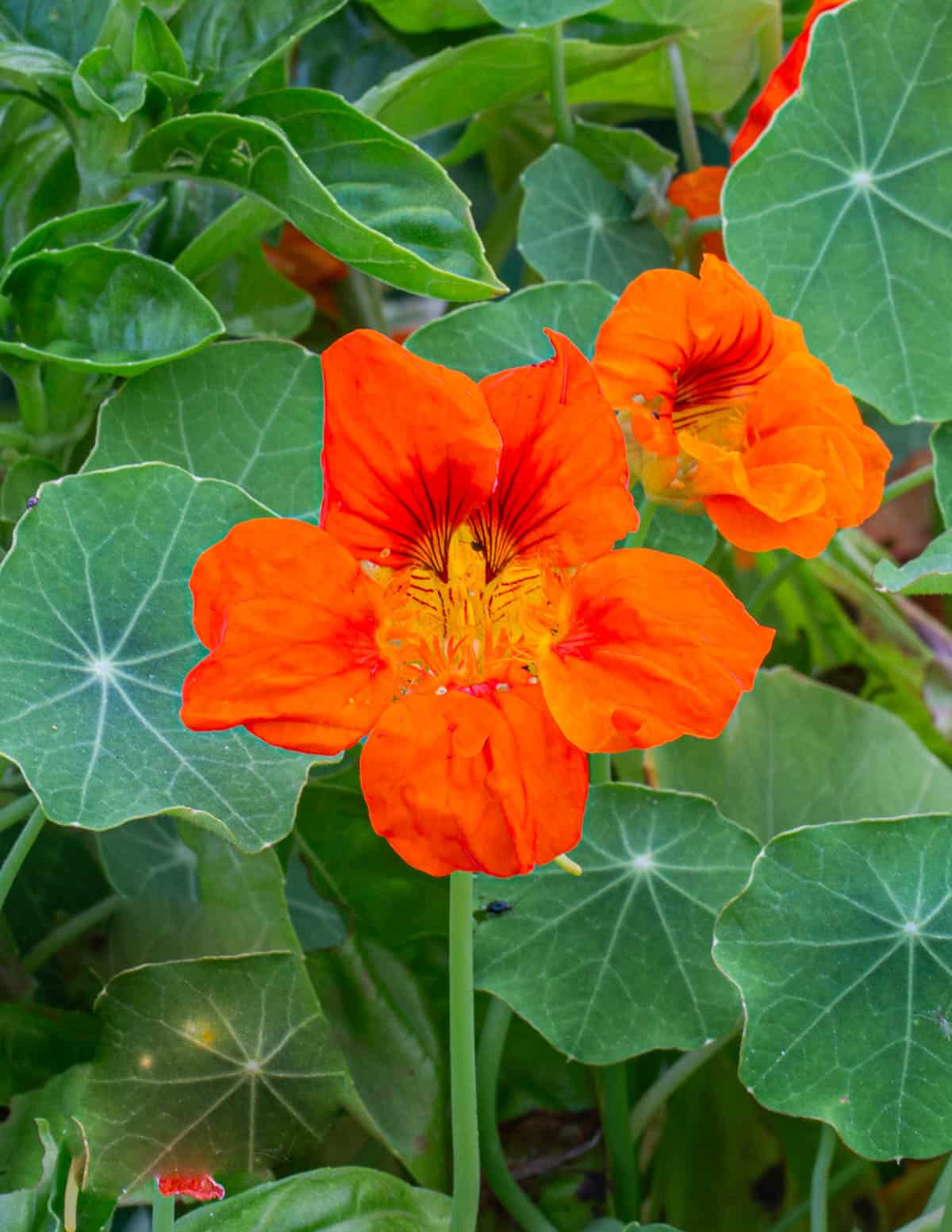
One of the finest edible flowers, nasturtiums come in a variety of colors. Mostly known as a garden plant, but nasturtiums also grow wild on the west coast of the United States. I often see them in the Bay Area.
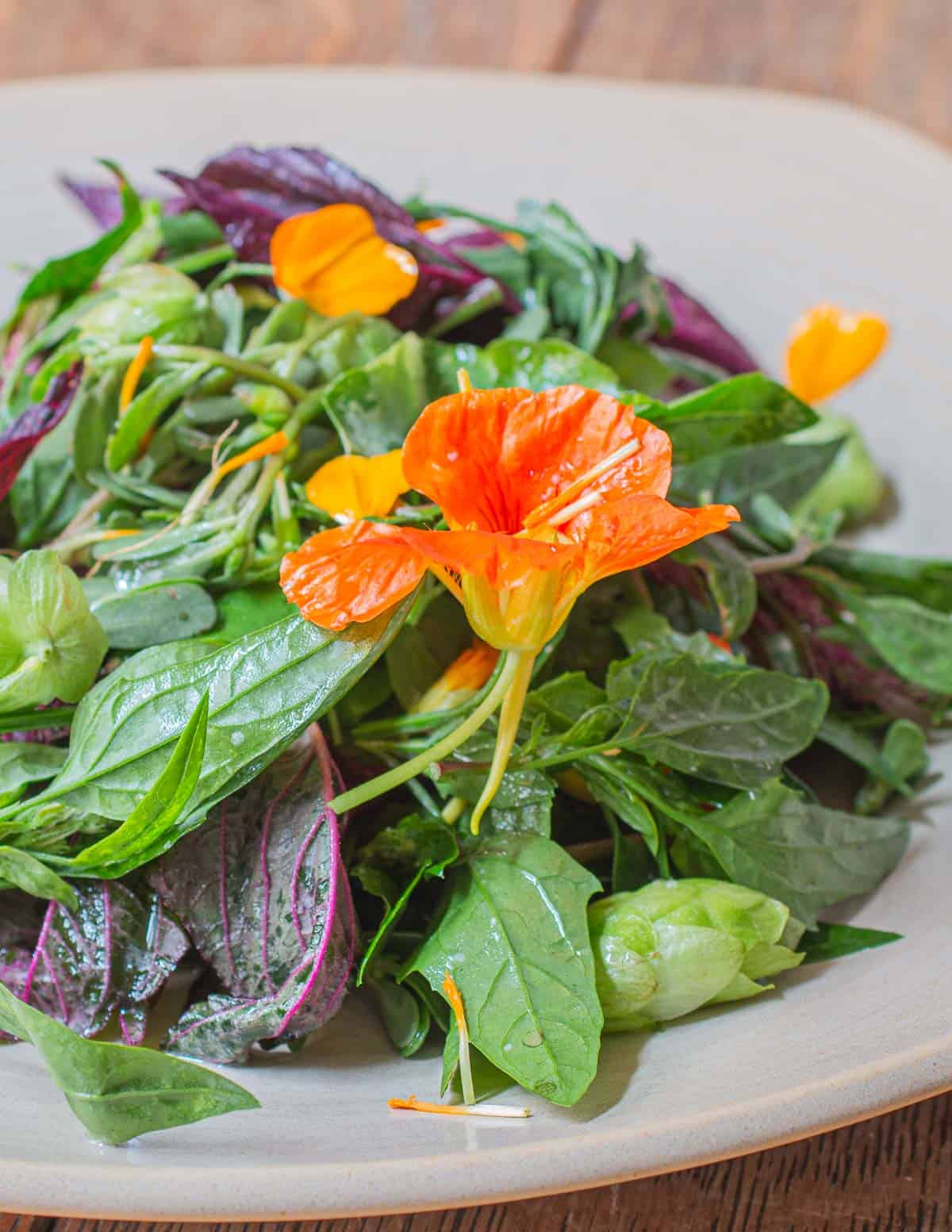
Their spicy, sweet taste and perfectly crunchy texture can be used to garnish sweet and savory dishes. Chef Jeremy Fox even makes ice cream out of them. Besides the edible leaves and flowers, the unripe seeds are one of the best for making fermented capers.
Day Lily
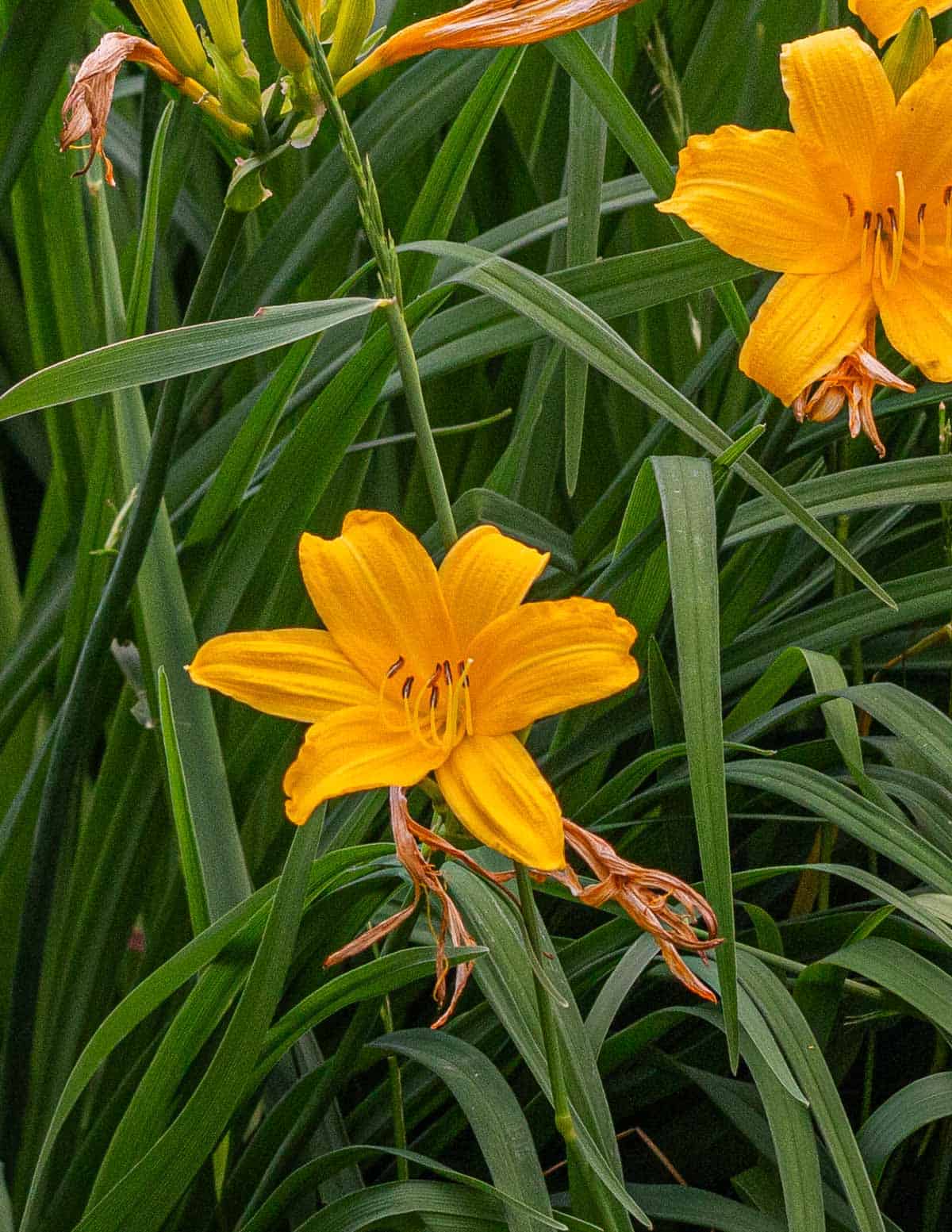
One of the first wild flowers I ate, day lilies (Hemerocallus fulva, and cultivated varieties) are common in yards, gardens and along roads. Unripe flowers can be cooked like a vegetable, fried, pickled or fermented.
The mature flowers are large enough that the pistils can be removed and the flowers piped full of mousse or filling. The colorful petals are perfect for picking off on top of a salad and have a mild, sweet taste. Look for them in late June through July.
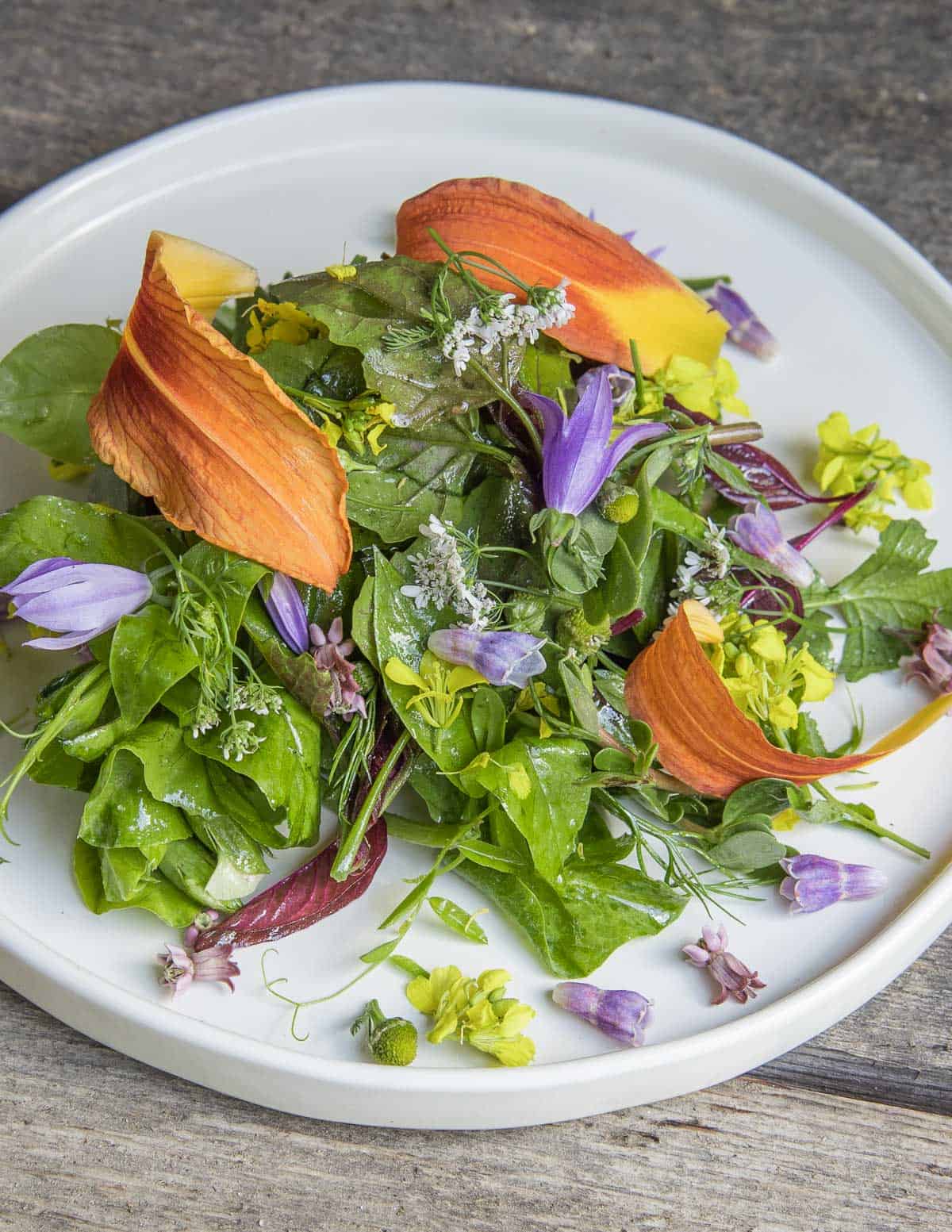
I've never had a problem eating day lily petals, but it's important to know that the shoots can cause intense nausea if eaten raw.
Bee Balm
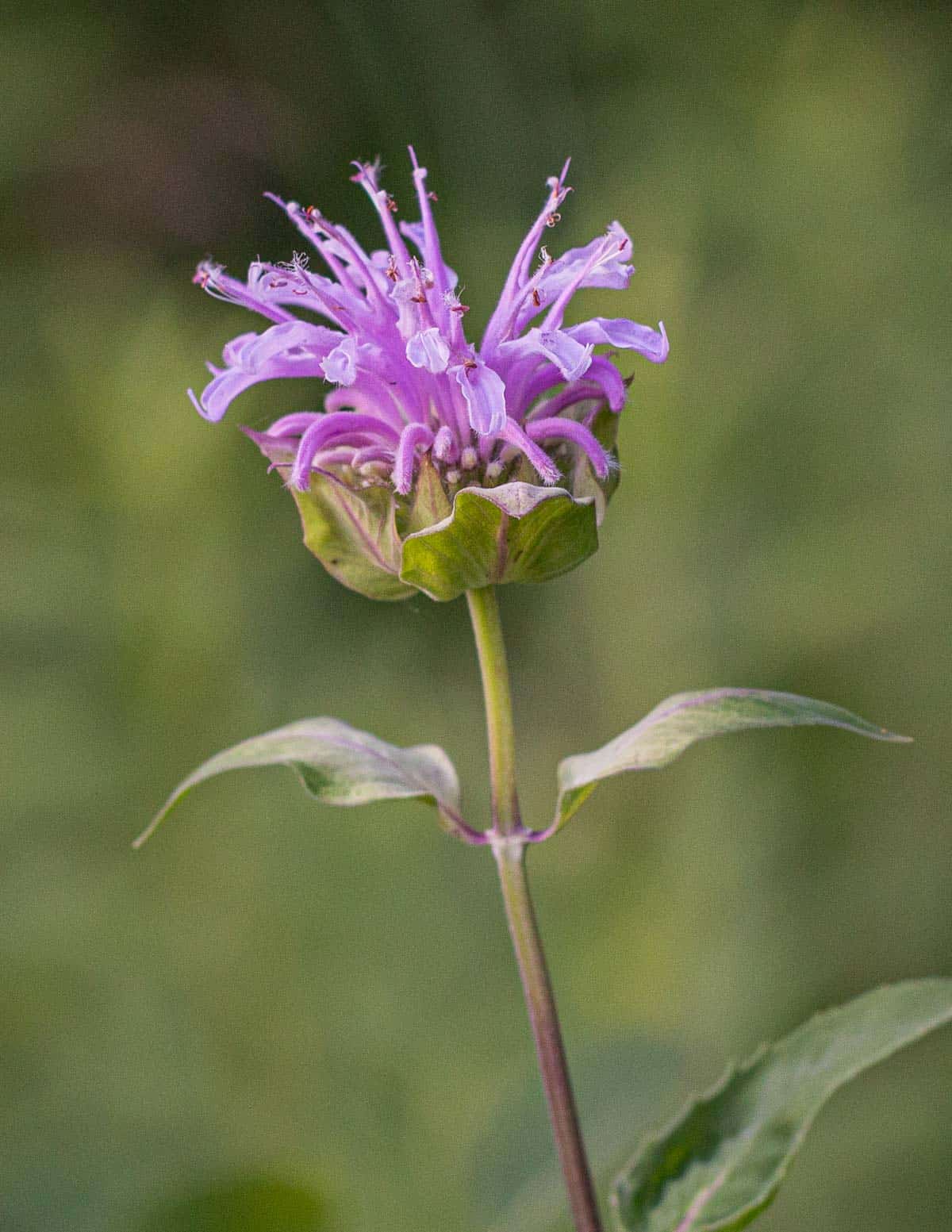
With its taste of oregano mixed with thyme, wild bee balm (Monarda fistulosa) is one of the best wild herbs available to foragers. The flowers have a savory taste that's identical to the leaves, and make a beautiful garnish for salads and savory dishes wherever the flavor of oregano would be welcome.
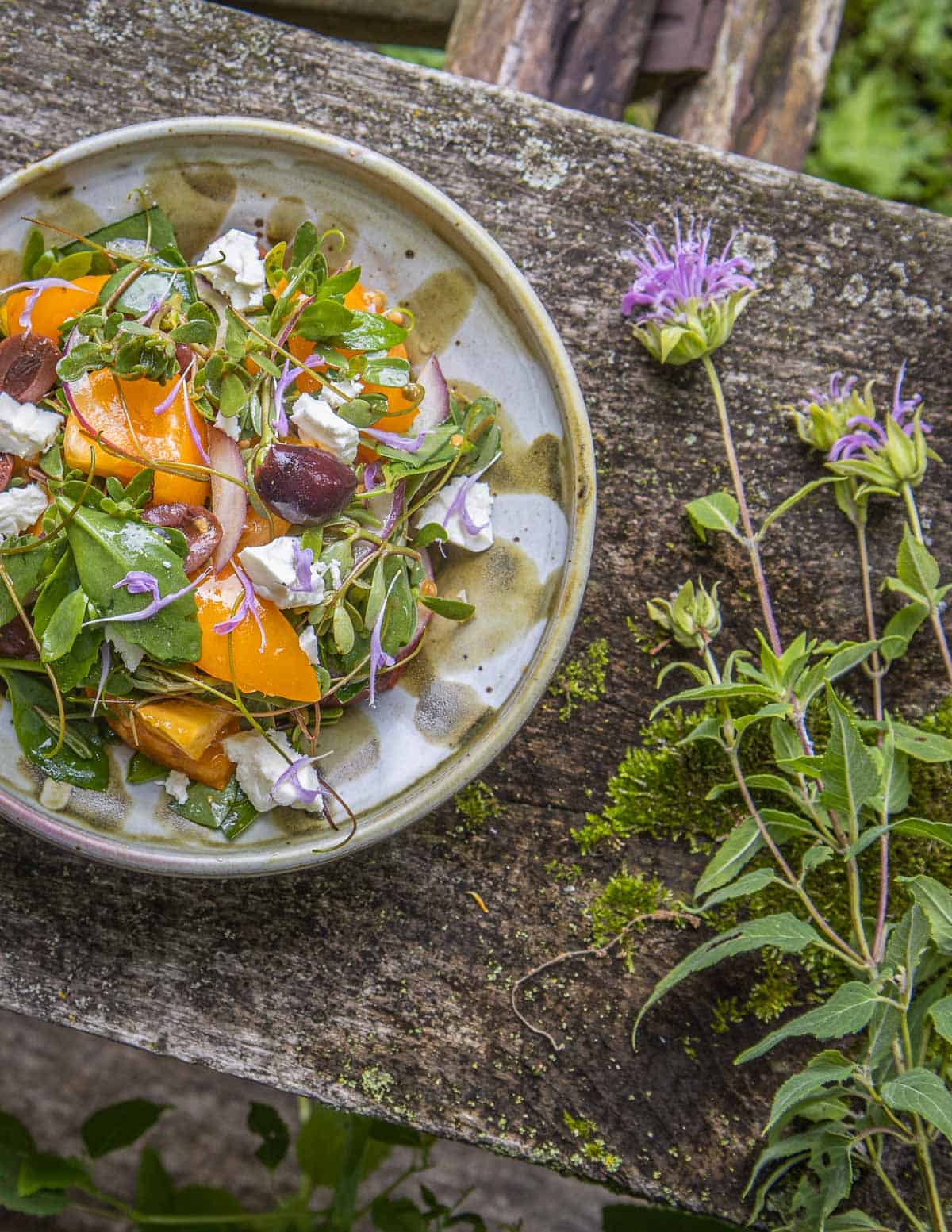
I like to dry the blooms whole and crumble them to use as an herb. It's one of the best herbs for flavoring tomato sauce and vinaigrettes. I use it to make a semi-traditional Italian Salmoriglio Sauce.
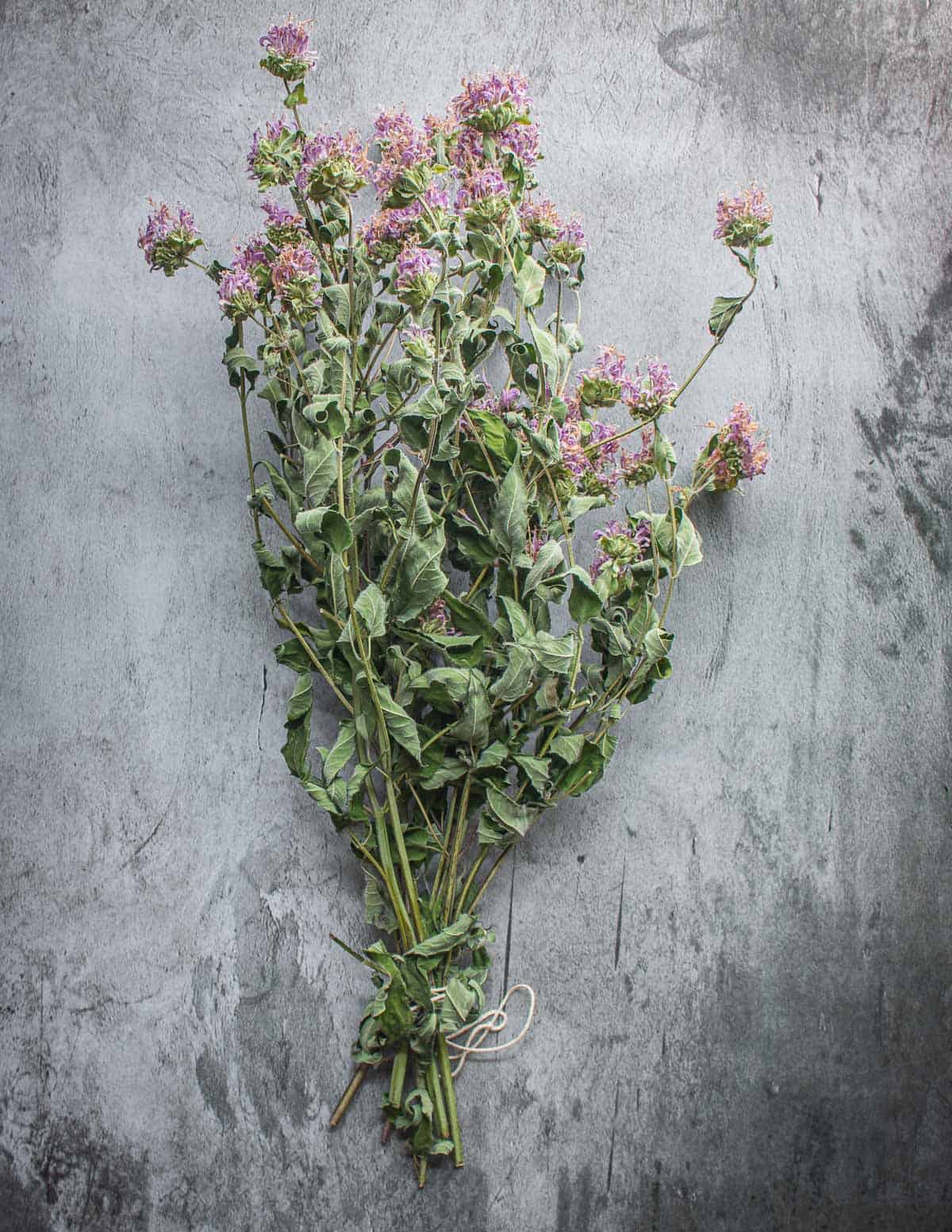
Scarlet Bee Balm
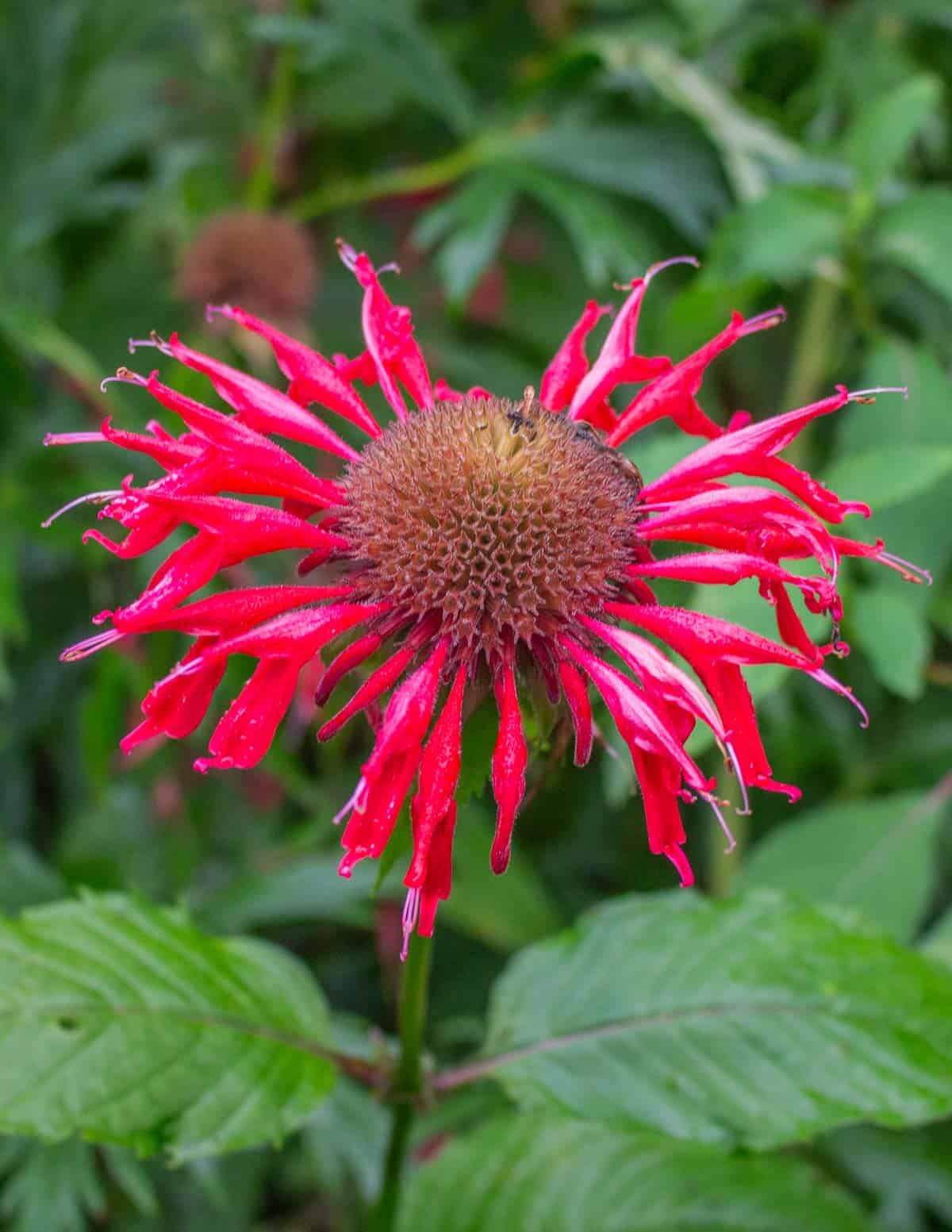
A cousin to common bee balm, scarlet bee balm (Monarda didyma) is mostly known as a garden plant where I live, but will grow wild on the East Coast of North America. Unlike M. fistulosa, the leaves have an inferior taste to the flowers I describe as "raspberry-oregano".
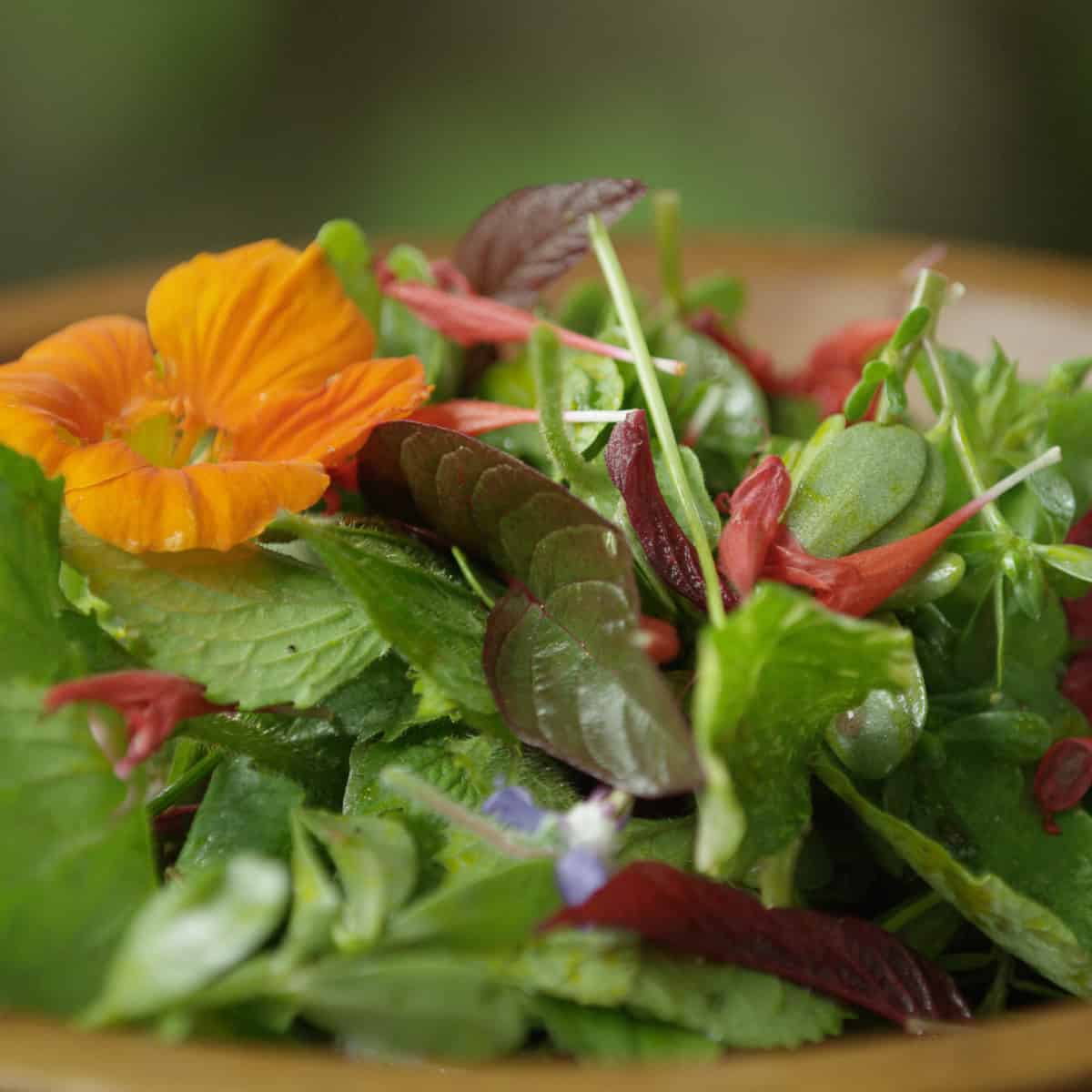
Above: Lambsquarters salad with scarlet bee balm flowers. Image by Jesse Roesler.
I don't use the leaves of M. didyma, but the flowers are a contender for one of the best around, and were the personal favorite of Chef Jonathan Gans when I was supplying the bachelor farmer. Just a sprinkle will enhance any dish with pops of sharp, fruity flavor.
Angelica

The flowers of angelica are small, but powerful. I use my local wild angelica (Angelica atropurpurea) but there's many varieties around the world. The flowers have the same strong, herbaceous aroma as the green parts of the plant, but are less aggressive in taste as they're smaller in size.
They can be clipped with a scissors and added to salads with fruit, green salads, or used to garnish fish. The whole blooms can be added to liquors and infusions.
Like some other carrot family plants, angelica sap is a phototoxin, so be mindful of keeping it off your skin or harvest with gloves.
Cow Parsnip
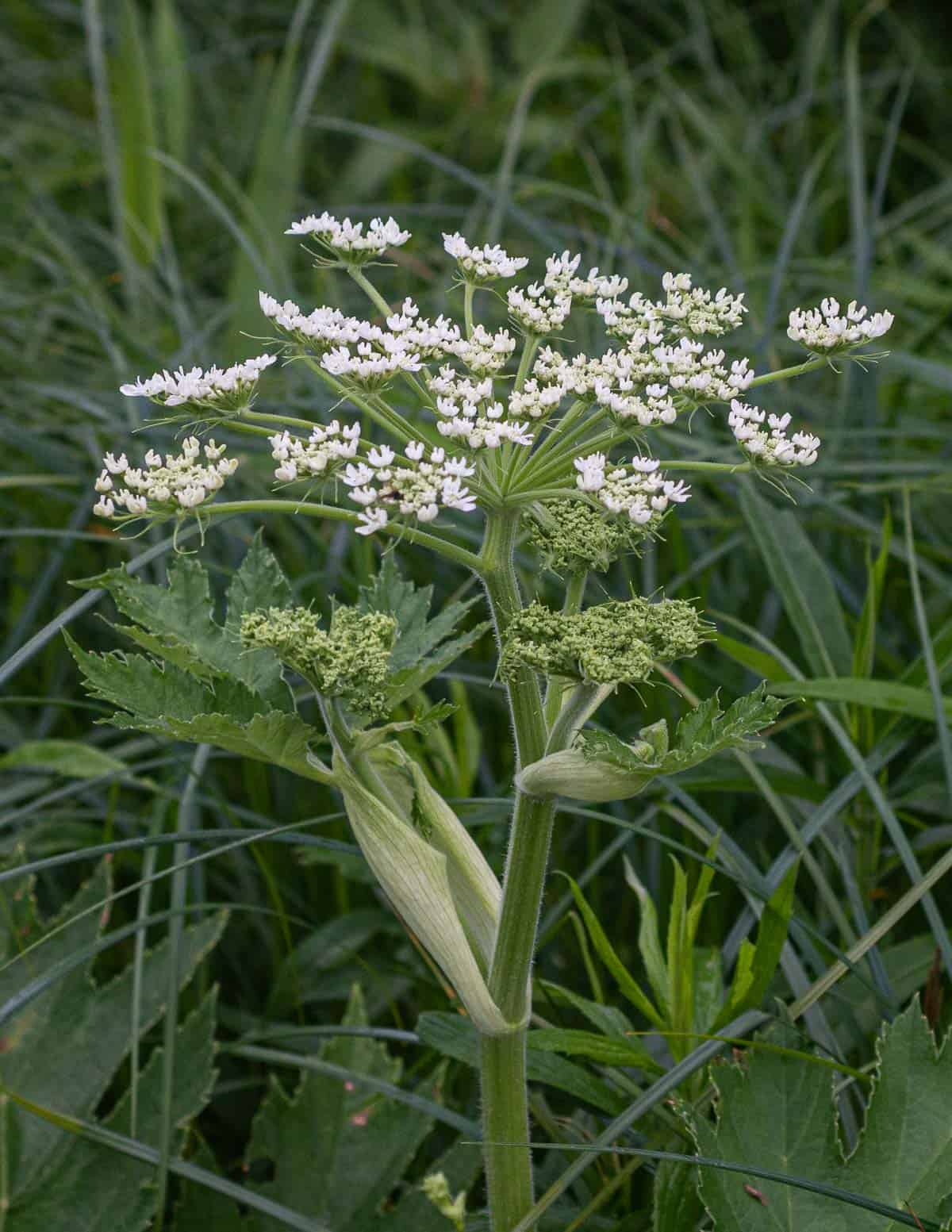
The large blooms of cow parsnip (Heracleum spp.) have a pleasant aroma and can be used to garnish sweet and savory dishes. They're small, but I used to harvest them en-masse for selling to restaurants, where they can be used as a spinkle on salads, dried for tea, and used in infusions.
The sap of the green parts of the plant is a phototoxin and can cause photodermatitis, just like wild parsnip and garden parsnip.
Wild Carrot
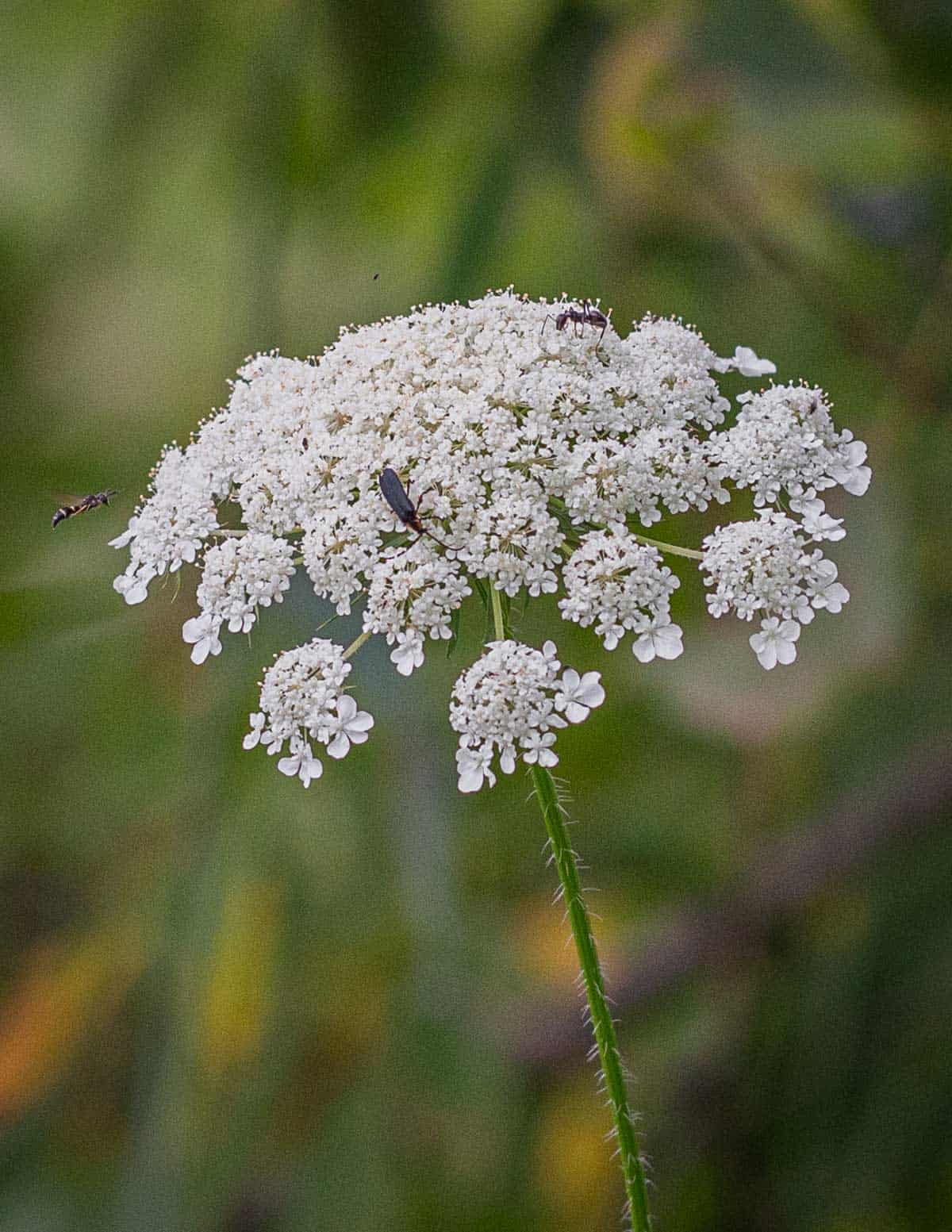
Along with the seeds, wild carrot flowers are the most useful part of wild carrot plants. The aroma is sweet and reminiscent of carrots, and can be used to flavor liquors, teas and infusions. The seedheads (pictured below) are my favorite part of the plant and are even more useful.
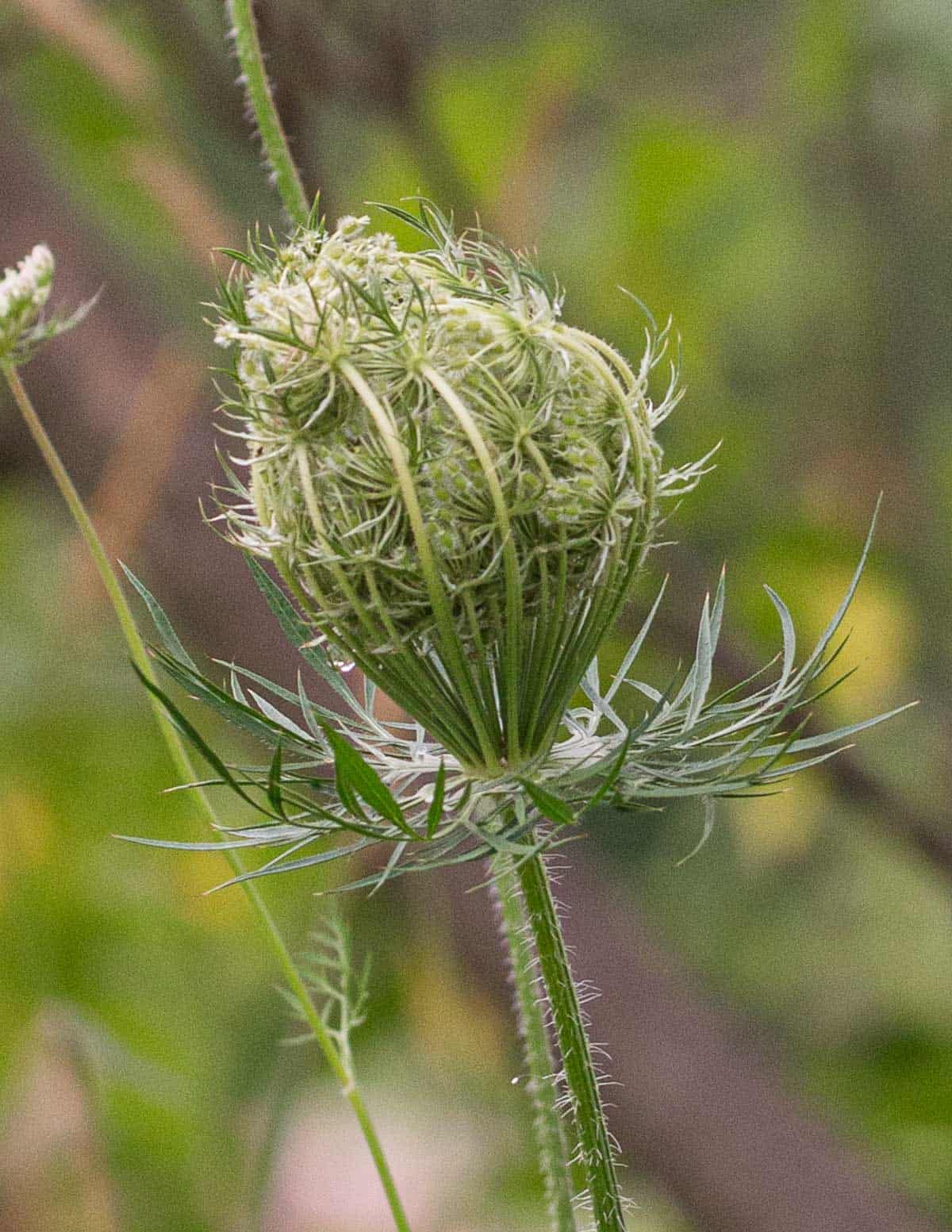
A strong decoction or reduced tea of carrot flowers has been historically used as an abortifacient. That said, dosage is important here and a few flowers sprinkled on a salad is fine.
Oxe Eye Daisy
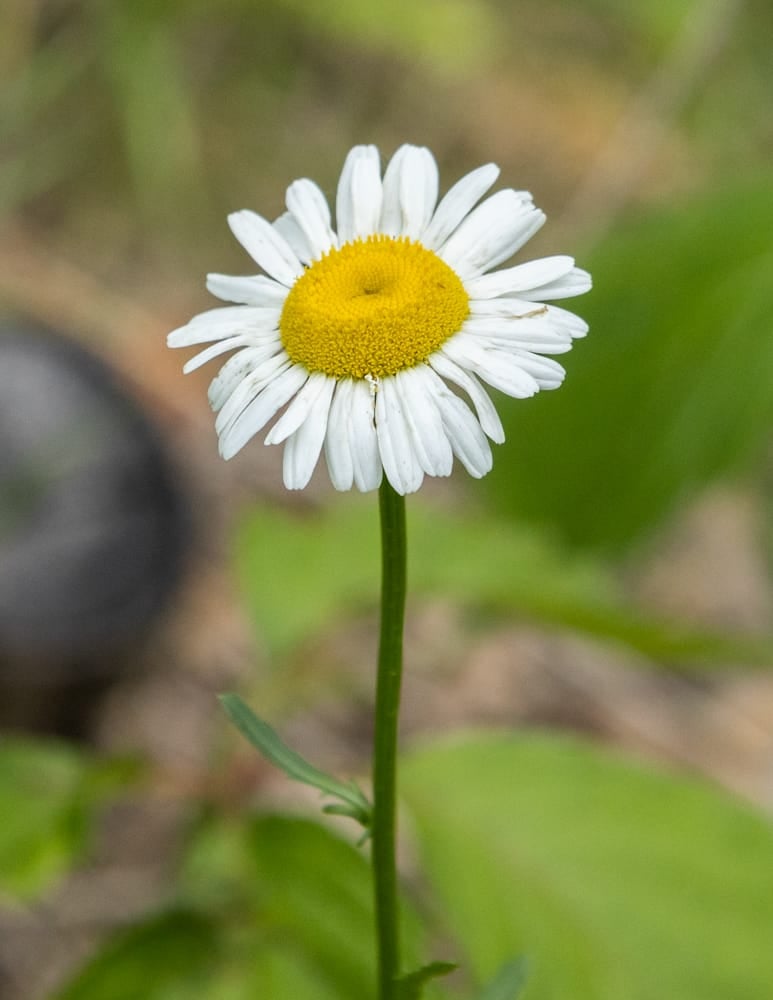
One of the largest and sturdiest flowers, oxe eye daisy (Leucanthenum vulgare) are listed as a noxious weed in some places, so you can harvest as many as you like. The crisp, mild tasting flowers have a subtle aster flavor, and are fun to eat.
Some of my friends enjoy putting them in spring rolls but they'll be great added to just about any cold dish or composed salad.
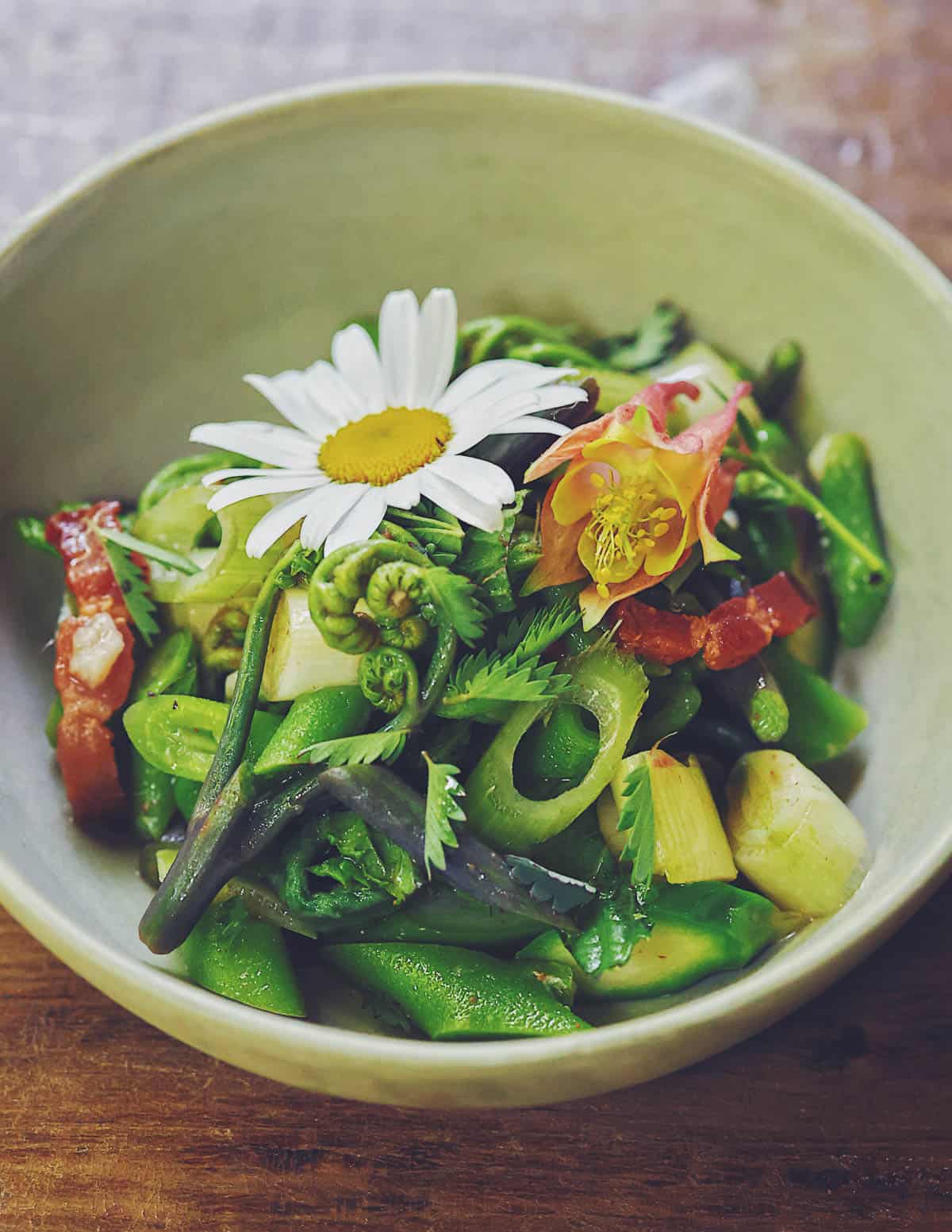
Above: spring shoot salad with oxe eye daisy, columbine flowers, mint and bacon vinaigrette. Image by Jesse Roesler.
Daisy Fleabane
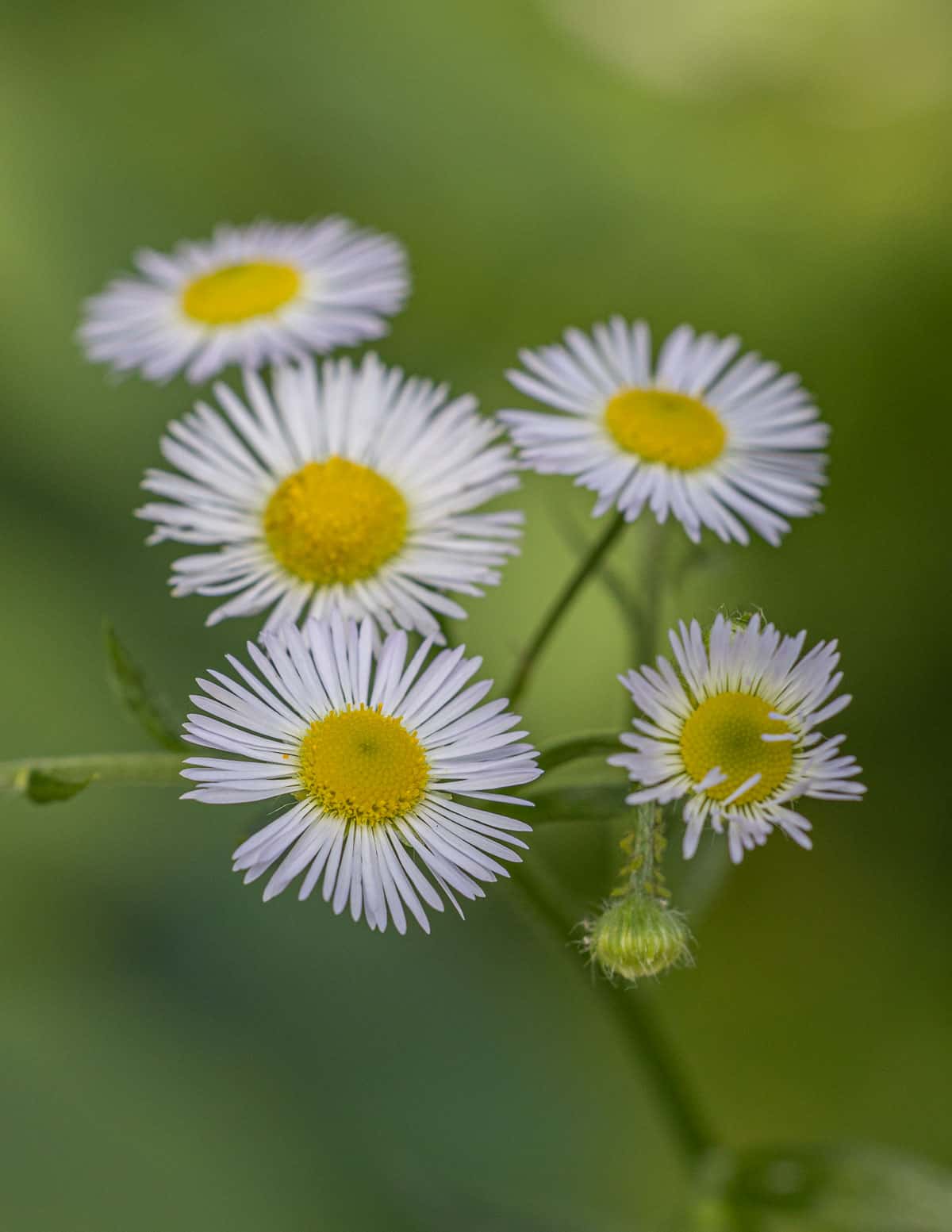
A smaller cousin of oxe eye daisy, daisy fleabane (Erigeron annuus) is much stronger and has a stronger flavor some people won't care for, at least all by themselves. The flowers can be added to salads or dried for tea, and have a tradition of use in Europe.
Most notably, a few years ago they were mentioned as one of the common plants harvested by a group of professional foragers from Switzerland. Personally I don't care for them.
Aquilegia / Columbine Flowers
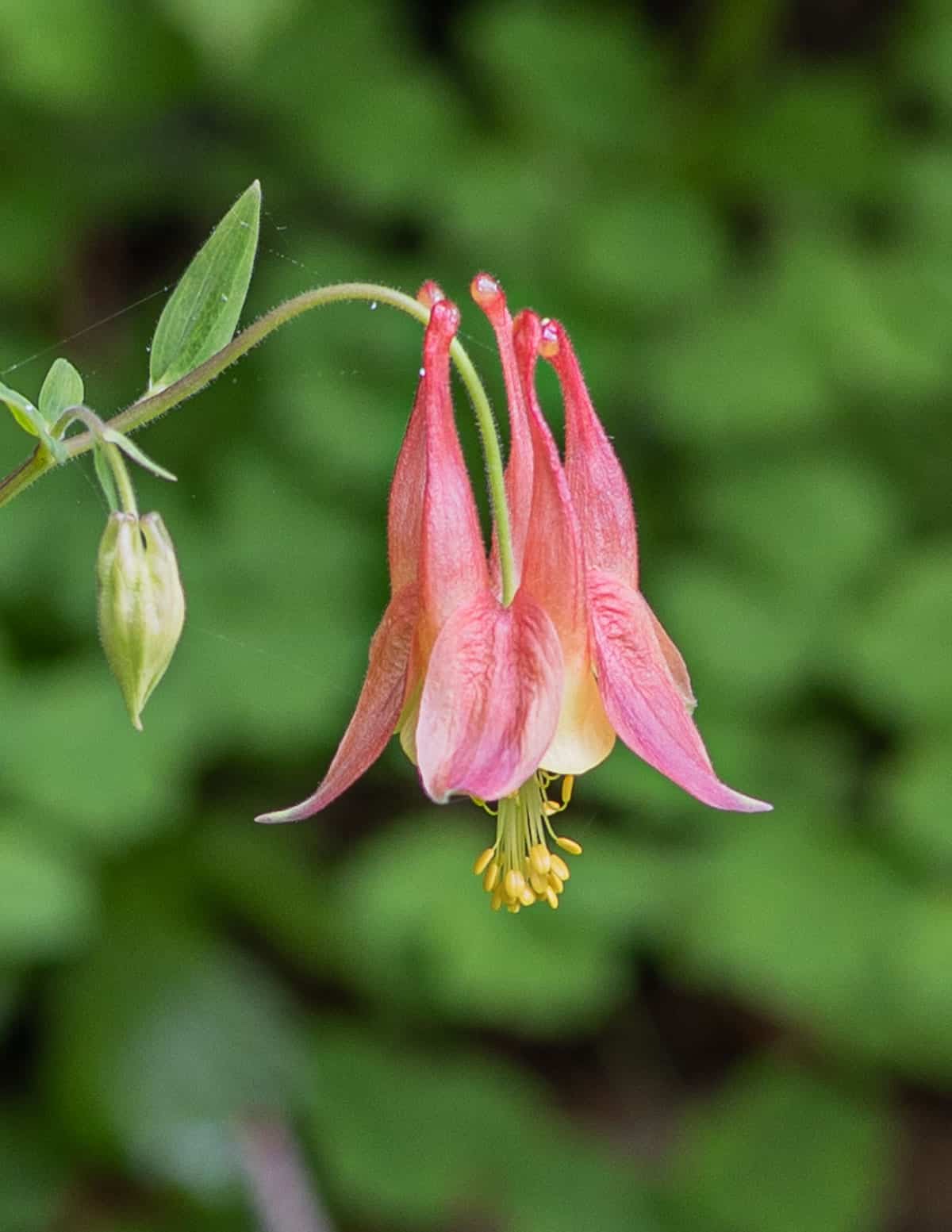
One of the most striking wild flowers, Columbine (Aquilegia canadensis) have a slightly sweet taste. Most people will known these from nibbling the sweet tips as children.
Only the flowers of this plant should be eaten and the rest of the plant can cause gastro-intestinal distress.

The flowers have a mild flavor and can be used to garnish sweet and savory dishes. Look for them to start blooming in June.
Violets
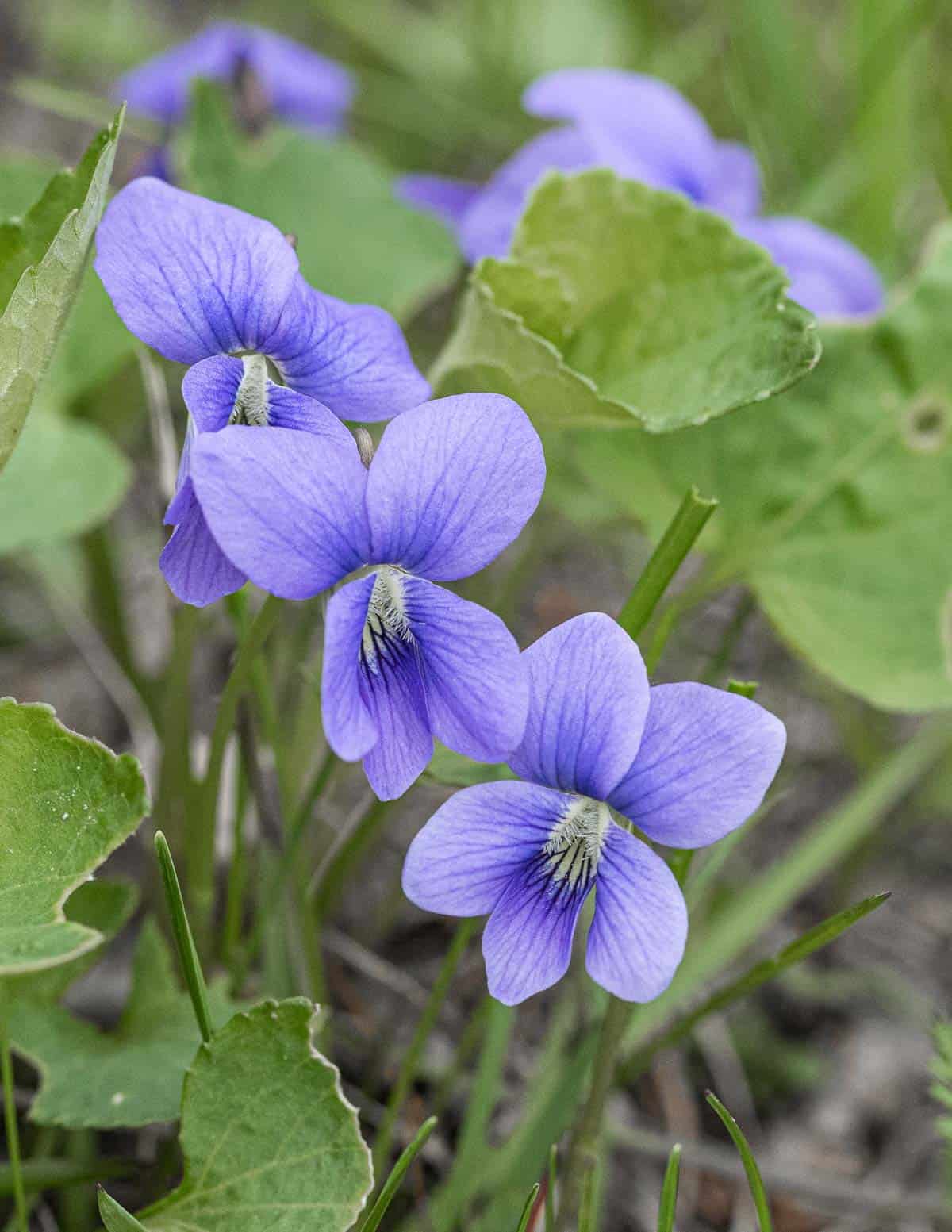
Woodland violets (Viola spp) are common in gardens, disturbed areas and the woods and come in a number of colors. All varieties of violet flowers are edible. They have a mild flavor and can be used to garnish sweet and savory dishes.

One popular recipe people make is violet jelly and syrup, which changes color from blue to purple when the pH is adjusted with acid, typically lemon juice.
Black Locust Flowers
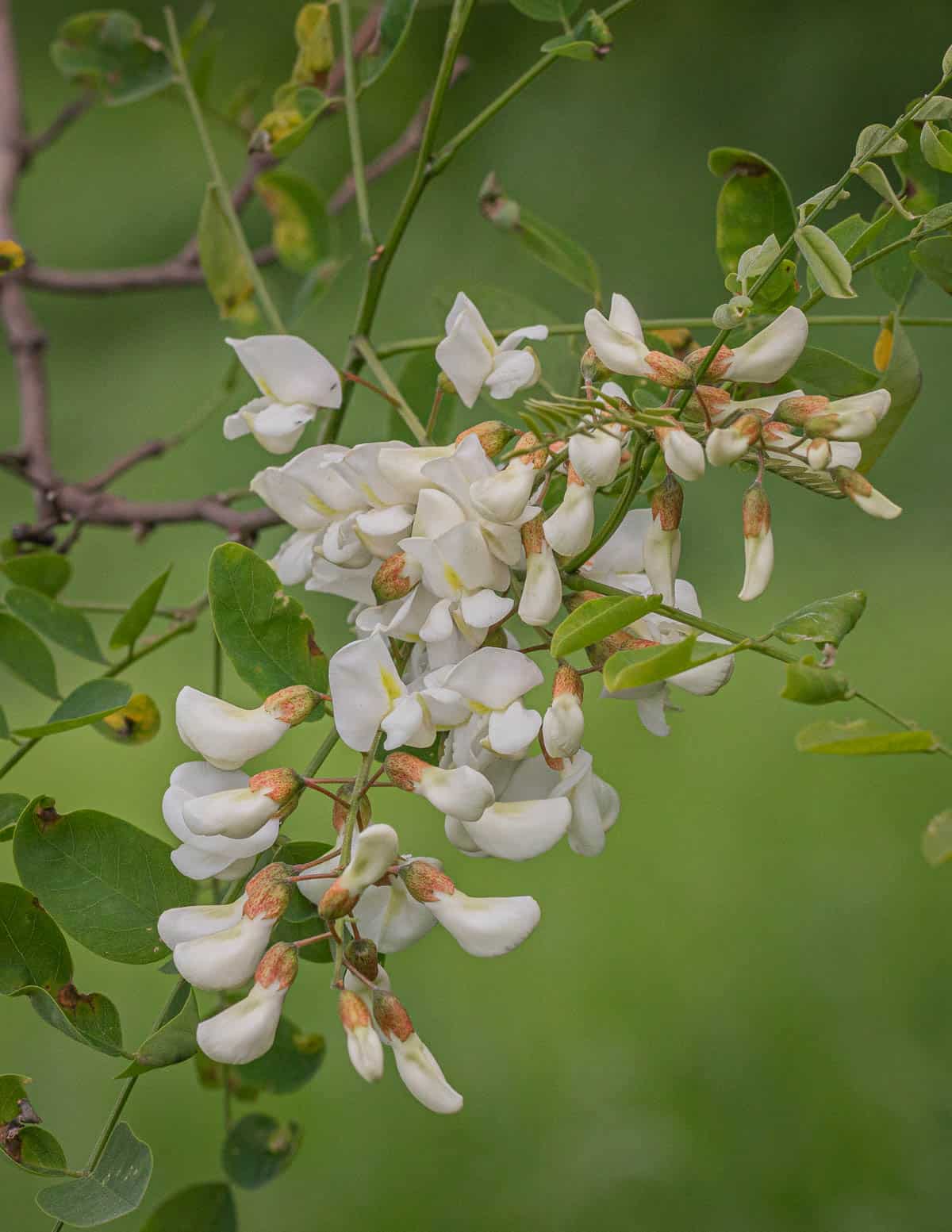
Easy to identify and harvest in great quantity, black locust flowers (Robinia psuedoacacia) are a leguminous tree flower with an intense aroma of jasmine perfume.
Possibly the greatest edible wild flower, they can be added to both sweet and savory dishes, and are so mild tasting they can be eaten by the handful or cooked as a vegetable.
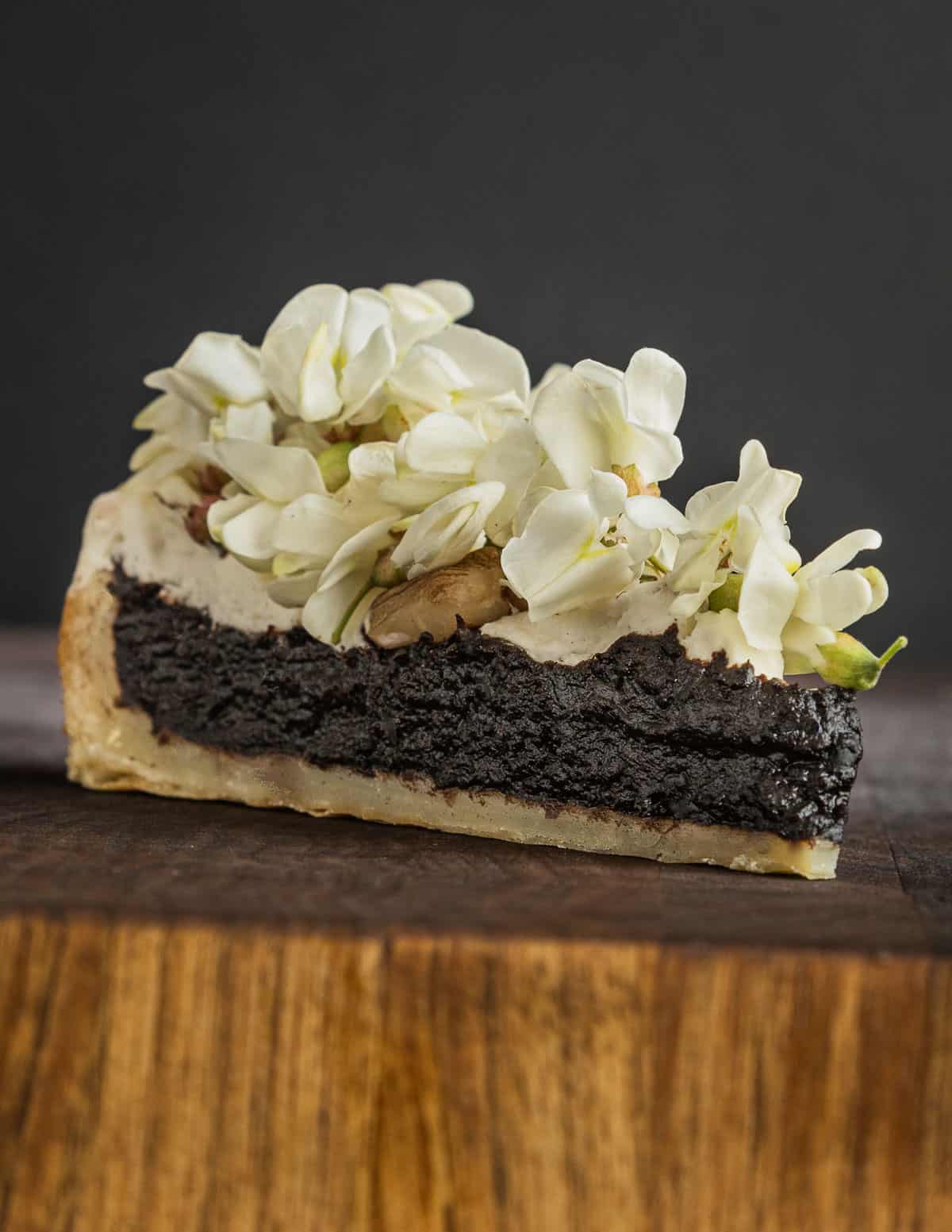
The season is very short, often only a few days, rain willing. Look for them in Early June. Bristly locust flowers (Robinia hispida) are related, have a deep red/pink color and can be used in the same way.
White Campion
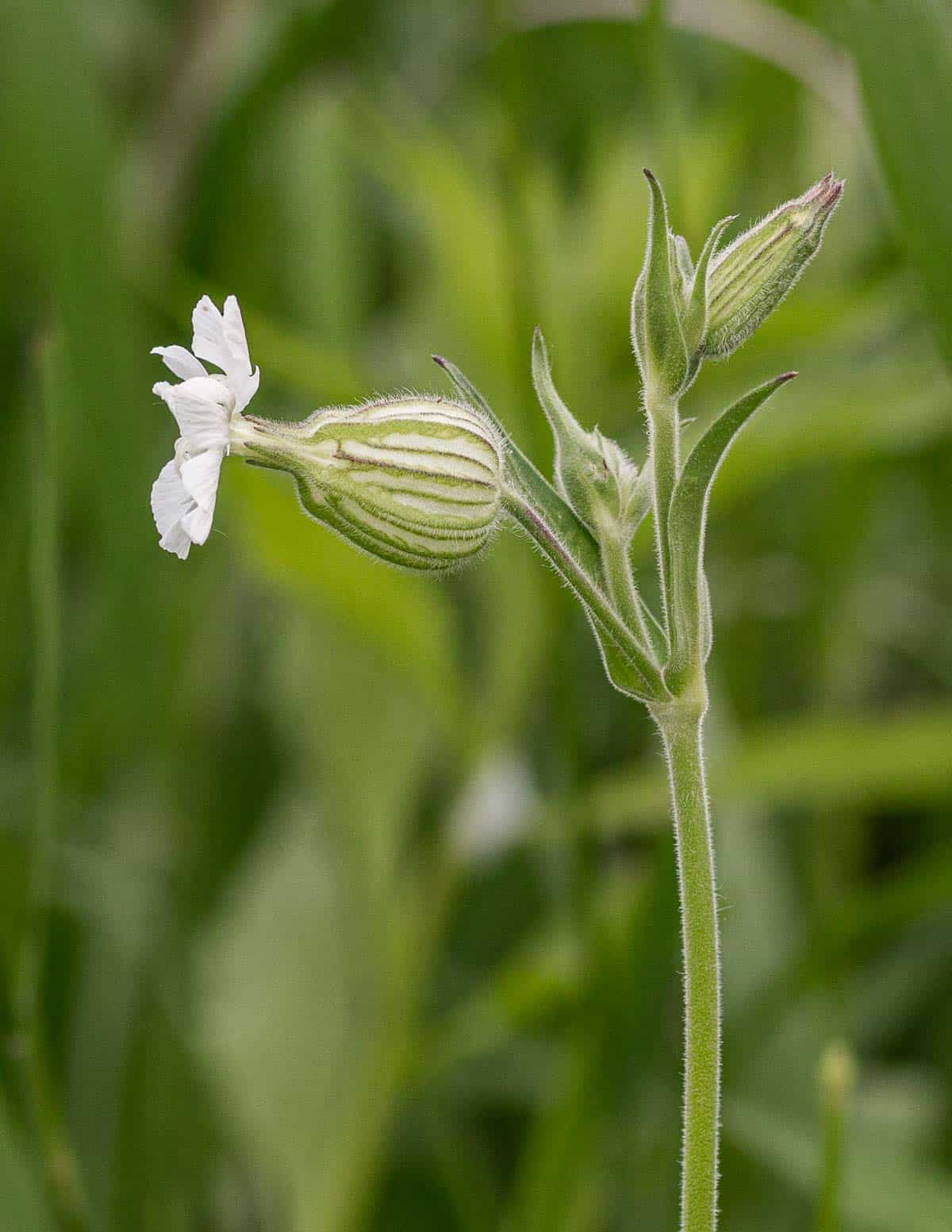
One of two campions I harvest, white campion (Silene latifolia) has inferior greens to bladder campion (Silene vulgaris). Contrastingly, the flowers of white campion are larger and better than bladder campion (Pictured below), which are astringent and make my throat tingle. I love their shape, which reminds me of the puffed sleaves of a Victorian dress.
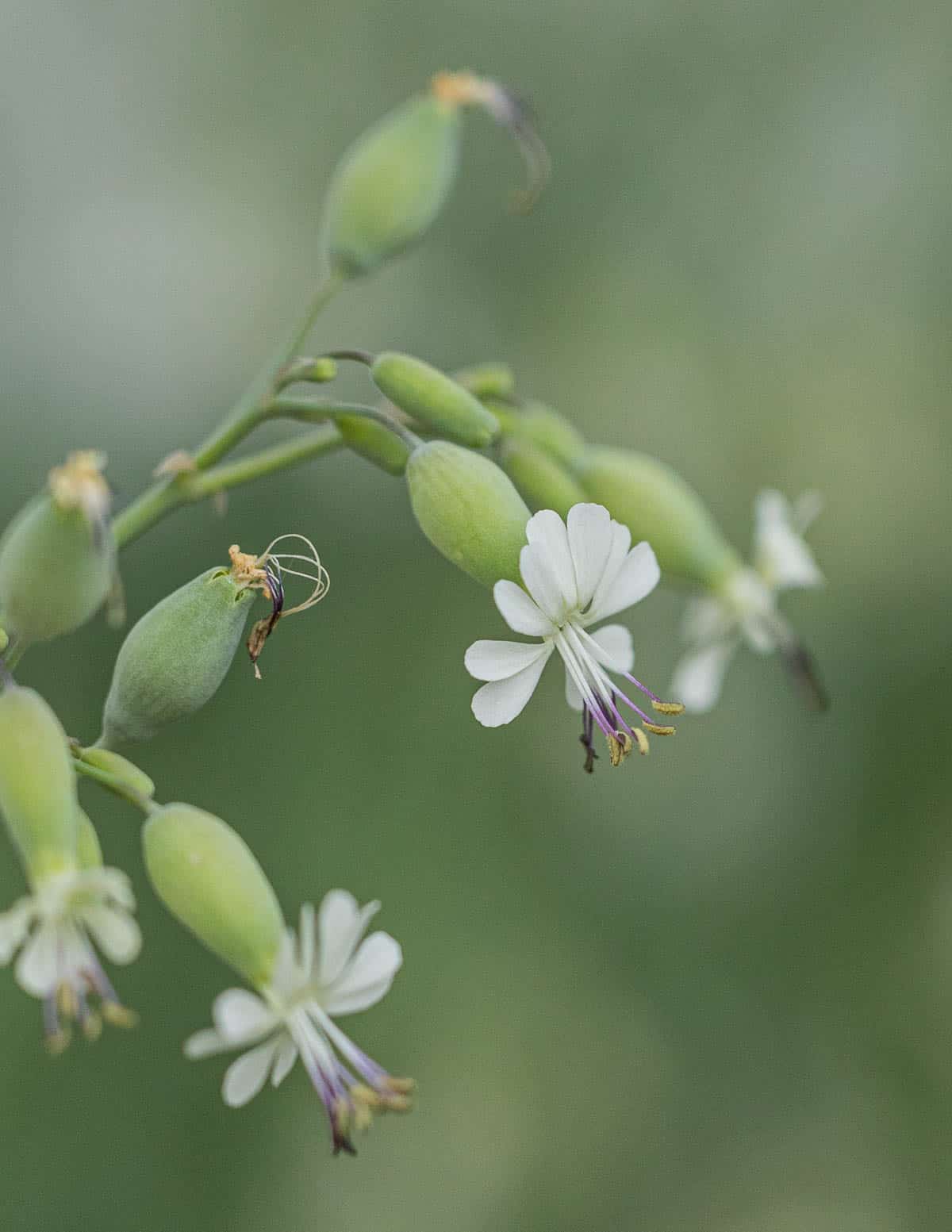
Easy to identify with a mild flavor, the white flowers are a great addition to salads, and just about any dish where a few flowers would be nice. Look for them in late spring through June.
Ramp Flowers

One of the most savory flowers available to foragers, ramp flowers, along with their cousins like bear garlic (allium ursinum) can be used on savory dishes. They're particularly good in dishes with raw meat and fish, or vegetable dishes like the burdock noodles pictured below. Just like every other plant, they have a strong flavor of garlic. Look for them in June.

Sochan
Sochan (Rudbeckia laciniata) the traditional Cherokee food plant known for its delicious greens that can be harvested 4 times during the growing season each year.
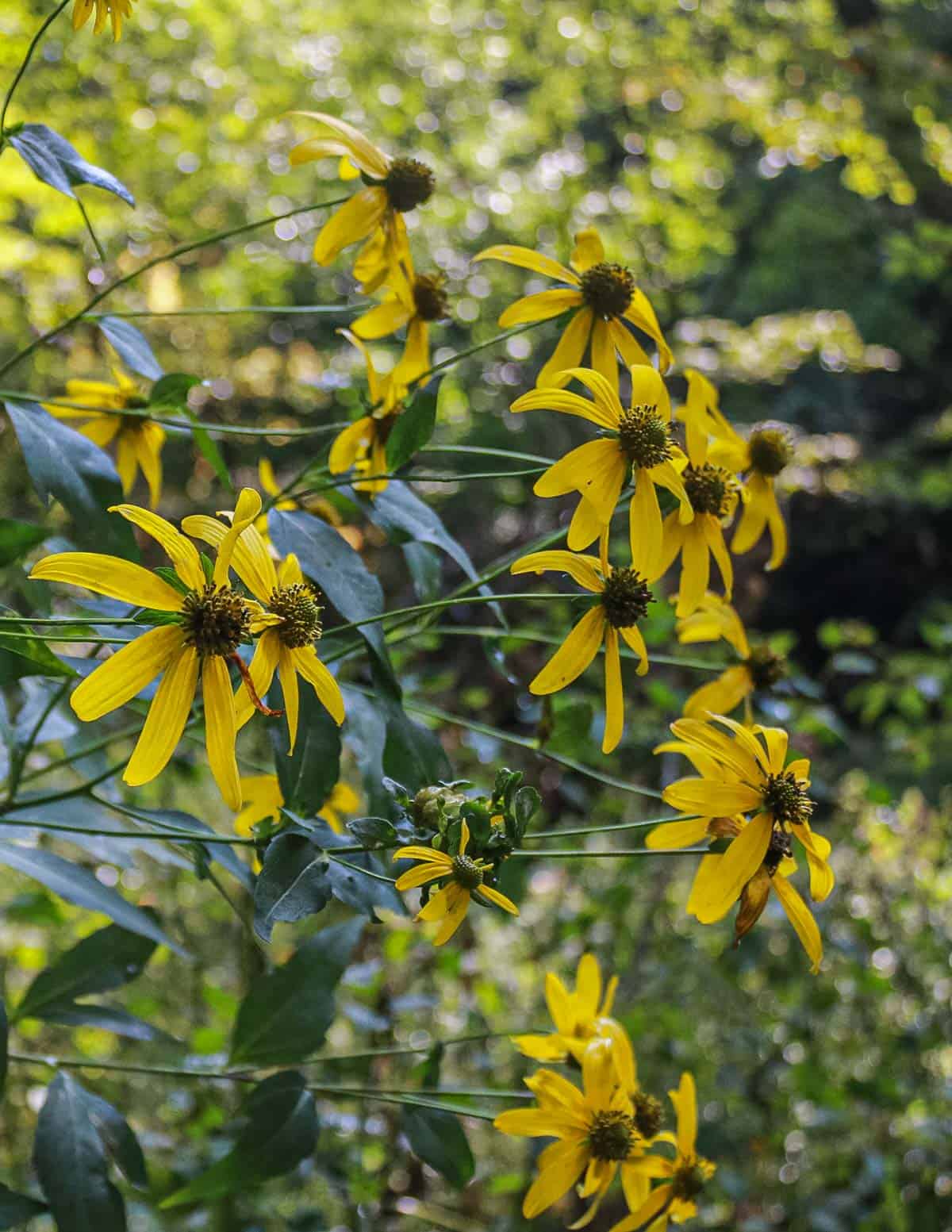

Sochan flowers are edible, with a mild flavor reminiscent of the aster taste the rest of the plant has. To use the flowers in a salad, pick the individual petals off and discard the rest. They're not the most incredible in taste or texture, but they can add a pop of color. Sunchoke flowers (pictured below) are edible but so bitter most won't care for them.

Dandelions
Arguably the most famous edible wild flower, dandelion flowers can be cooked like a vegetable in dishes like dandelion fritters. The young, unopened buds can be pickled or fermented like capers.
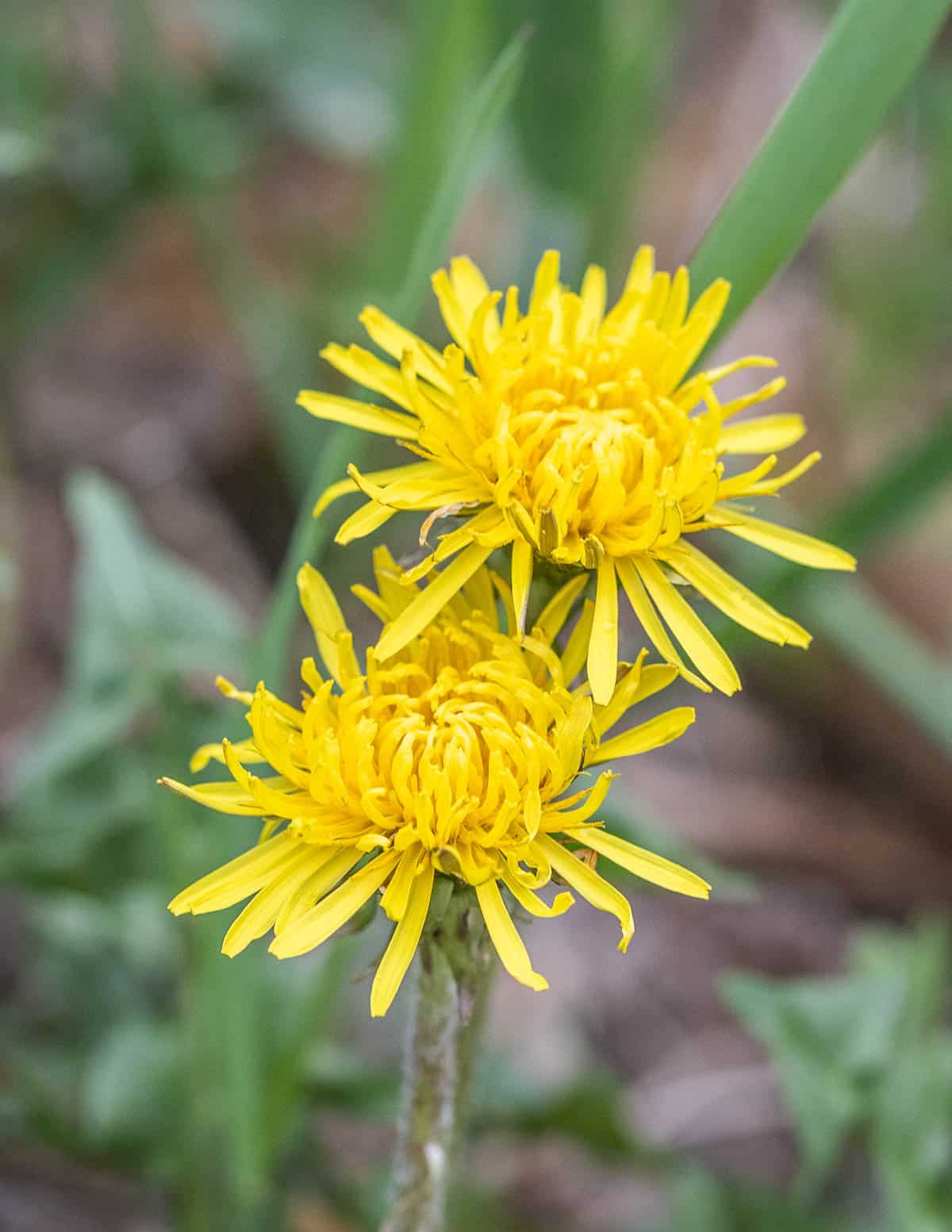
The petals can be picked off and used to make tea, syrups, and jellies. My friend, Chef Iliana Regan uses them to make a sunny yellow vinegar with raw honey she uses in place of lemon juice. Dandelion flowers appear in Mid-May.
White and Red Clover
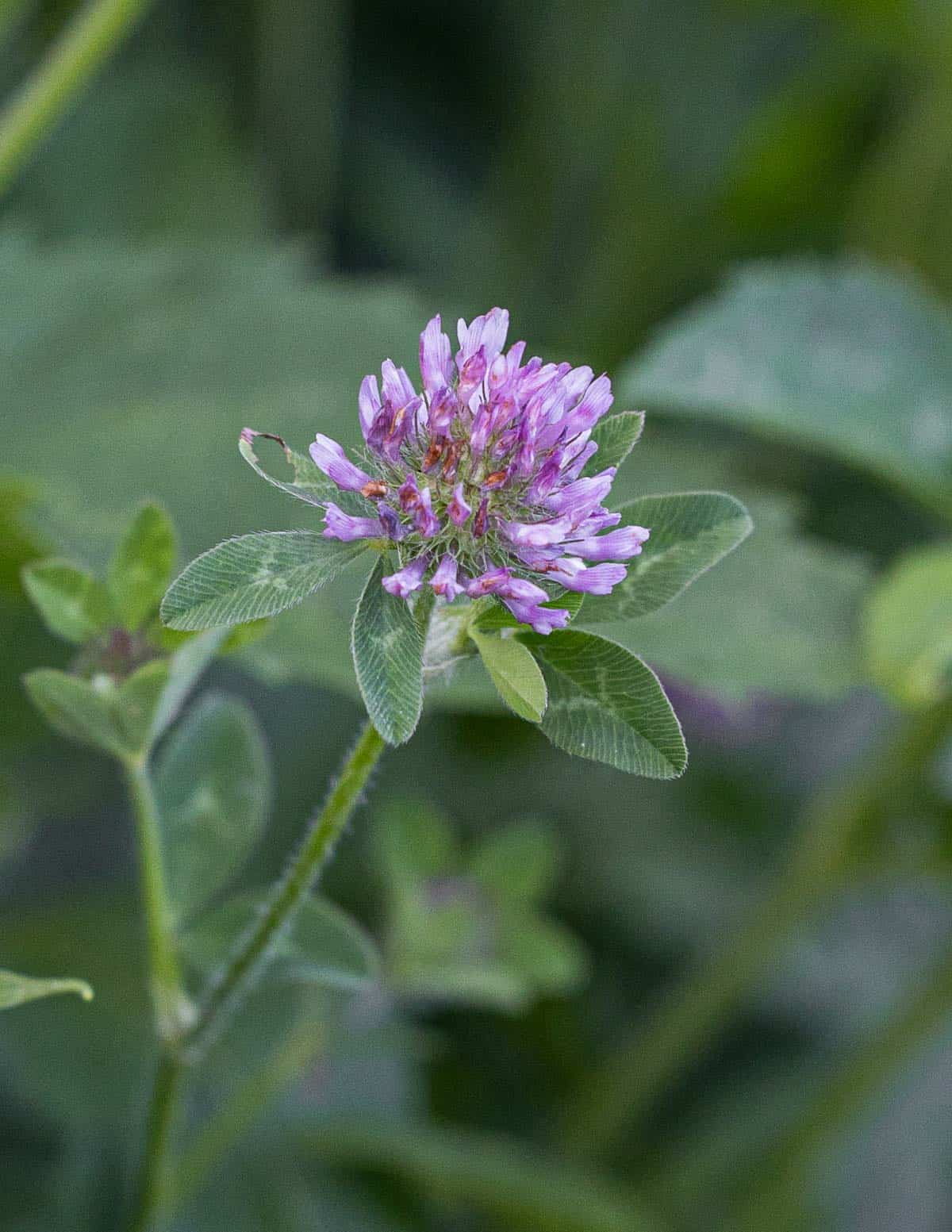
Red clover (Trifolium pratense) and white clover (Trifolium repens) flowers are a common plant of meadows and fields in June that's easy to identify for beginners. As they're nitrogen-fixing legumes, they can be used as a cover crop for rotational farm fields or in pollinator habitats.
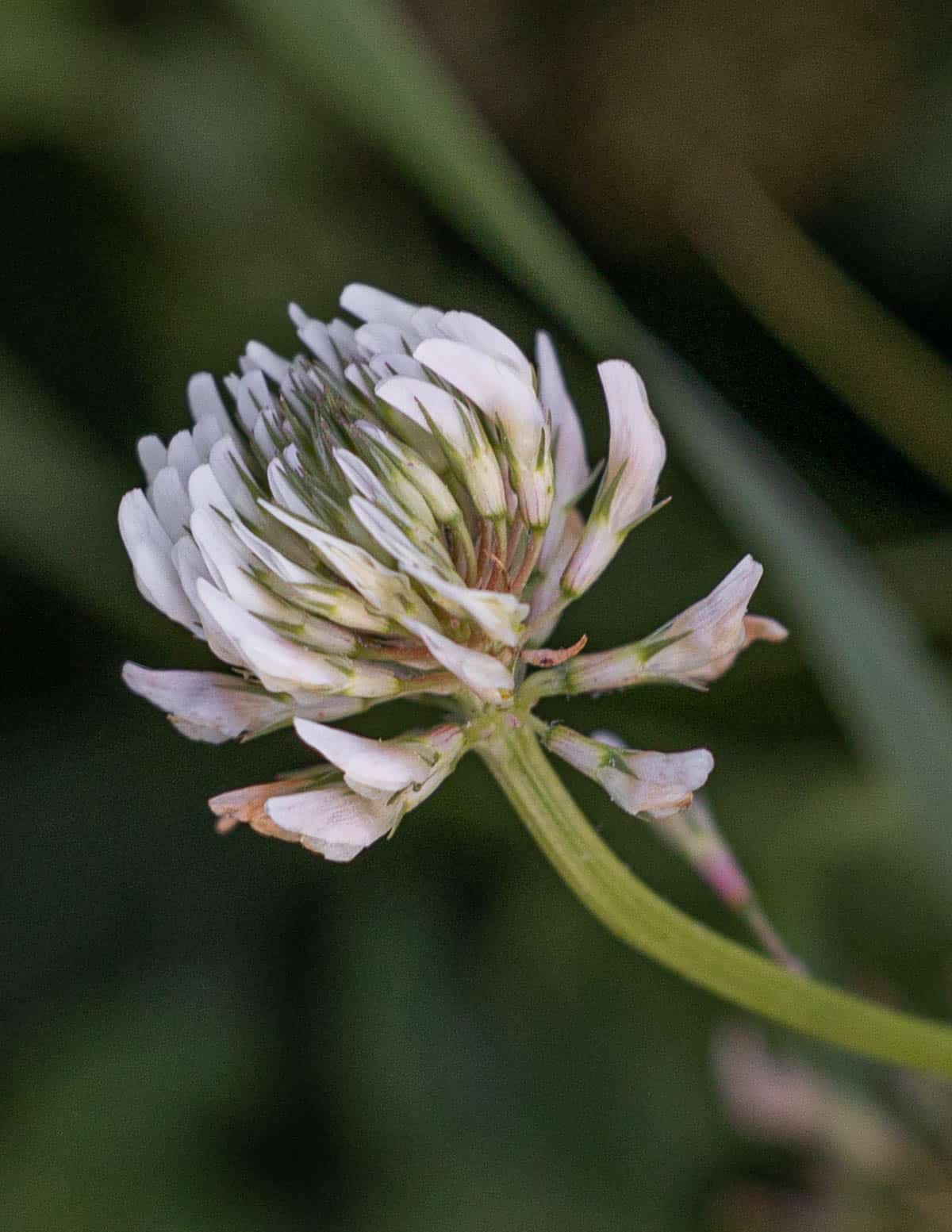
The flowers I find chewy and tough, but they have a good aroma and are great added to a tea blend or used in infusions.
Linden Flowers
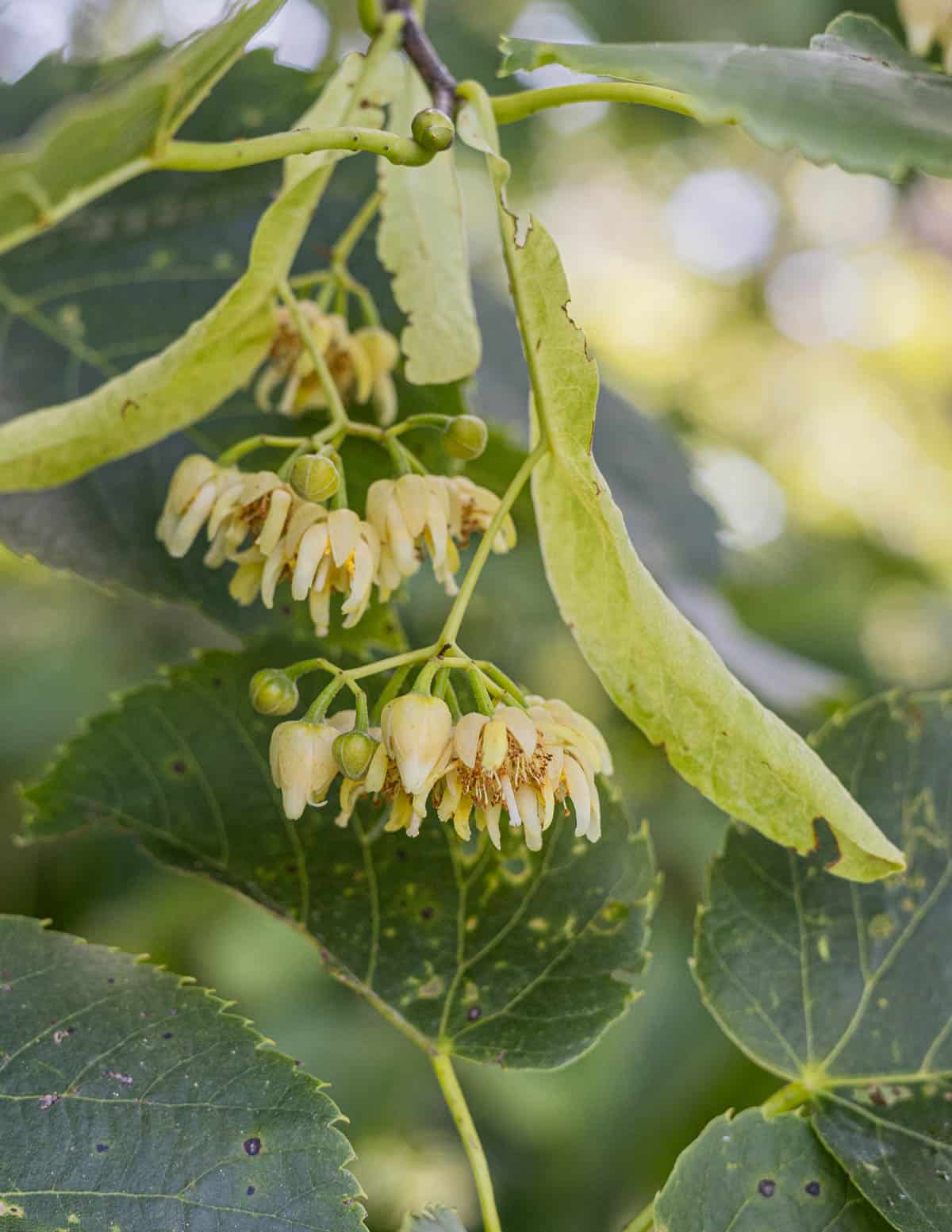
One of the few edible flowers that grow on trees, linden flowers have an incredible aroma I often smell before I see them when they're available in June. While you won't be tossing them in a salad, the flowers can be dried for tea and used to flavor liquors. Chef Jacques Chibois cooks them in a light syrup with fresh cherries.
The seeds are also harvested and roasted, combined with sugar and used to make a "chocolate" substitute. The young leaves of the tree are delicious added to salads when young and translucent.
Elderflowers

Famous as the main ingredient in the liquor St. Germaine, elderflowers (Sambucus nigra) are well-known in the wild food community. Their aroma I describe as sickeningly sweet.
The flowers can be dried for tea, and used to garnish salads and other dishes fresh, but are mostly used to flavor liquors like elderflower cordial and syrups. Look for them in July in disturbed areas and on the edges of woods.
Meadowsweet
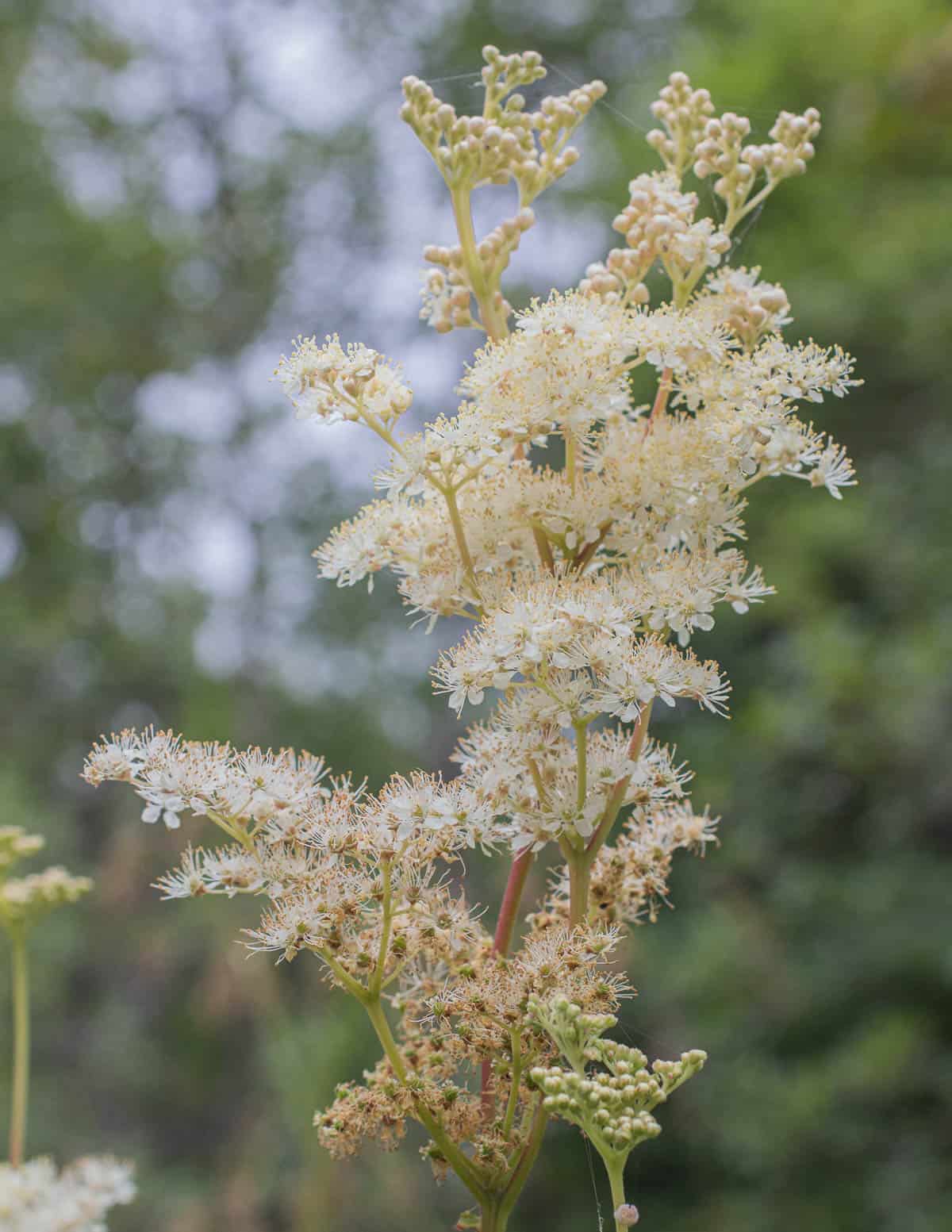
Basically unknown outside of Europe, meadowsweet flowers (Filipendula ulmaria) are incredible and superior to elderflowers in my opinion. The delicate blooms appear in mid-july. A plant in the rose family (Rosaceae) they share the almond flavor that many prunus plants have in their stones and seeds.
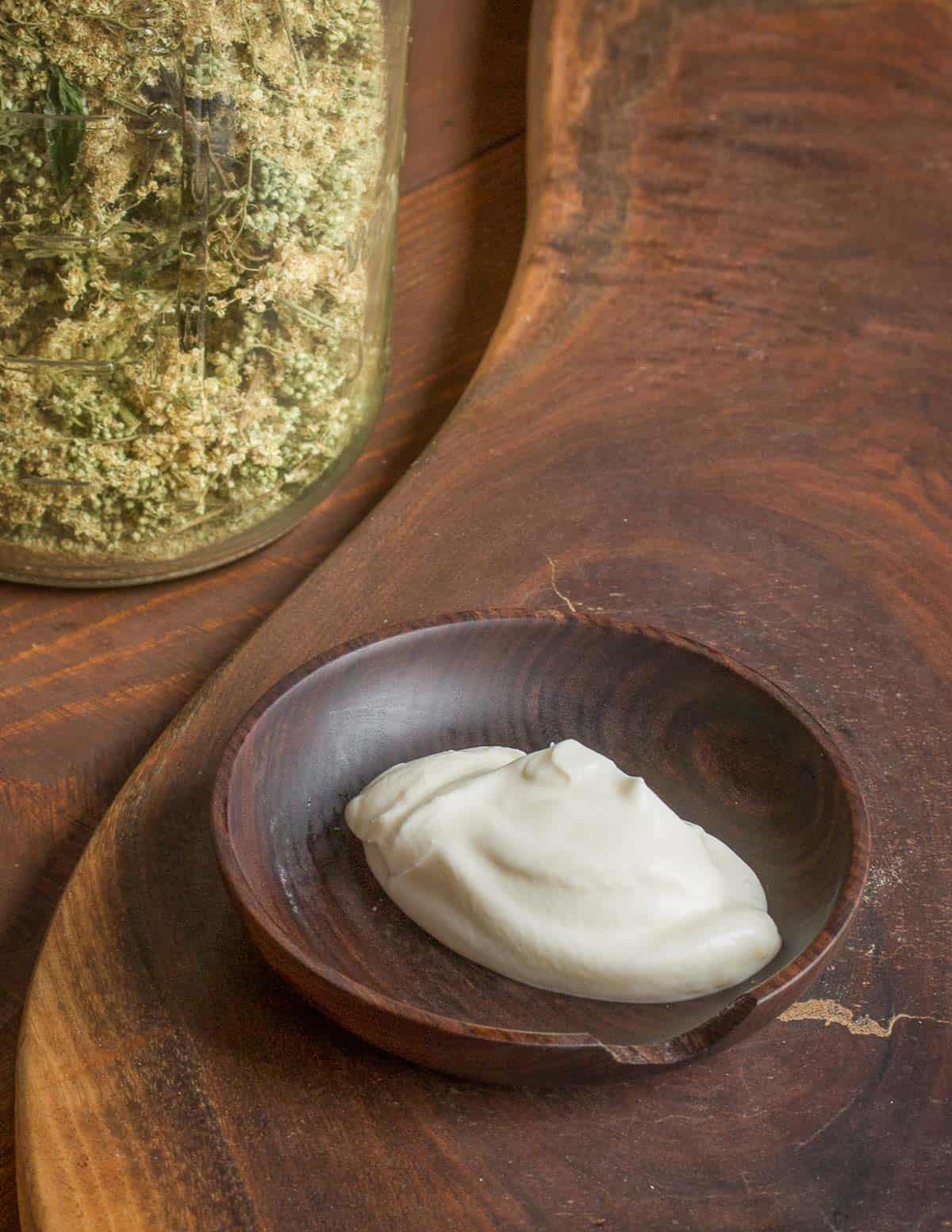
The flowers can be used fresh, but I prefer the concentrated flavor of the dried flowers. They can be used to lend an almond flavor to teas, cream based desserts like panna cotta, whipped cream and creme fraiche.
Comfrey
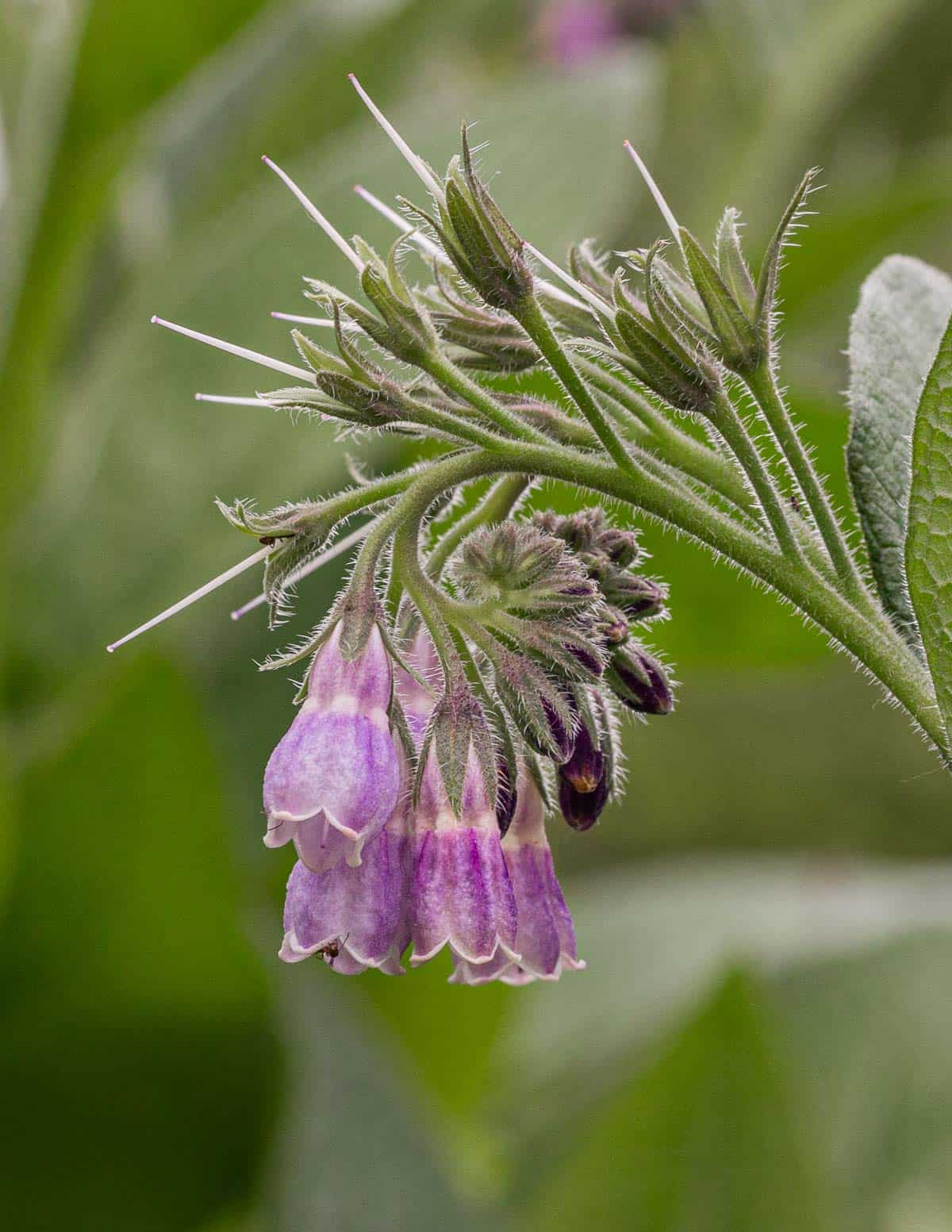
Mostly known as a medicinal plant that's great for pollinators, comfrey flowers (Symphytum officinale) are one of my all-time favorite edible flowers. A cousin of borage in the Boraginaceae, they're common in gardens, but I also see them escaped growing wild on occasion.
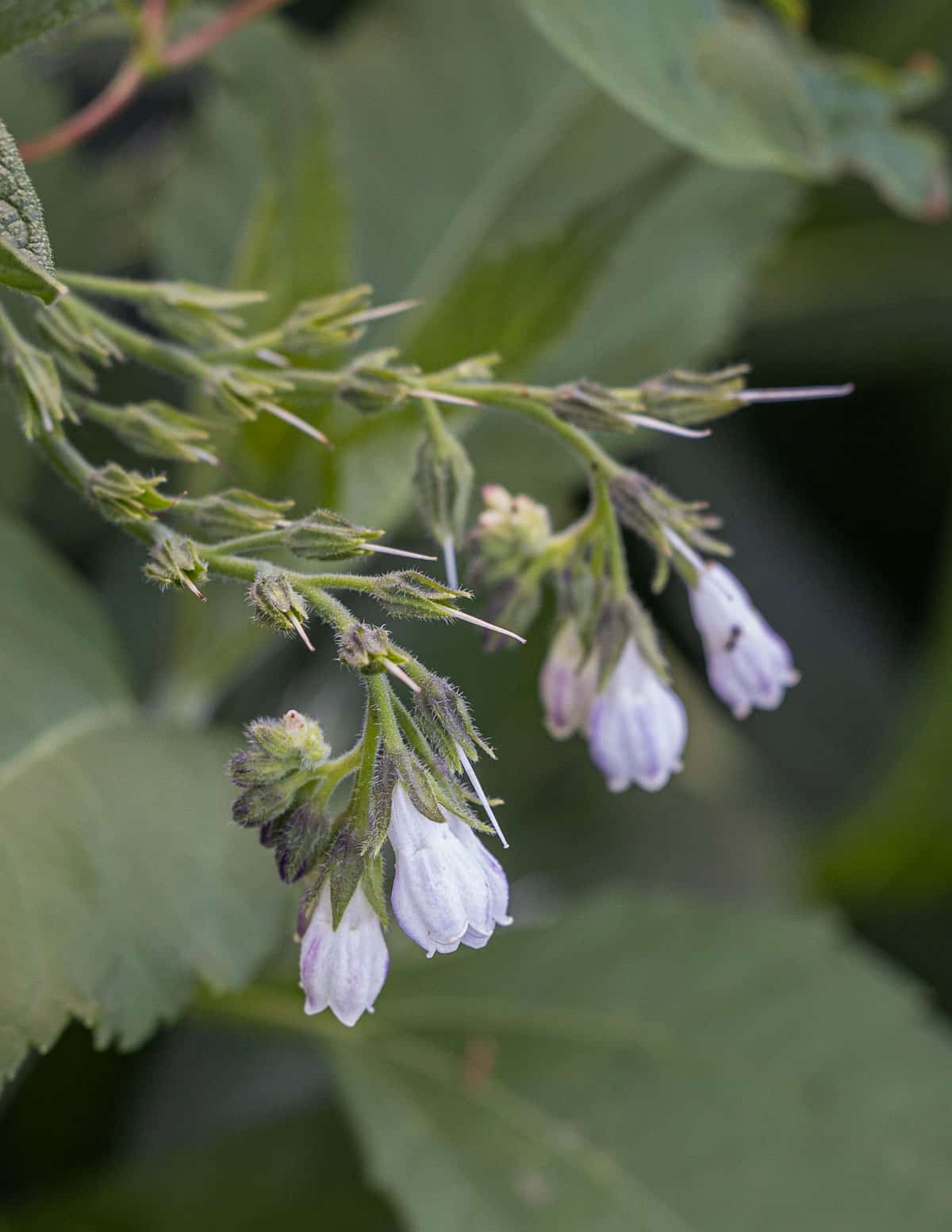
The greens can only be used in small amounts, cooked, and are found in some traditional Italian recipes. The flowers can be sprinkled raw on dishes in small amounts. I love them for their bright purple color and mild flavor reminiscent of cucumber.
Dames Rocket

A common invasive plant in the mustard family where I live, dames rocket (Hepseris matronalis) will seem to be everywhere when it's in bloom. The easily identified, four-petaled purple or white flowers stick out like a sore thumb on the side of roads and on the edges of woods.
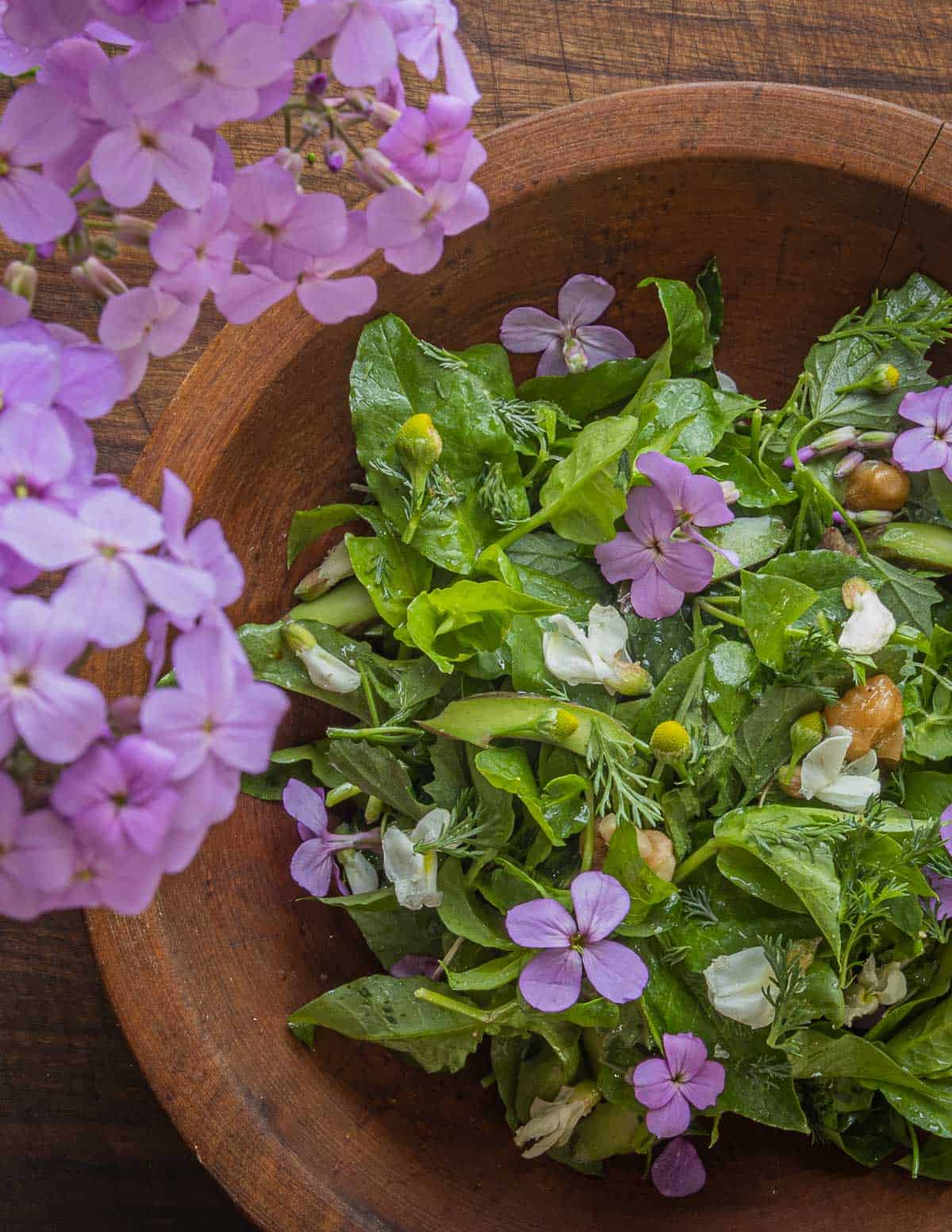
The have a spicy mustard flavor and are great used to garnish savory dishes like salads. Look for them in early June.
Phlox
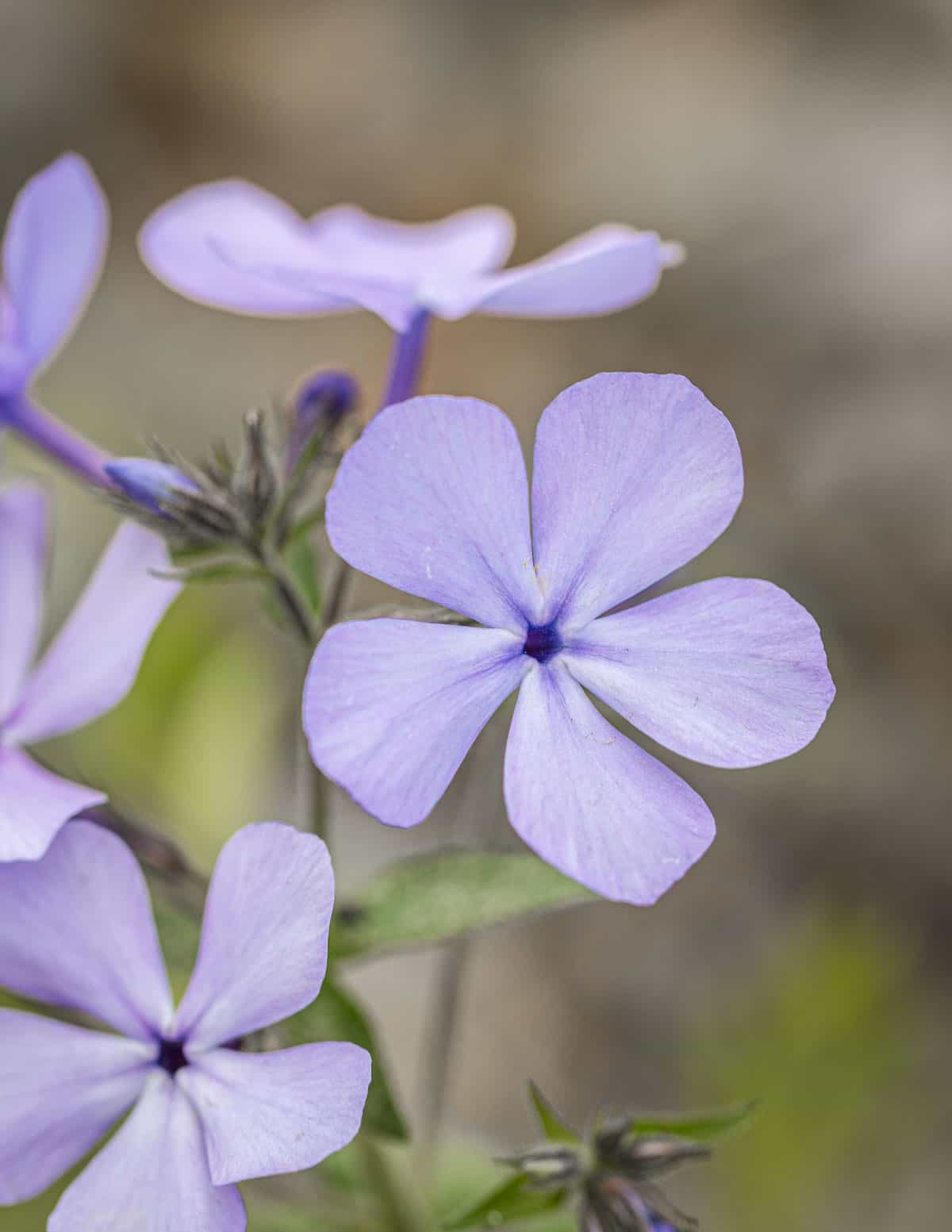
Garden phlox is often confused with dames rocket. Wild phlox (Phlox divaricata) is much shorter and I haven't ever seen plants grow past my knee. The flowers look very similar to dames rocket, but will always have five petals instead of the four dames rocket has.

They have a mild flavor and can be used to garnish both sweet and savory dishes. The flowers appear in late June.
Wild Mustard Flowers
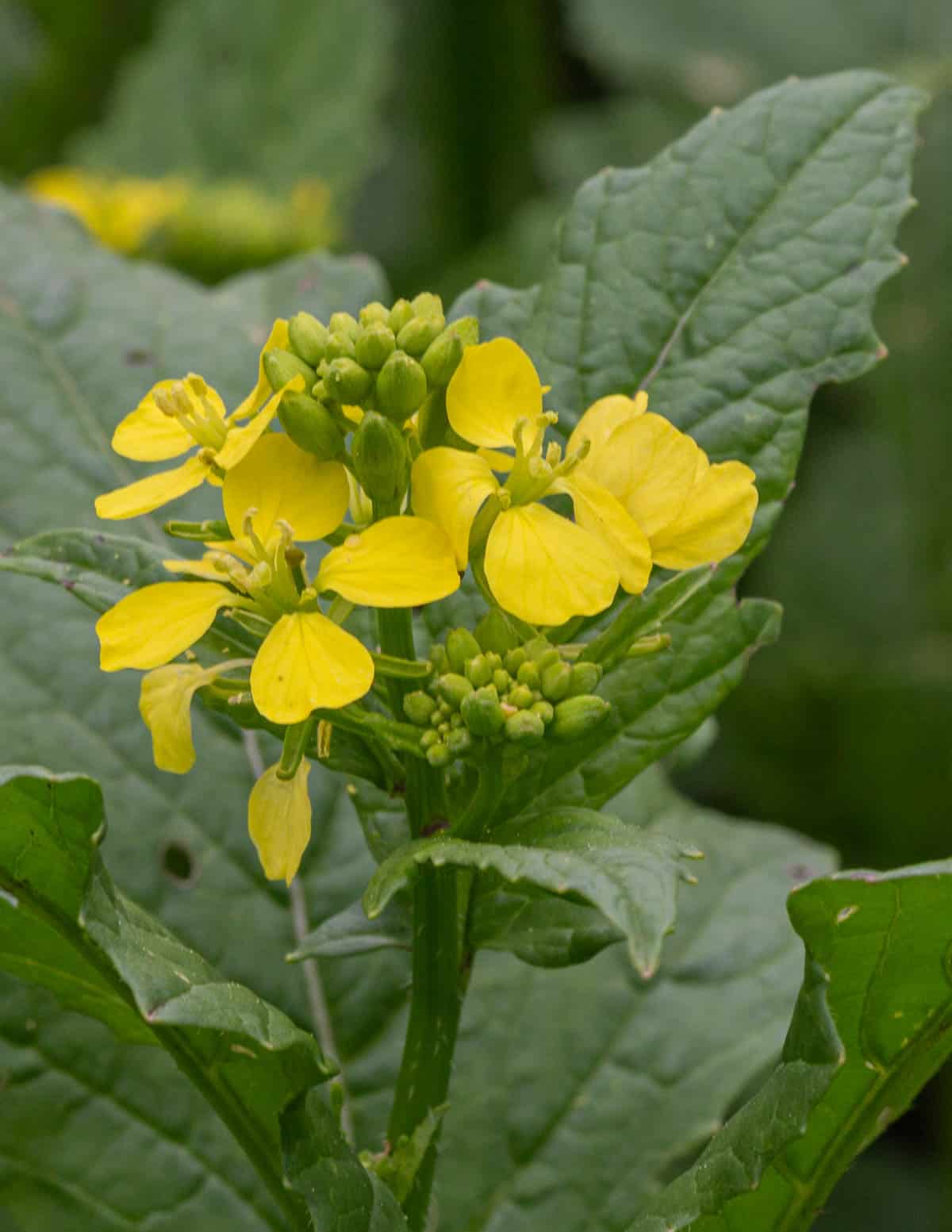
There's a staggering amount of wild mustard varieties available to foragers. All wild mustard flowers are edible, and most of them will be yellow. Like the leaves, mustard flowers will have a slightly spicy taste, with the intensity varying between individual species. The flowers can be gathered in large amounts and pureed with oil and salt to make a mustard substitute.
One of the easiest ways to tell a mustard flower is that the flowers will always have four sepals, located directly across from each other and forming the sign of a crucifix, which is where the name crucifer comes from.
Vetch
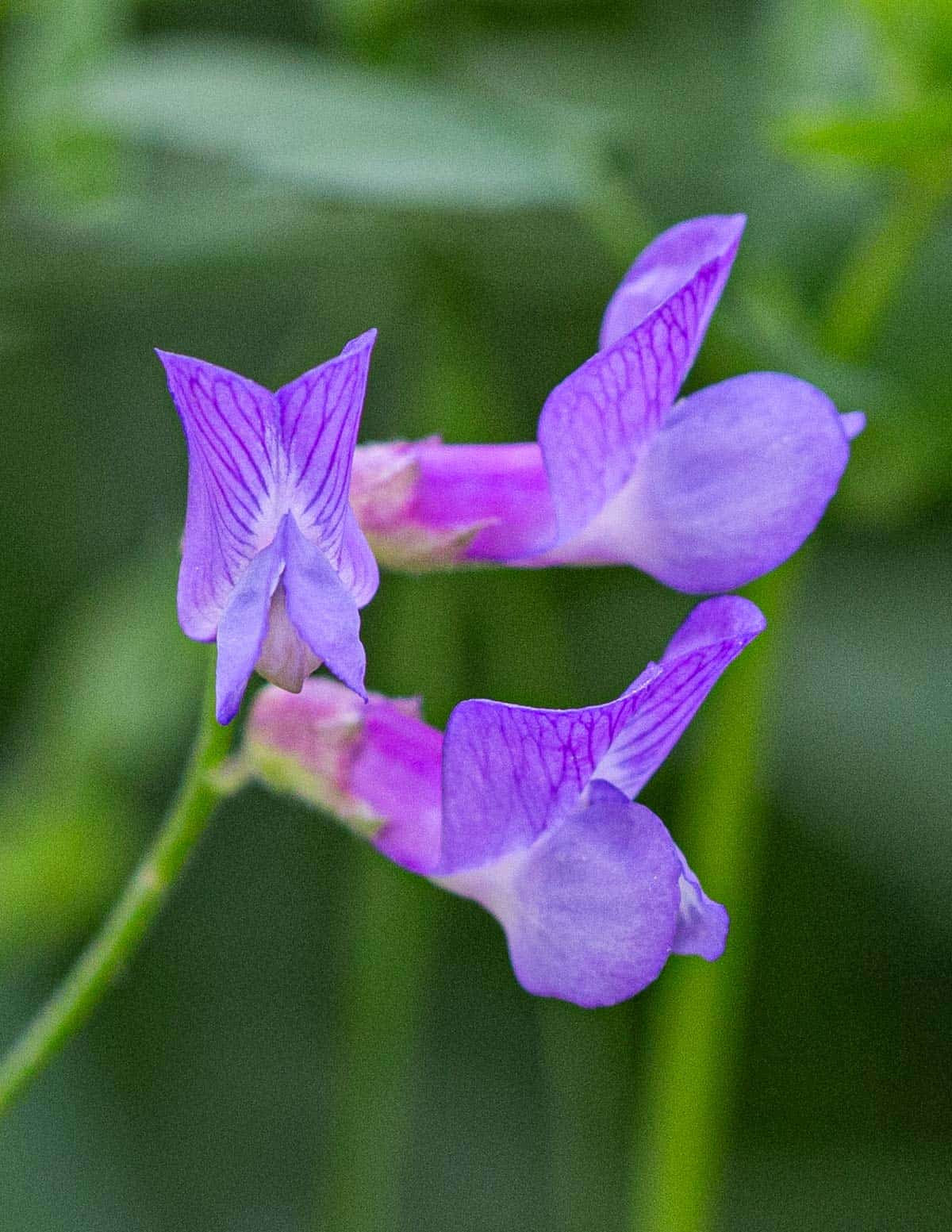
A native leguminous vine, vetch (Vicia americana) is relatively unknown in the foraging community, but the flowers and young tips can make a good addition to salads. It's a relative of peas, so the flowers resemble pea flowers.
Look for them in July. While some may say that this plant is poisonous, that opinion is probably caused by conflating livestock poisoning with humans. There will be no issues with this plant unless you eat, say, 5 lbs, or a cow-sized serving.
Beach Pea
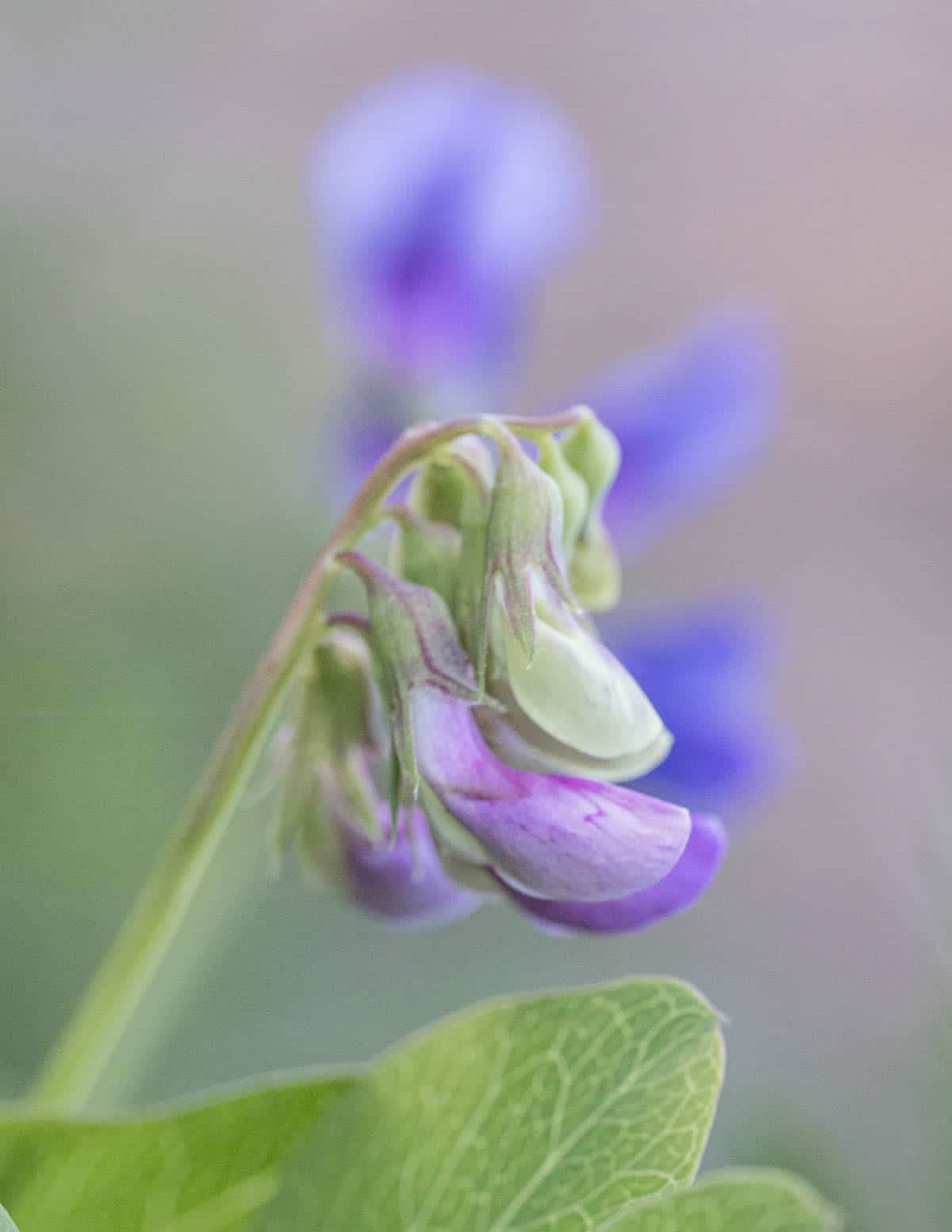
Another low-growing leguminous plant, beach peas (Lathyrus japonicus), as their name implies, like sandy soil near water. I see them mostly on the South and North Shore of Lake Superior.
They're similar to vetch in taste and form, but are larger and give you more bang for your buck. As a bonus, the plant also makes pods that house very small peas that can make a nice trail snack. The flowers appear in late July.
Purple Prairie Clover
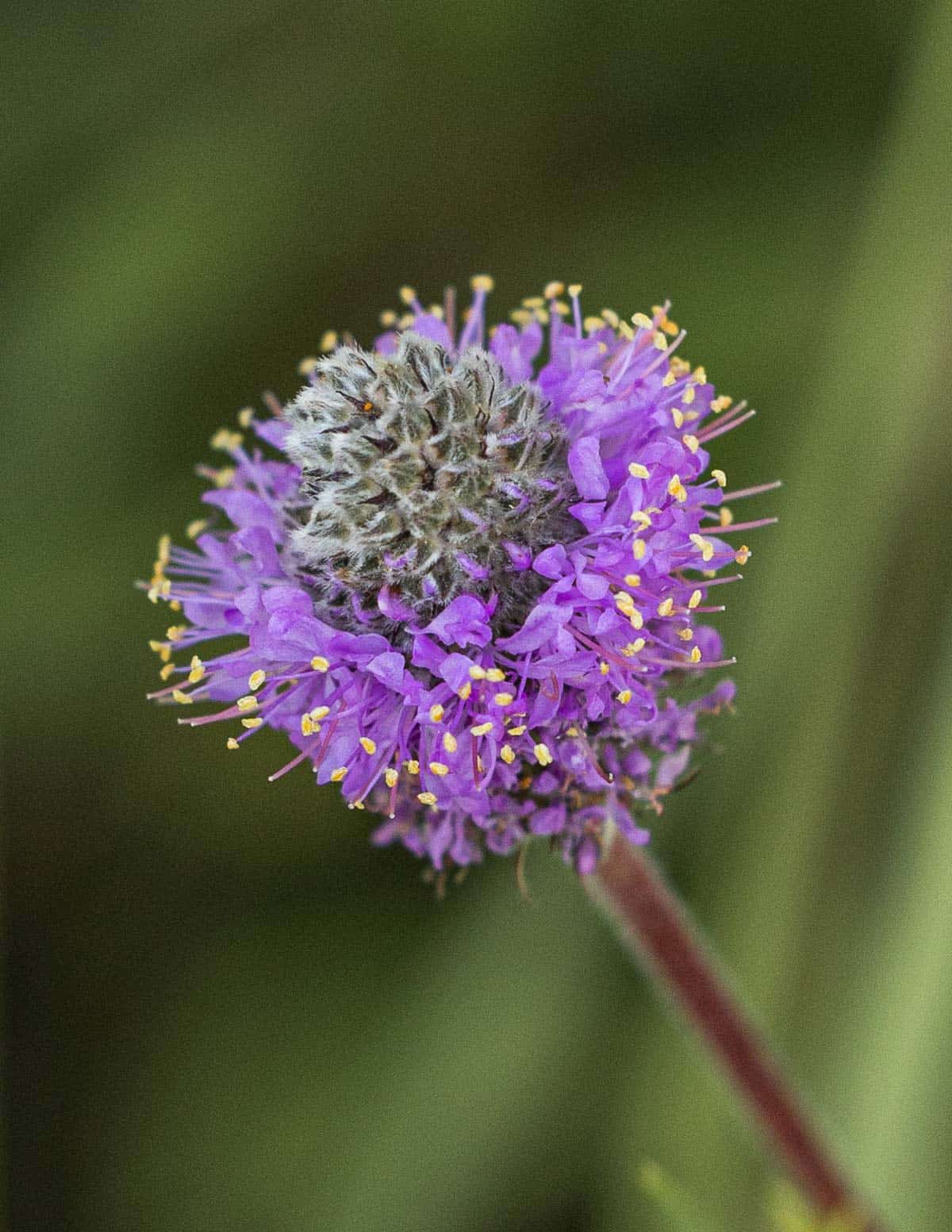
Most foragers who know it will agree purple prairie clover (Dalea purpurea) is the most delicious least well-known of the edible clovers. The gently fruity aroma has notes of orange peel and ripe fruit.
Like its cousins, it can be dried and makes excellent tea and drinks. Strip the leaves from the stem and dry with the flowers. The flowers appear in July.
Pinneapple Weed
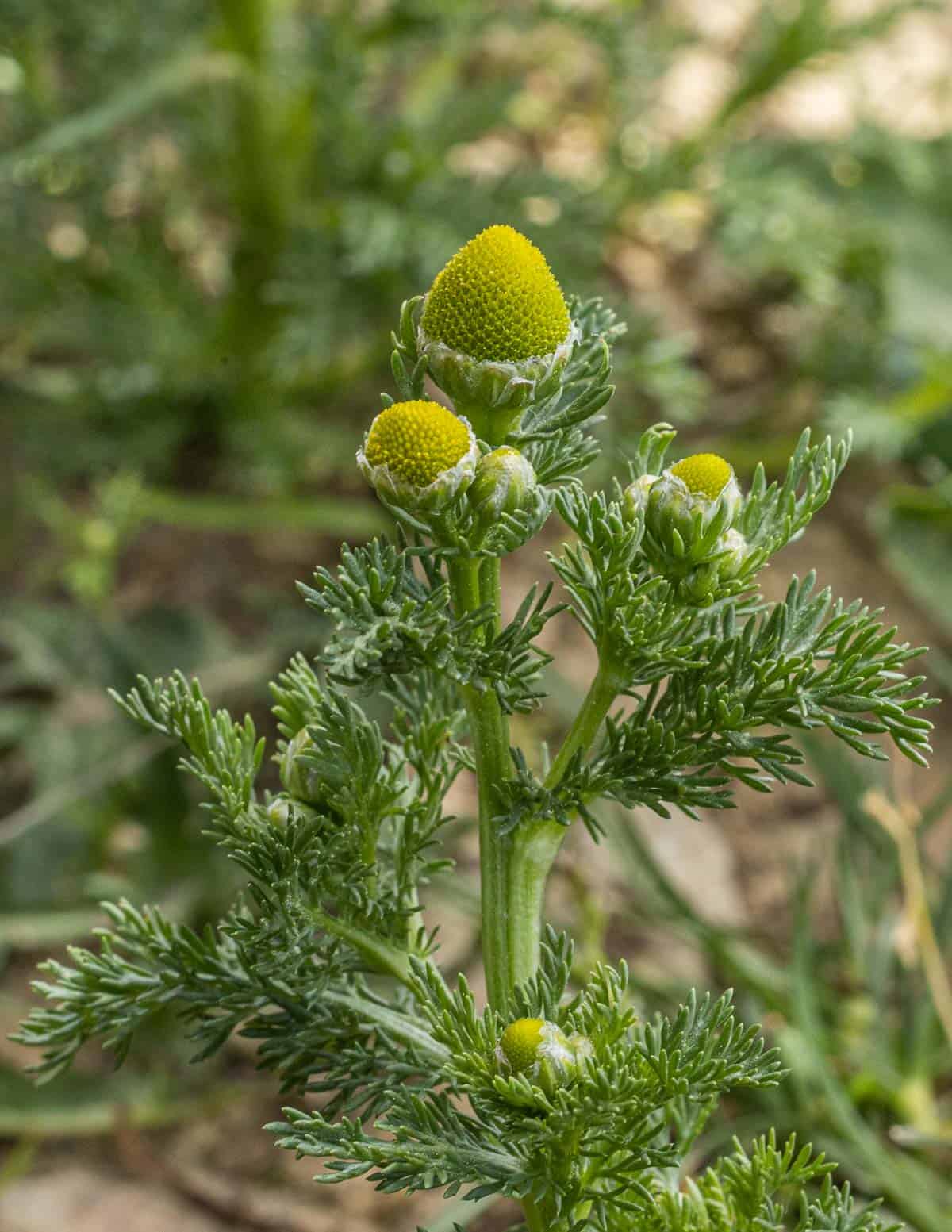
A common sight in the compacted soil of gravel driveways and parking lots, pineapple weed (Matricaria discoidea) has a taste and aroma reminiscent of pineapple. Some refer to the plant as "wild chamomille" which is technically incorrect, although both plants are interchangeable in recipes.
The small cone-shaped flowers are delicious eaten raw in salads or in relishes and quick herb salads for fish. Like chamomille, it can be used fresh or dried, or used to infuse alcohols and syrups. It makes excellent iced tea.
Wood Sorrel
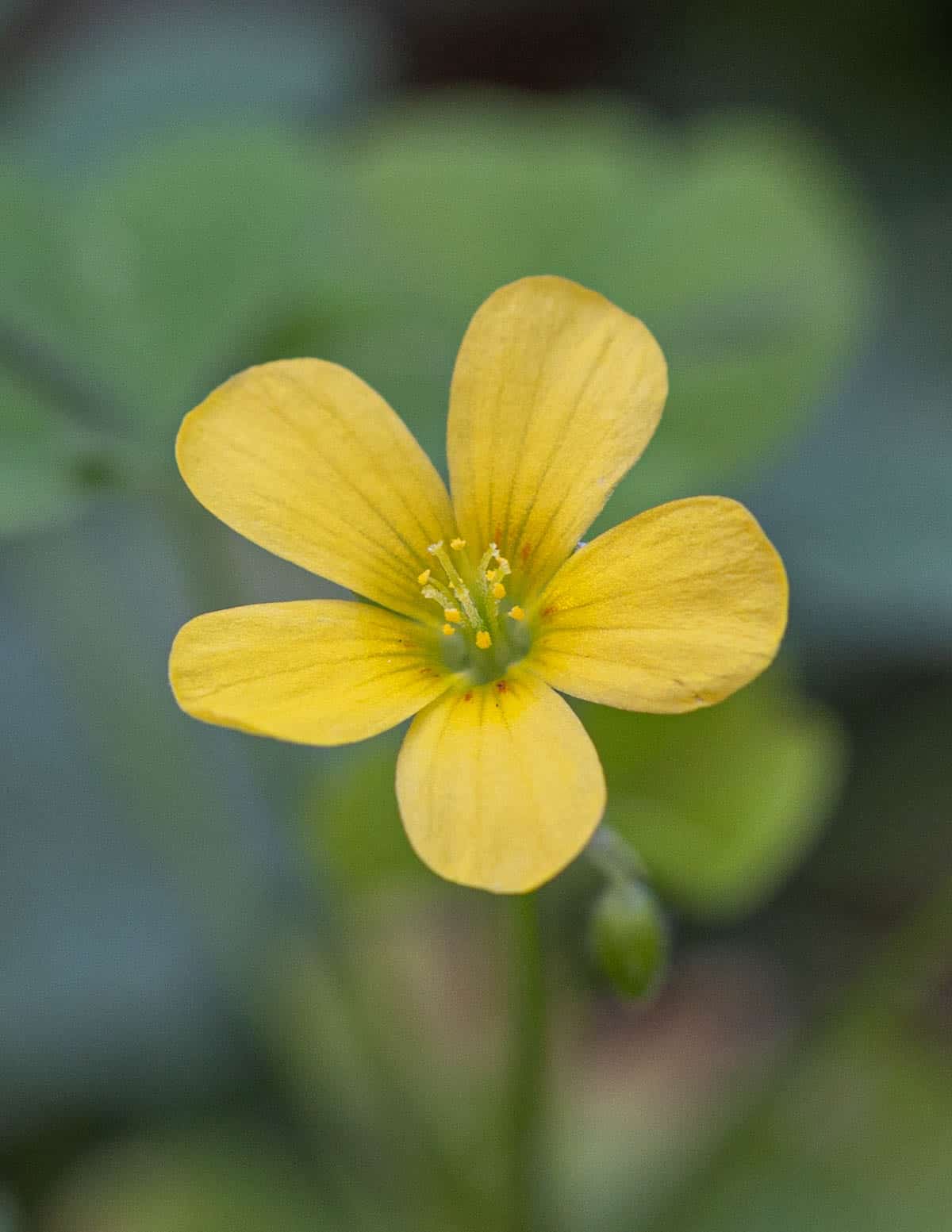
Wood sorrel (Oxalis spp) may be small, but the flowers can be a nice addition to salads and cold dishes. Just like the greens, they have a slightly sour taste, but are mostly for looks.
Smaller plants will make tiny flowers that are hardly worth harvesting, but larger plants will make larger flowers. Look around for the largest plants you can find. I like to roughly chop it or add it by the handful to dishes like soups and the mushroom salad pictured below.
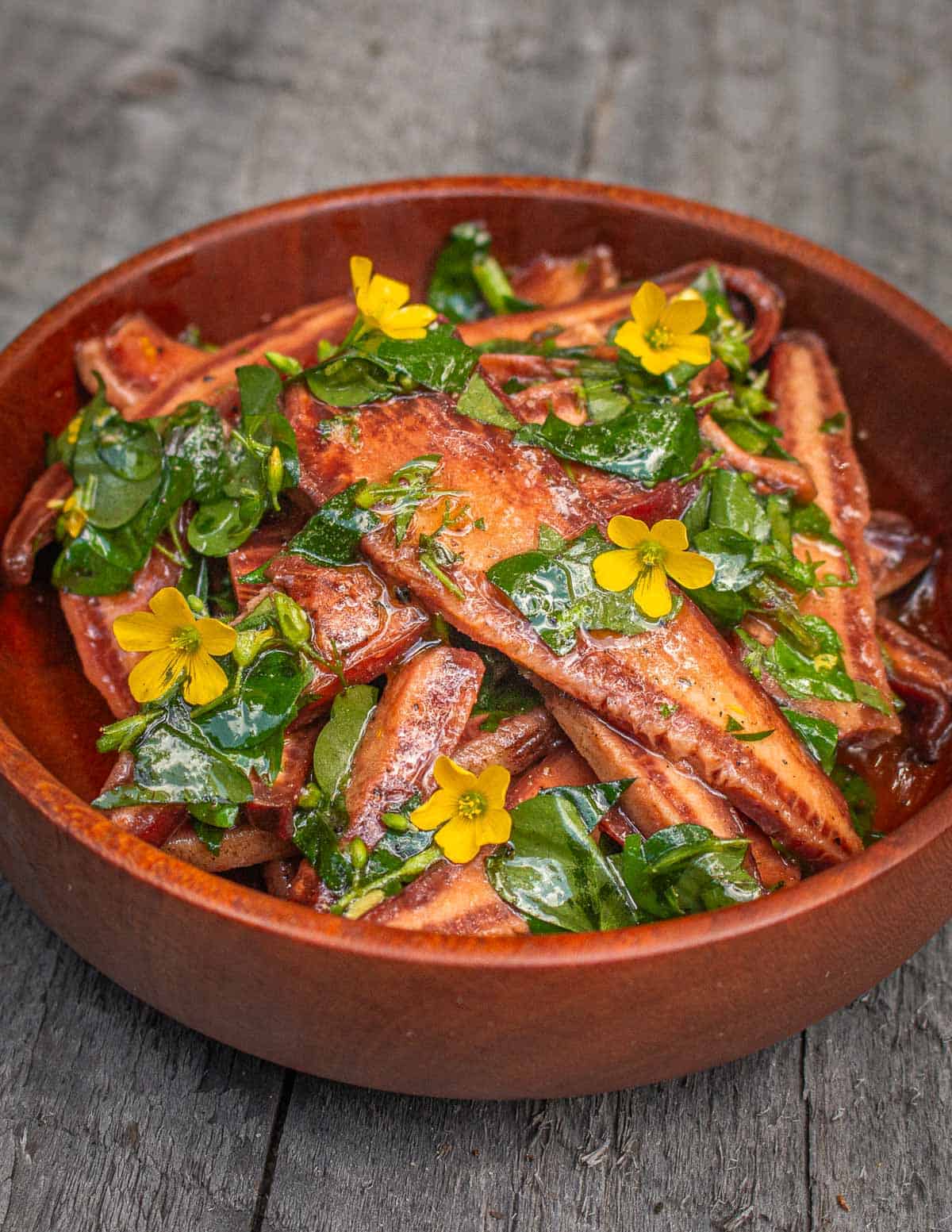

Tribal
I must object; flea bane is wonderfully hazel-nutty when steamed. (but who am I to chew on a chef?)
Researching, allegedly sunflowers are entirely edible; I've only eaten their leaves and stems all last summer. They're rough but slightly tingling-sweet tasting, at least to me. I haven't verified the root edibility.
Tulip tree flowers and leaves are claimed edible and the nectar is definitely drinkable.
Japanese barberry's sour leaves and flowers would be crazy to collect but the flowers are mildly sweet to my taste.
Mullein flowers are alleged poisonous, perhaps in case you'd like to eat the only non-hairy upper part.
And of course enjoy yew "flowers." The yew will thank you by eating you too! (when "unalive") XD
Thanks for confirming vetch is edible by actually eating it! (unlike most) Your hands-on experience assures my confidence foraging rumor-obscured things, like delicious black nightshade berries.
Alan Bergo
Sunflowers are absolutely edible, I write about them in my book: tender stems, young leaves blanched as wraps, unopened flowers cooked as artichokes, and my personal favorite: the unripe seeds where you can eat the immature shell and seed together. Chef Dan Barber cooks the stalks and serves them as "sunflower marrow".
Maryse Bédard
Hi Alan!
I’m surprised you haven’t mentioned sweet clover (melilotus officinalis). Here in Québec, we can find both the white and yellow varieties along roads and in meadows. It is often considered as our boreal vanilla. Farmers sometimes sow their fields with sweet clover to fix nitrogen in the soil or use it as a "green" fertilizer.
After reading your article about Galium odoratum, I guess it has pretty much the same kind of flavour, since it also contains coumarin.
Thoroughly dried (it can develop a toxin if not properly dried), sweet clover is delicious in savoury dishes, especially with fish and seafood, or in a basmati rice (Yum!). It can also be made as an extract, to be used in any dessert that calls for vanilla.
Cynthia
Wonderful, very informative. Some that I knew; many new ideas.
Thank you!
Alan Bergo
Thanks Cynthia. I'll be updating it this year with a few more too.
EMC
This was so much fun to read through!! I can’t wait to try some new ones!
It did make me think of something though… the autumn olive blossoms smell soooo good, and we get a ton of those. I know the berries are edible, but are the flowers, do you know?
Just found your site today, so I’m having a blast browsing. Thanks for sharing!
Alan Bergo
Thanks EMC.
Erik
Allergies/sensitivities are always a potential issue with any new food, but I have eaten small numbers of flowers from evergreen, autumn blooming oleasters (Elaeagnus pungens and E. x-ebbingei) raw, without issues. They were sweet and continued to give off the gardenia-esque aroma that my nose catches when not eating them. I think they would work well as a replacement for Gardenia in scenting green or black teas, though the oleaster flowers are tiny, so might be fiddly to harvest (I also like the drupes, so am less inclined to prevent their formation, though for a weed species like autumn olive (eastern North America) or "Russian " olive (dryer climates, like western North America), that might be entirely desirable!
Julie Weisenhorn
Thanks for the list Alan. Do you have this printable somewhere? I am a hort educator with Extension and working on The Foodscape, a new landscape at the MN Landscape Arboretum that celebrartes the beauty of food plants in a home landscape. Am thinking of adding some of these expecially the garden-type plants.
Alan Bergo
I don't have a printable list. Interesting that the Arb is doing something like that. They reached out to me a few years ago but then seemed to get scared after the book Tales From a Forager's Kitchen was recalled and just ghosted me. Was too bad.
Julie Weisenhorn
Hmm. Unfortunate indeed. I will email you directly about some ideas I have. I think the garden flowers are a little "safer" for the Arb as they are better known to individuals. FYI just ordered Sam Thayer's books and have really enjoyed you book and discovering this site!
Alan Bergo
Thanks Julie.
Shodo Spring
This is fabulous! I've eaten maybe a quarter of these (some regularly) and have intentions on many more. But nearly everything on my land seems to be edible. One small concern: angelica and wild carrot can be confused with the deadly poison hemlock. Might you put a warning note?
Joe
Trout lily are a state and federally endangered species in Minnesota (the dwarf trout lily at least, not sure if there are others), so I'd recommend removing it from the list and giving people the impression that they should or can pick it. Awesome exhaustive list though!
Alan Bergo
I added a note about Erythronium propullans in MN, and thank you-I should've mentioned it and I forgot. The others are common and not threatened at all. I've never seen E. propullans personally. Too many chefs and friends of mine in the States and Europe enjoy the widespread, common trout lilies to warrant removing it for the sake of a few people that don't know how to identify it imo.
Jenny Boldt
What a wonderful list of edible wildflowers! I am always looking for ways to entice my 4th grade students to learn things in outdoor spaces. We are fortunate to have a School Forest adjacent to our school grounds, so we use the space to learn about things like maple sugaring, sampling jellies made with wild violets and dandelions, and finding and trying ramps.
I really enjoy reading your articles. I always find something new and fabulous. Thanks for what you do!
Alan Bergo
Thanks Jenny. I wish I could've gone to a school that had a woods next to it.
Barbara Warner
Me too. It should be a required class in every school.
Joy
I appreciate your list--I tried comfrey flowers this spring because of your recommendation--loved them! I also enjoyed making violet jelly (SOO pretty and delicate in flavor), elderflower cordial, and honeysuckle jelly along with syrup that I use in place of honey for tea and greek sweets! Thanks!
Alan Bergo
Thanks Joy.
Sam
Impressive post!
I was thinking about the tree flowers. Have you tried Norway maple flowers?
Alan Bergo
Those I haven't. Thanks for the suggestion.
Lauren
What a wonderful piece - I have so many of these plants in my garden and I never thought of them as beautiful and edible! Thank you.
Alan Bergo
Thanks Lauren.
Bonny
Great information but your photographs are outstanding.
Alan Bergo
Thanks Bonny. A lot of work.
Crystar Strempke
Love your informative posts! Great pics too! So first year of Covid, we were pickling and I decided to try pickling things I had not previously . Dandelions are the unexpected and we LOVED them . So odd I thought no one had probably tried this method to store them lol …. Nothing new under the sun! They tasted exactly like capers! I used dill and garlic when picking them and they made a great “tartar sauce” -I was out of pickles and cucumbers and dill but wanted tartar sauce to go with fish that night -so I fine chopped some sweet onion added a couple tablespoons of the pickled dandelions and added mayo… voila delicious we also LOVE wild sorrel
I’m going to try the violet syrup thanks again
Alan Bergo
That sounds delicious.
Dean Sherwood
You left out the whole of 𝘋𝘪𝘢𝘯𝘵𝘩𝘶𝘴.𝘋𝘪𝘢𝘯𝘵𝘩𝘶𝘴 𝘢𝘳𝘮𝘦𝘳𝘪𝘢 (Deptford pink) is small, but big on eye-catching appeal. As far as I know the whole genus is edible.
Alan Bergo
Thanks Dean. I wasn’t familiar with those.
Erik J.
Being in Minnesota, you are missing a lot of regional plants from hotter climates. Yucca and Malvaviscus arboreus (Turkscap/sleepy Hibiscus: TX, and into Latin America) and Salvia greggii (possibly other native red Salvias but NOT S. coccinea; S. microphylla from Mexico is better since the foliage can be used in tea; S. greggii has great flowers but the foliage has skunky + sagebrush notes to my nostrils and lacks a history of use so far as I know) imediately spring to mind. Nelumbo lutea (American water lotus) is habitat (freshwater aquatic) specific, but virtually all parts are edible (this does get into MN and you may have covered it elsewhere). Cardinal spear, Erythrina herbacea, has flowers that can be cooked into eggs (losing their color though) however the rest of the plant (especially the pretty seeds) is deadly toxic. I suspect the flowers of thicket bean (Phaseolus polystachios, which gets at least as far north as IL) and Apios americana (hopniss, American groundnut) can be eaten like related bean or cowpea flowers, but this needs further research. For some reason the Brits (but not, so far as I am aware, Natives nor southern Americans for whom the tree is native!?) pickle the petals of Magnolia grandiflora (bullbay, "Southern" magnolia), making a chutney that has cherimoya aromas. The invasive Morrenia odorata (latex strangler vine, a climbing milkweed from south of the Amazon perhaps into northern Argentina) can be used similarly to Asclepias syriaca (which needs longer winters than Florida provides).
I tried adding Virginia waterleaf to a garlic mustard pesto and had to run to the toilet. I think this is just me (a food intolerance, yellow at least daylilies also do this to me). However because some taxonists lump the Hydrophyllums into the Boraginaceae family (which also includes Mertensia and comfrey, which you list, I'd really like to see a complete chemical analysis of those (well, maybe just the Mertensia since I already know my body doesn't like Hydrophyllum and will NOT take comfrey internally) to screen for pyrolizidine alkaloids. I don't want to (usually slowly but in this case irreversibly) kill my liver. I live in an urban h3llhole, so I need a healthy liver.
Alan Bergo
Hey Erik. Lots of good info there, thanks. I've heard Sam mention the Turkscap mallow and I'm dying to try it. I also haven't had the magnolia flowers yet, or the hopniss.
Scubadiva
How about my grandkid’s favorite, pineapple guavas! Tastes like cotton candy!
Steve Hoffman
What a fantastic and exhaustive list. You are one of a kind, Alan.
Alan Bergo
Thanks Steve. I thought of Mary Jo putting it together. There's a few I still need images of.
Mary Alyce Kronzer
Okay - now I'm going out in the woods and pick some yummies for my salad tonight. I have a lot of these around my acreage.
Thanks for the interesting information.
Alan Bergo
Thanks Mary.
Tammie Lee
This is a wonderful post. Thank you so much for this info. There is something precious and divine about eating flower petals.
Alan Bergo
Thanks Tammie Lee. Agreed.
Hannah Helm
Loved this article! A lot of these plants grow on my land and I've been missing out. Since I'm not big on sweets like jellies, I prefer to harvest violet and dandelion flowers and use them to infuse vinegars. Redbud flowers are good sprinkled on salads. I haven't tried it yet, but Euell Gibbons loved making fritters with locust blooms. My favorite way to consume dandelion flowers is dip the flower head into whey or egg white, then coat with a seasoned cornmeal flour mix and fry. I also pull out the dandelion petals and use them to make cookies. I always enjoy reading your posts and learn a lot.
Alan Bergo
Thanks Hannah.
Megan Burt
Amazing list of edible flowers!
Alan Bergo
Thanks Megan. I'll add to it in time.
Gary Nichols
Great post! I recently started eating box elder flowers. They taste like peas.
Alan Bergo
Hey thanks I’ve never thought of those!
Ellen
Great post with wonderful photography. And a few edible flowers that are new to me. Thanks!
Alan Bergo
Thanks Ellen. There was a few other ones that are really fun I didn't have images of. Maybe next year.